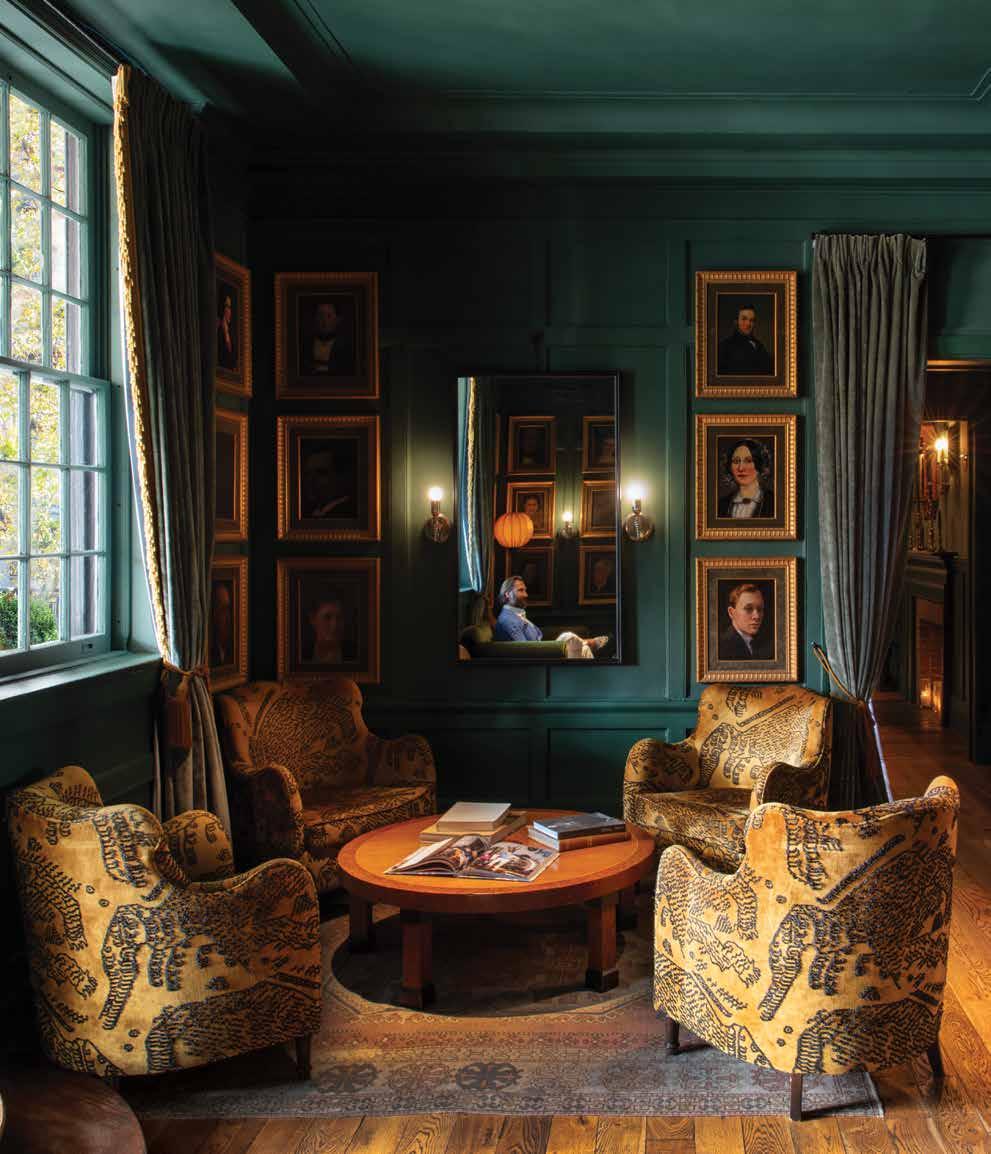
VOLUME I
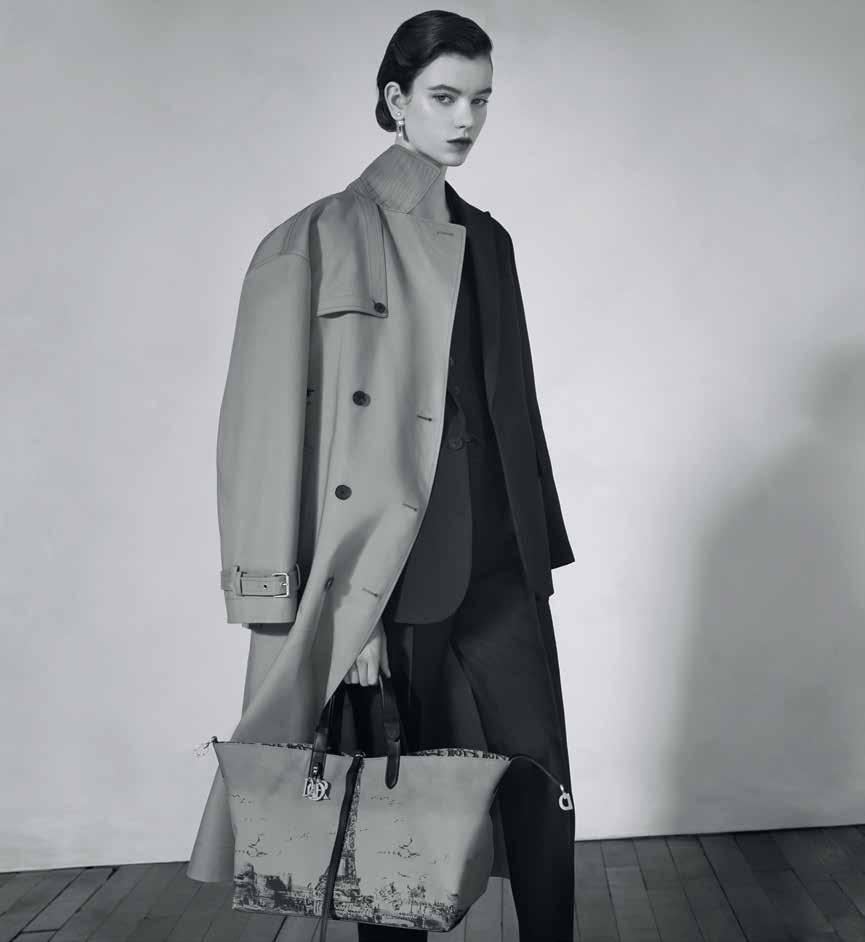
2 DIOR.COM –800.929.DIOR (3467)
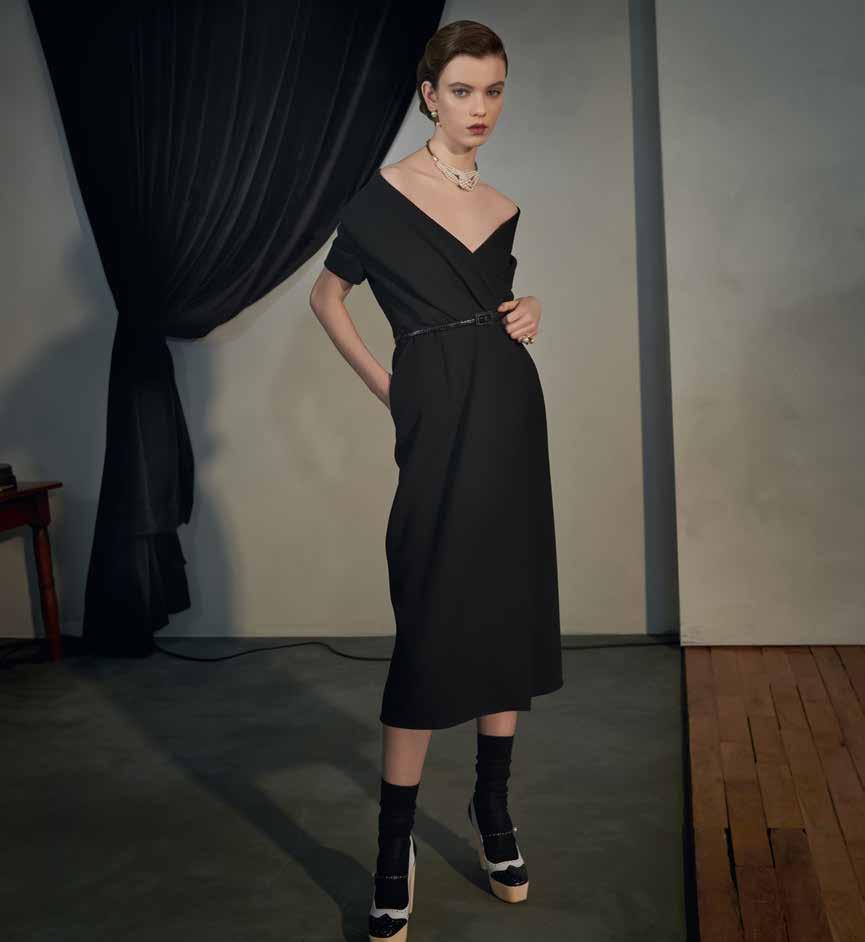
3




6

18
The Horse Thief
How one animal changed the life and work of The Lodge at Blue Sky owner Barb Phillips.
40
The Art of the Wave
Native Hawaiian surfboard maker
Brandan Ahuna is reviving the Sport of Kings for the surfers of tomorrow by looking to the past.
VOYAGE
54
Nick Mele’s Newport Wonderland
View the charming seaside town through the unique lens of the talented photographer.
68
A Portrait of SmallTown Splendor
How a corner of the Connecticut countryside captured the hearts of everyone from Wes Gordon to the de la Rentas with its abundant array of dining destinations and unique locales.
76

The Creative Soul of Santa Fe
With an influx of artists and entrepreneurs, the relaxed, tony capital continues to reimagine itself.
SAVOR
88 The Opulence of Edible Gold
The best sweet, briny, buttery delicacy in the world, uni, can be found in the Santa Barbara Channel.
104
Ancient Roots, Modern Intrigue
From raicilla to sotol and distinctive gins, a diverse array of delectable liquors will make you say “Move over, mezcal.”
118
Dining Above the Clouds
How Colorado became a worldclass destination for Epicureans.
BESPOKE
134
Crafting Luxury
From custom dining tables to unique textiles, artisans are building lavish furniture in the Hudson Valley.
144
Amanda Lindroth’s Timeless Style
The interior designer’s work at The Dunlin on South Carolina’s coast exudes the alchemy of design.
156
Utah’s Architectural Gems
From Versailles-style glamour to modern hideaways, the state’s top design creatives embrace the unexpected.
164 Unexpected Napa
The finest and rarest handmade bikes and tranquil escapes on the planet are in California’s elite Wine Country.
ESCAPE
176 At Home with Auberge Luxury residence owners from two one-of-a-kind resorts offer an intimate glimpse into the Auberge lifestyle.
186
Experience the World of Auberge Extraordinary stays, exceptional cuisine, wellness journeys and transformative adventures await at Auberge properties across the globe.
200
Last Call
Learn to craft the iconic ‘Horse Thief’ cocktail served at The Lodge at Blue Sky and inspired by the lengendary story of Barb Philips and a horse named Gracie.
8 TABLE OF CONTENTS
CONNECT
About the Cover
The Vanderbilt, Auberge Resorts Collection.
Photo by Nick Johnson.
ti-ceramitechtm case
3-day automatic
500 m water resistance

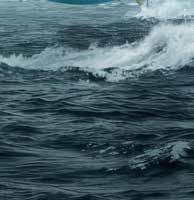
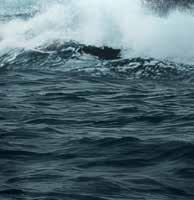








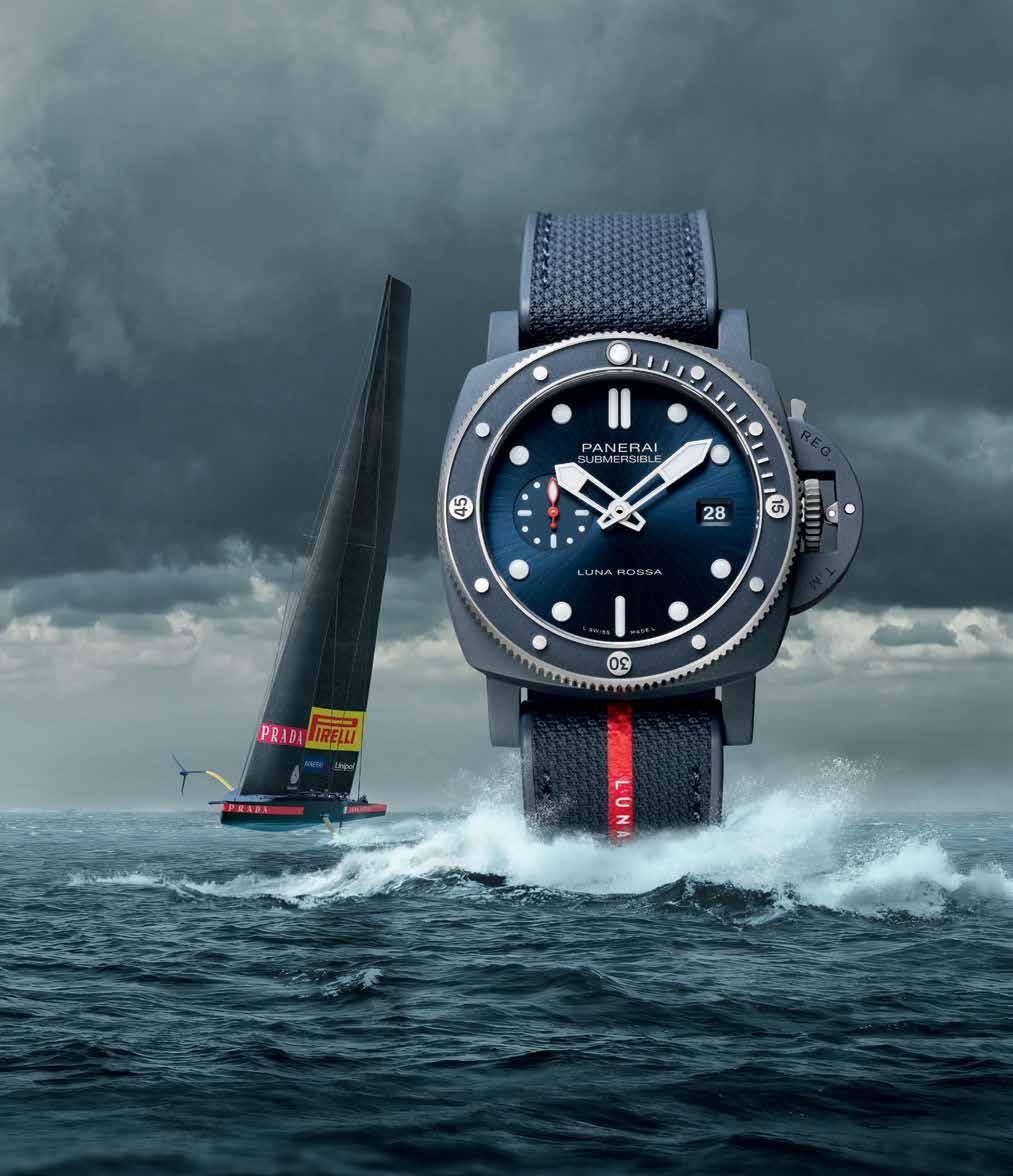 Join the World of Panerai
Join the World of Panerai
Discover the world of Auberge and encounter new seasonal stories and films online at aubergeresorts.com/stories.


Barb Phillips and the Saving Gracie Equine Healing Foundation are doing intensive, meaningful work “One horse at a time.”

Watch as surfboard shaper Brandan Ahuna goes from tree to sea, making alaia—finless Hawaiian boards made of wood—a tradition which spans thousands of years.
What makes sea urchin in the Santa Barbara Channel the world’s best? Find out from the divers who harvest it, the markets that sell it and the chefs who serve it.

DINING ABOVE THE CLOUDS
Explore the delicious bounty of Colorado’s burgeoning food scene, where some of the best chefs in the world are keeping it hyperlocal.
10 AUBERGE STORIES
Follow
@aubergeresorts
Auberge Resorts Collection
THE HORSE THIEF
THE OPULENCE OF EDIBLE GOLD
THE ART OF THE WAVE

In the heart of Napa Valley, another world revealed. #EveryNoteInspired BOOK NOW AT CARDINALE.COM ©2024 Cardinale Winery, Oakville, CA

Dave Shortell
David Shortell is an Emmywinning reporter based in Mexico City whose work has appeared in The New York Times , CNN , Bon Appétit , and The Daily Beast . Instagram: @davidsho
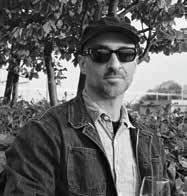
Michael Persico
A creative director and photographer specializing in food and beverage, Michael’s work has appeared in The New York Times, Conde Nast, WSJ and GQ. He’s worked on campaigns for The Rock’s Teremana and Kevin Hart’s Gran Coramino Tequilas. IG: @persicophoto

Sarah Rose
Sarah Rose is a bestselling author and journalist. Her work has appeard in The Wall Street Journal, Outside, Travel + Leisure, Bon Appétit, The Washington Post, Departures and more. X: @thesarahrose

“The Nicks” - Mele and Johnson
Nick Mele is a lifestyle and interior photographer who was once called “The modern day Slim Aarons” by Town & Country. Nick Johnson (pictured) is an internationally recognized architectural and interiors photographer who works for many of the world’s best interior designers. Mele IG: @nickmelephotography Johnson IG: @nickjohnsoninteriors

Juliet Izon
Juliet Izon is an NYC- and Hudson Valley-based travel and design writer. She studied English Literature at Trinity College. You can read her work in Condé Nast Traveler, Food & Wine, and Architectural Digest. IG: @julietizon
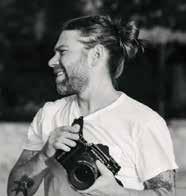
William Kaner
A photographer and filmmaker living and working in New York City and the Hudson Valley, William’s list of credits includes Beyonce’s “Lemonade,” global campaigns for Stella Artois and music videos for A$AP Rocky and Blondie. IG: @wiliam.kaner
CONTRIBUTING WRITERS Adam Erace, Aaron Gulley, Francisco Alvarez, Jaime Walters, Lindsey Kesel, Winston Ross
CONTRIBUTING PHOTOGRAPHERS Blakes Abes, Chad Wadsworth, Chris Rogers, Jen Judge, Tim Aukshunas, Trevor Triano
CONTRIBUTORS
 Mauna Lani, Auberge Resorts Collection.
Photo by Blake Abes.
Mauna Lani, Auberge Resorts Collection.
Photo by Blake Abes.
CEO & PUBLISHER
Jason Cutinella
GLOBAL EDITORIAL DIRECTOR
Brian McManus
GLOBAL DESIGN DIRECTOR & CREATIVE PROCESS
Chelsea Vaccaro
CREATIVE SERVICES
Dan Bradley Executive Producer, Global Branded Video
Gerard Elmore VP Film
OPERATIONS
Merri Gruesser VP Global Development & Strategic Operations
Joe V. Bock Corporate Affairs
Sabrine Rivera Operations Director
ADVERTISING
Mike Wiley VP Sales mike@nmgnetwork.com
Claudia Silver VP Global Partnerships claudia@nmgnetwork.com
Alejandro Moxey Senior Director, Sales
AUBERGE RESORTS COLLECTION
Callie Stanton VP of Brand
Amalia Ramos Director of Creative Services
Hannah Kibble Director of Content
PUBLISHED BY:
2024 by NMG Network, LLC. All rights reserved. No part of this publication may be reprinted without the written consent of the publisher. Opinions are solely those of the contributors and are not necessarily endorsed by NMG Network.
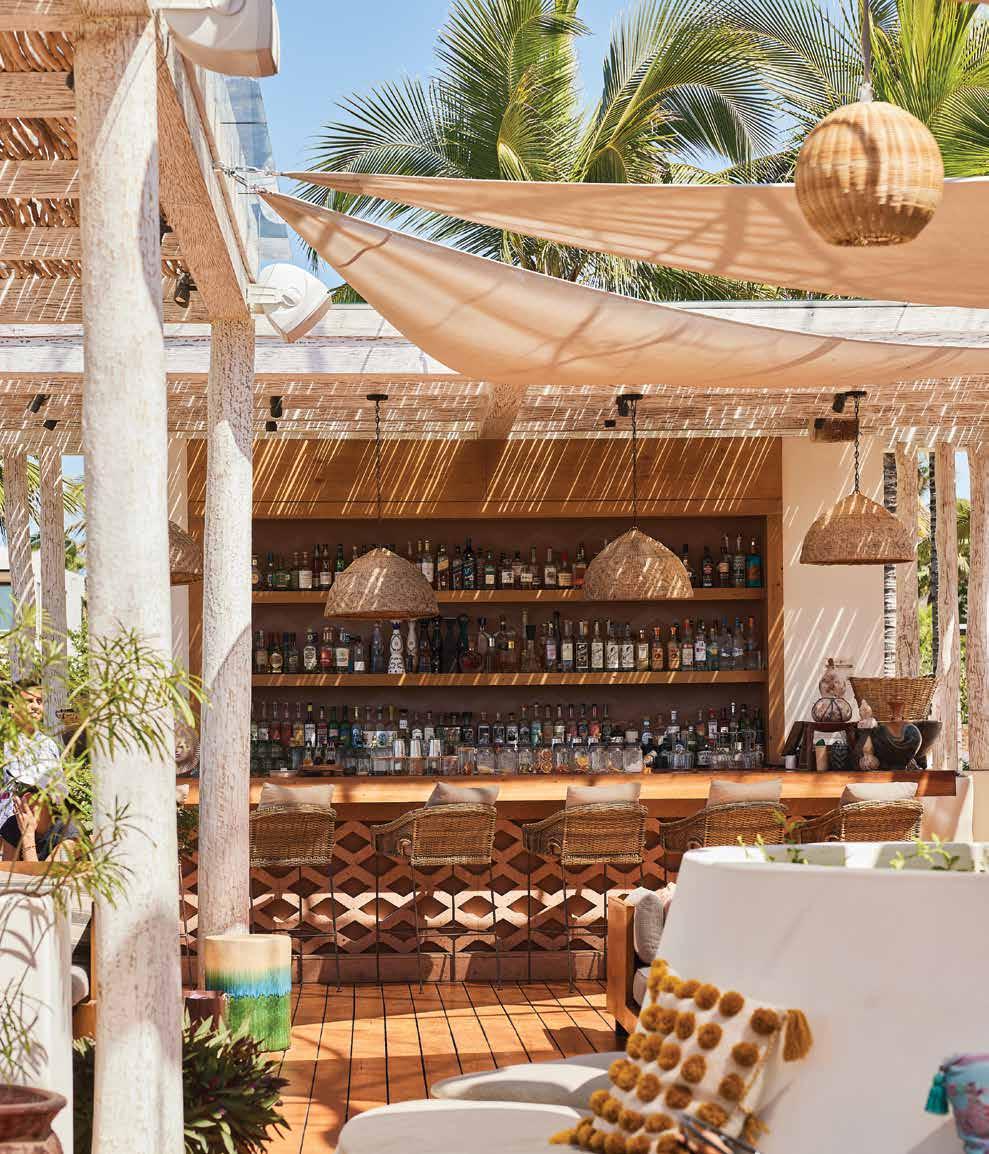 Susurros del Corazón, Auberge Resorts Collection.
Photo by Michael Persico.
Susurros del Corazón, Auberge Resorts Collection.
Photo by Michael Persico.
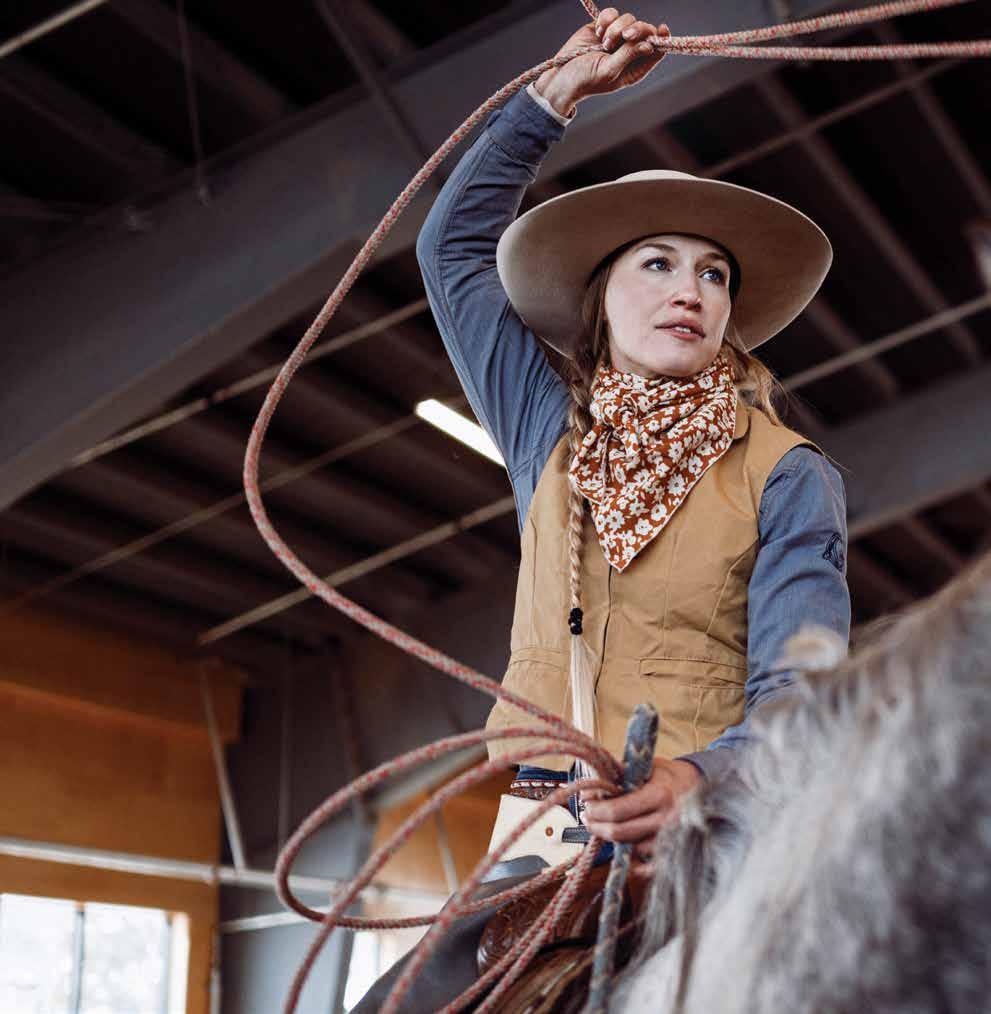 PARK CITY / THE BIG ISLAND
Photo by Tim Aukshunas
PARK CITY / THE BIG ISLAND
Photo by Tim Aukshunas
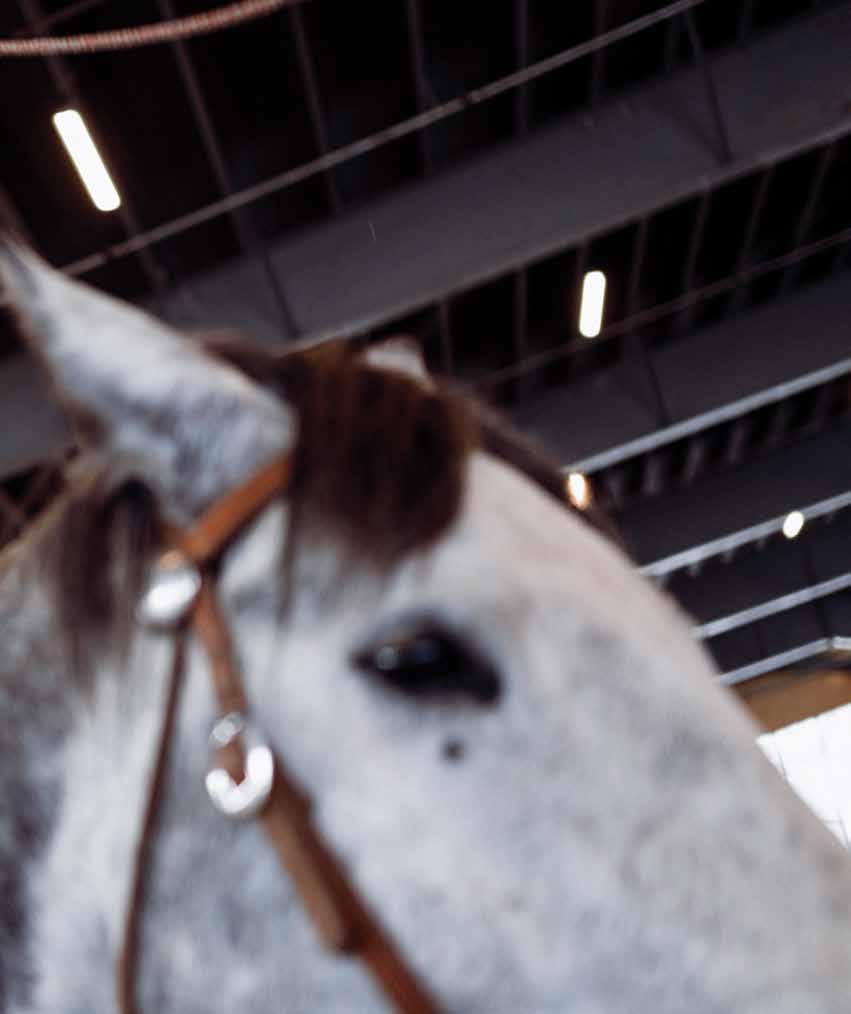
Connect
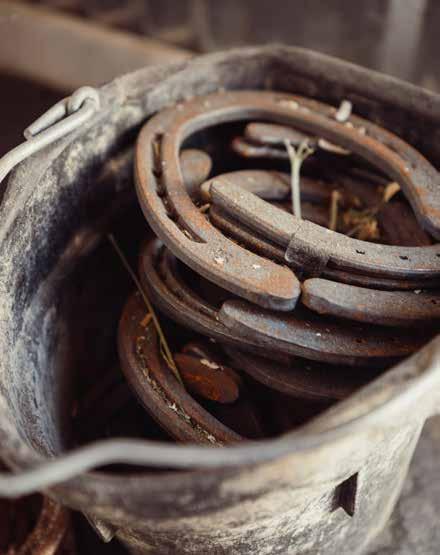
THE HORSE THIEF
How one animal changed the life and work of The Lodge at Blue Sky owner Barb Phillips.
TEXT BY BRIAN MCMANUS PHOTOS BY TIM AUKSHUNAS


The story is now legend.
The origin of how Barb Phillips, respected business owner and model citizen, became The Horse Thief. How, upon discovering abused and neglected horses on a ranch near The Lodge at Blue Sky, Auberge Resorts Collection—the vast 3,500-acre remote luxury retreat paradise she coowns with her husband Mike in Wanship, Utah, just outside Park City—she took it upon herself to deliver hay and water to the roughly 100 traumatized and starving animals. How one in particular, Gracie, stirred something in her so deeply it altered the course of her life and work.
The year was 2013, and though she’d always been an animal lover, she wouldn’t say she was “a horse person.” She’d just begun to learn about the powerful and gentle creatures then, through her work with them at Blue Sky.
Still, upon seeing a local news segment on the abused horses nearby, she felt compelled to act—”I just had this feeling, like, ‘I’m in a position where I think I can make a difference,’” she says on a recent sunny Utah day, standing in one of the snow-covered fields at Blue Sky, reflecting. “I want to figure out how to do that.”
She had Gracie—one of the worst off—trailered to a nearby vet at her own personal expense. Released from a doctor’s care, Barb understood Gracie’s dark fate if she were to return back to the place that was responsible for her condition to begin with. She wouldn’t let it happen.
Even under the threat of jail.
That initial rescue opened Barb’s eyes to what, she learned to her horror, is an all-too-common problem: “Not only just animal neglect and abuse, but in particular, with horses,” she says.
Gracie was but the tip of the iceberg. “Especially when you’re confronted with something like that for the first time, it’s easy to feel overwhelmed,” says Barb.
To combat the giant task at hand, Barb adopted a mantra that became a mission statement. Just as a journey of a thousand miles begins with one step, the task of healing broken and abused horses would be done “One horse at a time.”
Gracie is now the namesake of what has grown into the Saving Gracie Equine
21
Left: Saving Gracie Equine Healing Foundation and The Lodge at Blue Sky owner Barb Phillips.
 Right: Saving Gracie Director Melissa Smolik.
Right: Saving Gracie Director Melissa Smolik.



 Right: Saving Gracie Farrier Max Harris makes custom shoes for the horses at the Foundation, many of whom arrive with severe hoof issues.
Right: Saving Gracie Farrier Max Harris makes custom shoes for the horses at the Foundation, many of whom arrive with severe hoof issues.
Healing Foundation and Gracie’s Farm on the property at Blue Sky, which includes The Lodge and a state-of-the art Remuda—a stunning 36,000-square-foot riding arena with sweeping views of the Wasatch and Uinta mountains through its large windows. Blue Sky began, says Barb, with its equine program, the mission of which was to teach visitors of the area about the history of the land, its people and animals, through working with horses on trail rides and other activities. Saving Gracie was a natural extension of that effort.
“I saw how physically and emotionally damaged these horses were,” says Barb. “And I felt like it was really important to deal with that and not just give them a different place to live away from danger, but to work on trying to get them to a healthier place.”
When Gracie arrived at Blue Sky, she was “uncatchable, unrideable, not friendly,” says Barb, a result of the trauma she’d experienced in her life. “She’s overcome a lot of that.”
In the decade-plus since that news story, dozens of horses have arrived at Saving Gracie, each to a suite of diagnostic and therapeutic tools to help heal their emotional and physical scars. For the latter, the Foundation has top-shelf lab and veterinary equipment—an X-ray machine, a centrifuge to spin a horse’s blood for testing and to extract Platelet Rich Plasma (PRP) to aid in the healing of arthritis. There’s also an ultrasound, lasers, and an array of wellness treatments tailored to each animal. The horses receive top-of-the-line dental care. There’s a full-time farrier on site who makes
 Photo by Patrick Brandenburg
Photo by Patrick Brandenburg
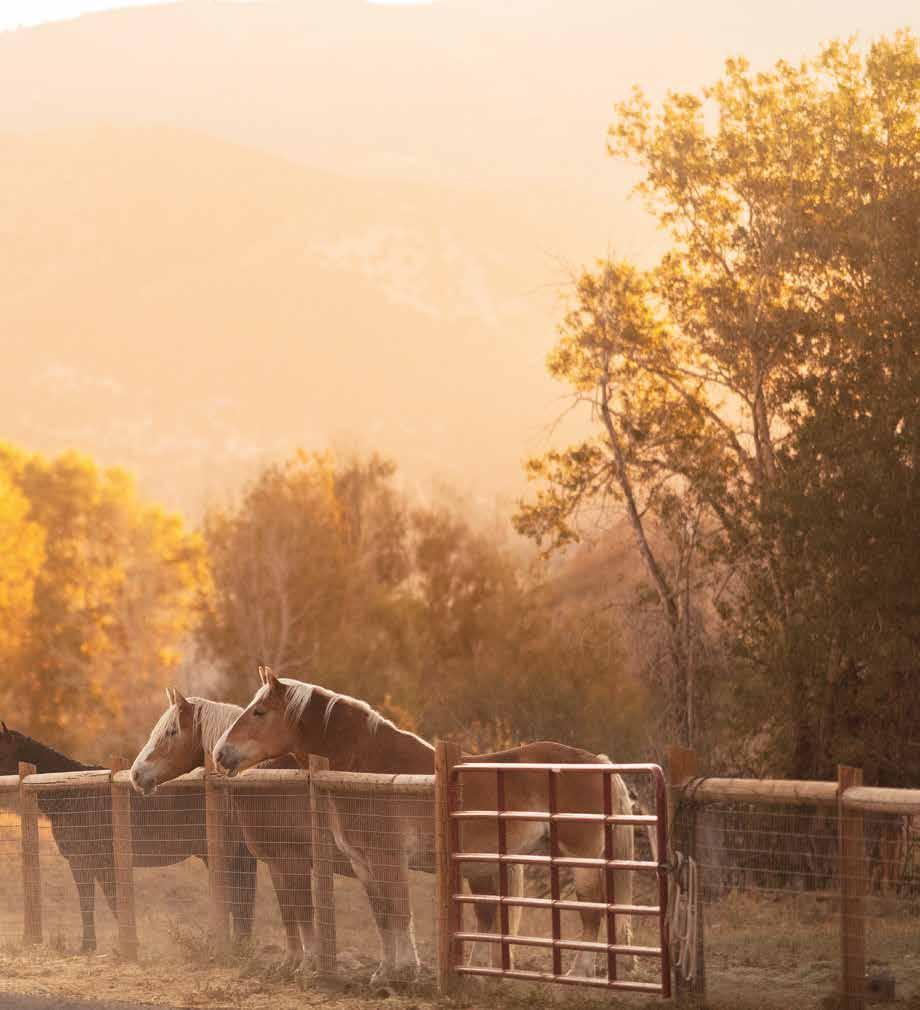
 Photo by Richard Schultz
Photo by Richard Schultz
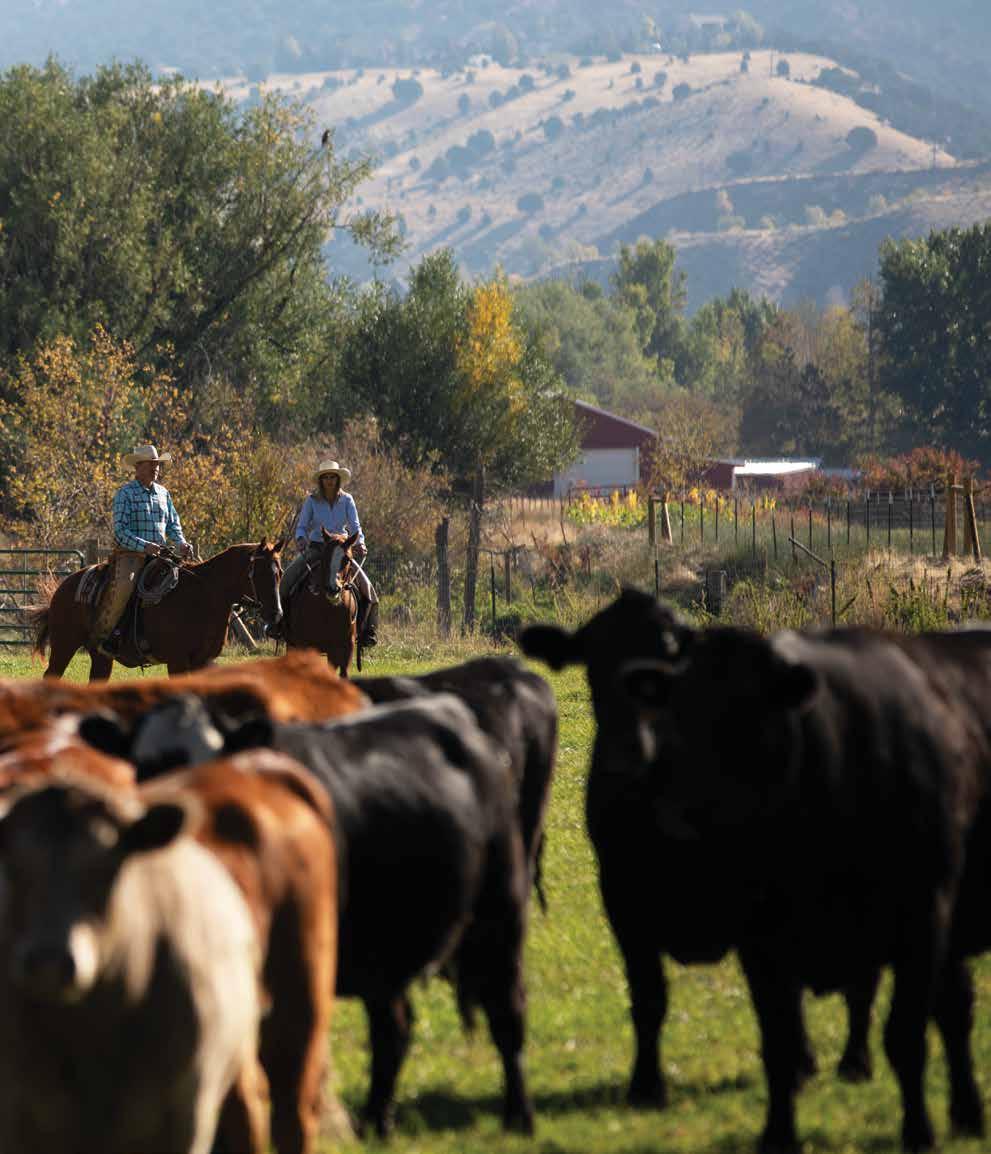
 Previous page: Riding in the Remuda at Blue Sky, an impressive 35,000 square foot arena. Right: Barb Phillips on her property
Previous page: Riding in the Remuda at Blue Sky, an impressive 35,000 square foot arena. Right: Barb Phillips on her property
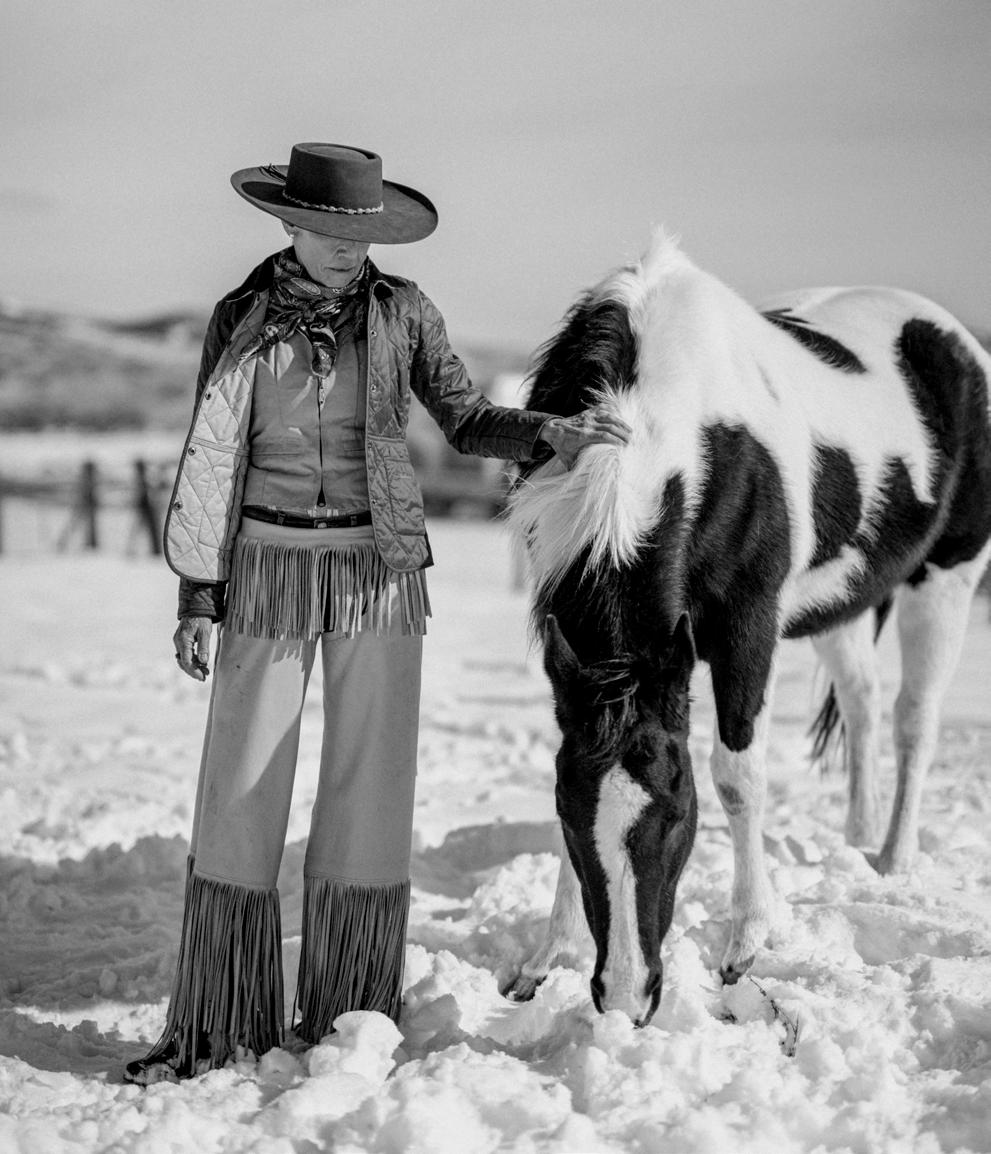
custom horseshoes for the animals, their hooves often in particularly bad shape when they arrive. The Foundation has an on-staff veterinarian and two vet techs.
In short, each and every horse on property receives what’s known as “the Gold Standard of Care,” which is the goal of all clinics and vets, but is sometimes not an option due to the exorbitant cost. Sometimes, the horse owners simply can’t afford it.
This is partly what makes Saving Gracie different from many other horse rescues. It is a medical rehabilitation rescue with everything it could possibly need in that regard on site.
Rescue, recovery and rehabilitation are the goals at Saving Gracie. One “R” that’s missing is one more common at other rescues—“re-home.”
“A lot of our horses aren’t re-homeable due to their medical conditions, and since we have our own vet we are able to take on those more difficult cases,” says Melissa Smolik, Director at Saving Gracie.
Upon intake the horses’ physical and emotional states are given an assessment, and a rehab plan is put into action. The rehab starts with grooming every morning. Every horse gets their own special bucket of grain each day with a customized blend of supplements. “A lot of training goes into it as well,” says Smolik.
At Saving Gracie, most of the horses can’t be ridden. It makes no difference. Where, at other rescues, donations may cover the day-
to-day, Saving Gracie has “this advantage of being part of an organization [The Lodge at Blue Sky] that is a business, that does trail rides, that gives guest lessons [on different horses who haven’t been rescued]. So I can piggyback off of that,” says Barb.
Piggybacking off the business of The Lodge at Blue Sky—which features a giant photo portrait of Gracie by Patrick Brandenburg in its lobby and a cocktail, “The Horse Thief,” on its bar menu, proceeds from the purchase of which support the Foundation—means not having to choose which horse receives care and which doesn’t. “I don’t say, ‘Well, you get this treatment because you’re a working horse, and you don’t because you’re a rescue horse.’ I don’t do that,” says Barb. “If a horse needs surgery, and all they are is retired and hanging out, they still get the surgery. We’re just trying to give them the best life. The Lodge drives everything else.
“We’ve created a culture here within the equine department that really nurtures every horse regardless of their issues,” says Barb. “One horse at a time because that way I can give the horse the attention that it needs.”
Most of the rescued horses arrive to Saving Gracie via tips to Barb from various sources. Nearly all are in some state of physical duress, most commonly arthritis. Still others have navicular syndrome, a complex condition that causes heel pain and lameness in the horse. Some suffer from rashes or skin conditions. Open wounds aren’t uncommon.
Aside from the significant expense, the physical injuries the rescued horses
32
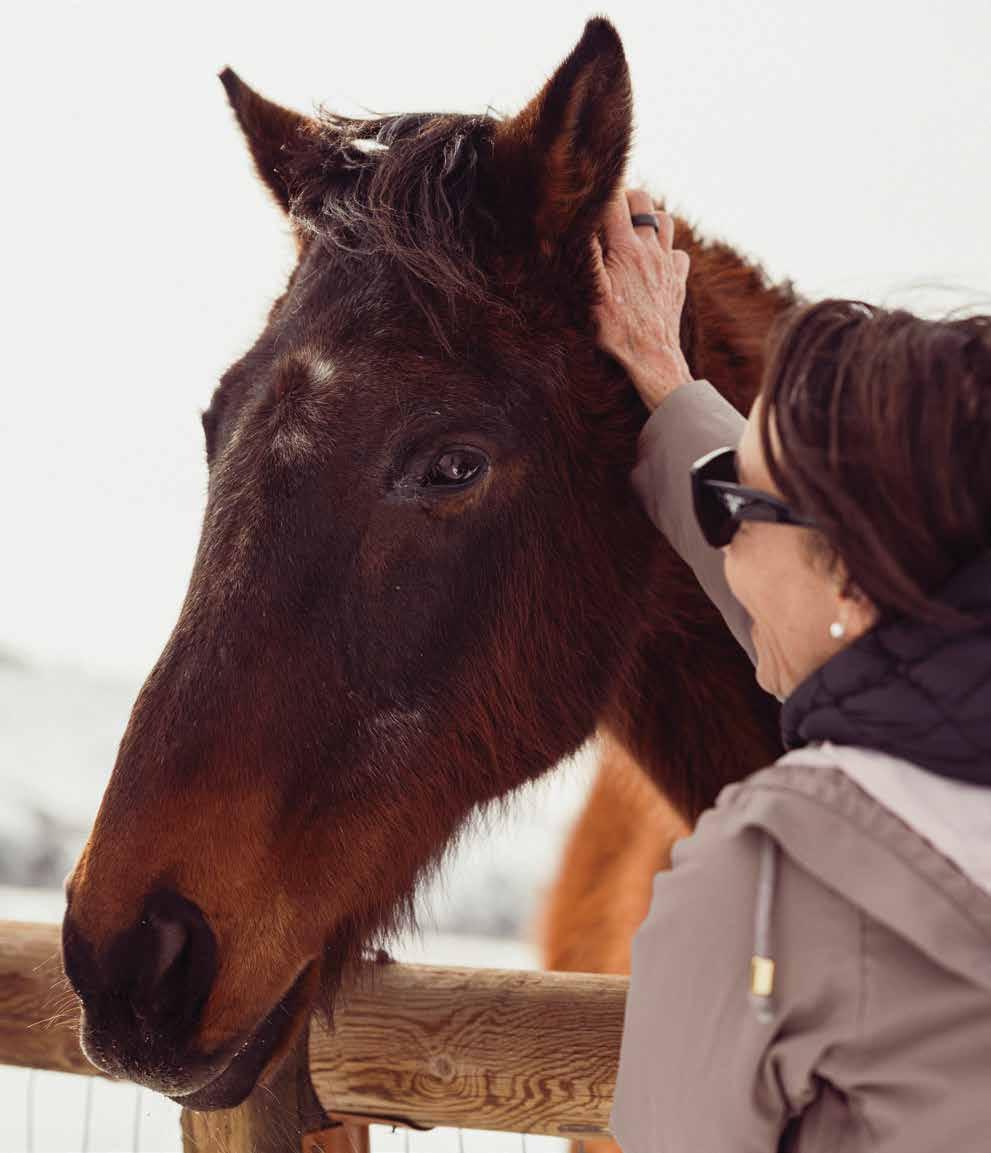
Barb and Gracie.
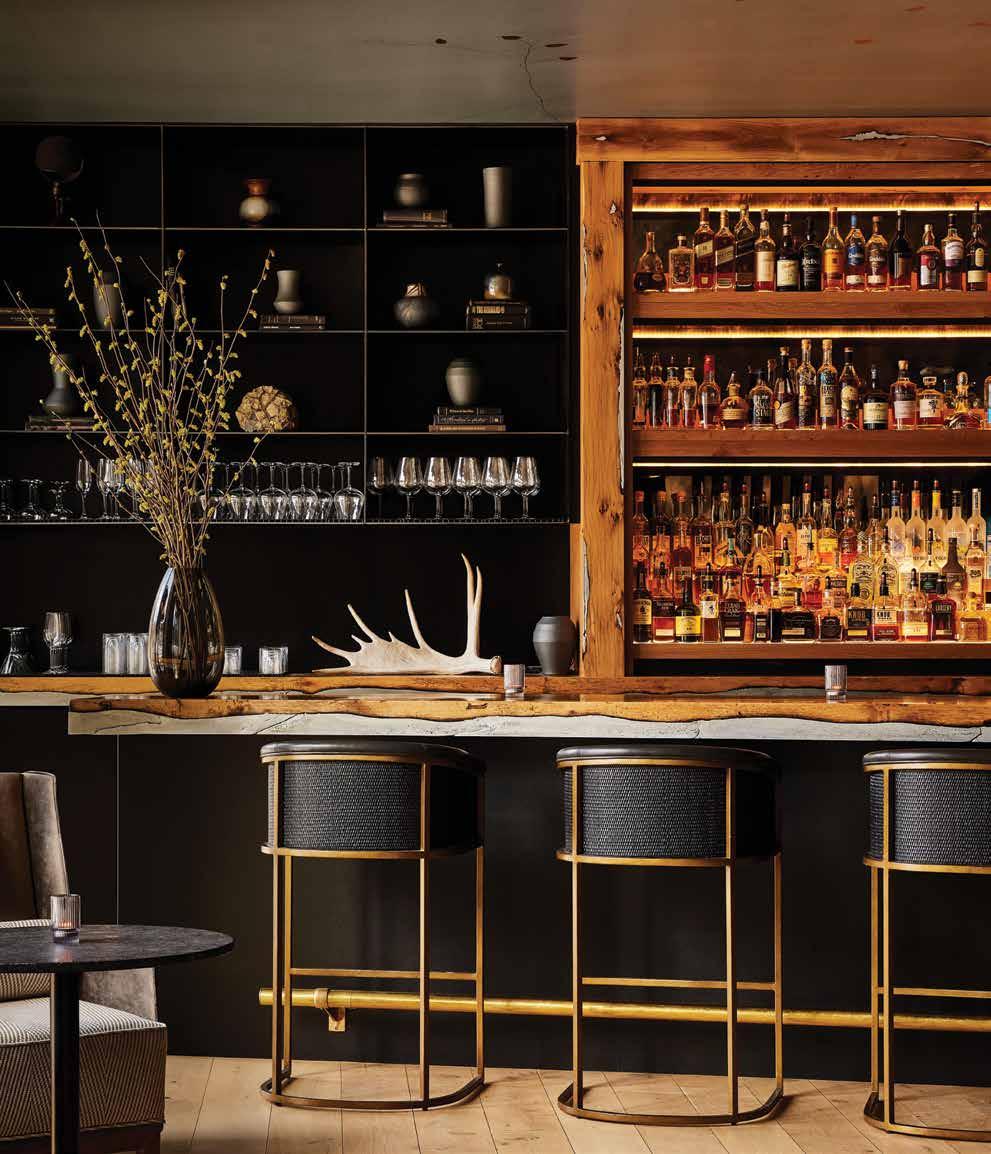 Photo by Read McKendree
Photo by Read McKendree
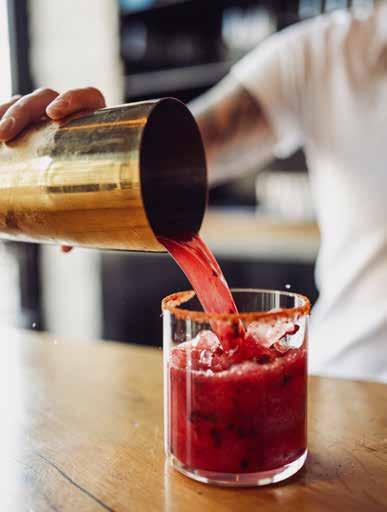
come to Saving Gracie with are fairly easy to tackle. It’s the psychological scars that take the most time to heal.
“A lot of them come in with a lot of trauma, so we just let them lead the way with what they’re ready for,” says Smolik. “With some horses it can take years for them to let their guard down.”
“When I can have a horse that’s not doing well physically and then we get results, that’s amazing,” says Barb. “But probably at the top of the list is a horse that didn’t trust you and now all the sudden is coming up to you and wanting your attention.”
Recently the number of horses wanting Barb’s attention grew by a factor of eight. In December she received a tip about a group of “50 babies” headed to a kill pen in Texas. Again, her instinct to act kicked in, this time even in the face of her “one horse at a time” mission statement. She agreed, at first, to take on six. That grew.
The Lucky 8, as they’ve come to be called, now live on Barb’s own property, some 30 minutes from Saving Gracie. They arrived as many do, untrusting and fearful. In just a few short months, that’s begun to change, and both Barb and Smolik have seen encouraging signs.
“Even thinking about it kinda gives me goosebumps,” says Smolik. “It’s such a special feeling when you see a horse change and you know they’re not scared anymore.”
35
Left: The inviting bar inside The Lodge at Blue Sky. Above: Kerri Poggi, creator of The Horse Thief cocktail, prepares the drink, proceeds from which are donated to Saving Gracie. The recipe includes ginger, blackberry, tequila and whiskey from High West distillery, on property at Blue Sky. (See page 200.)

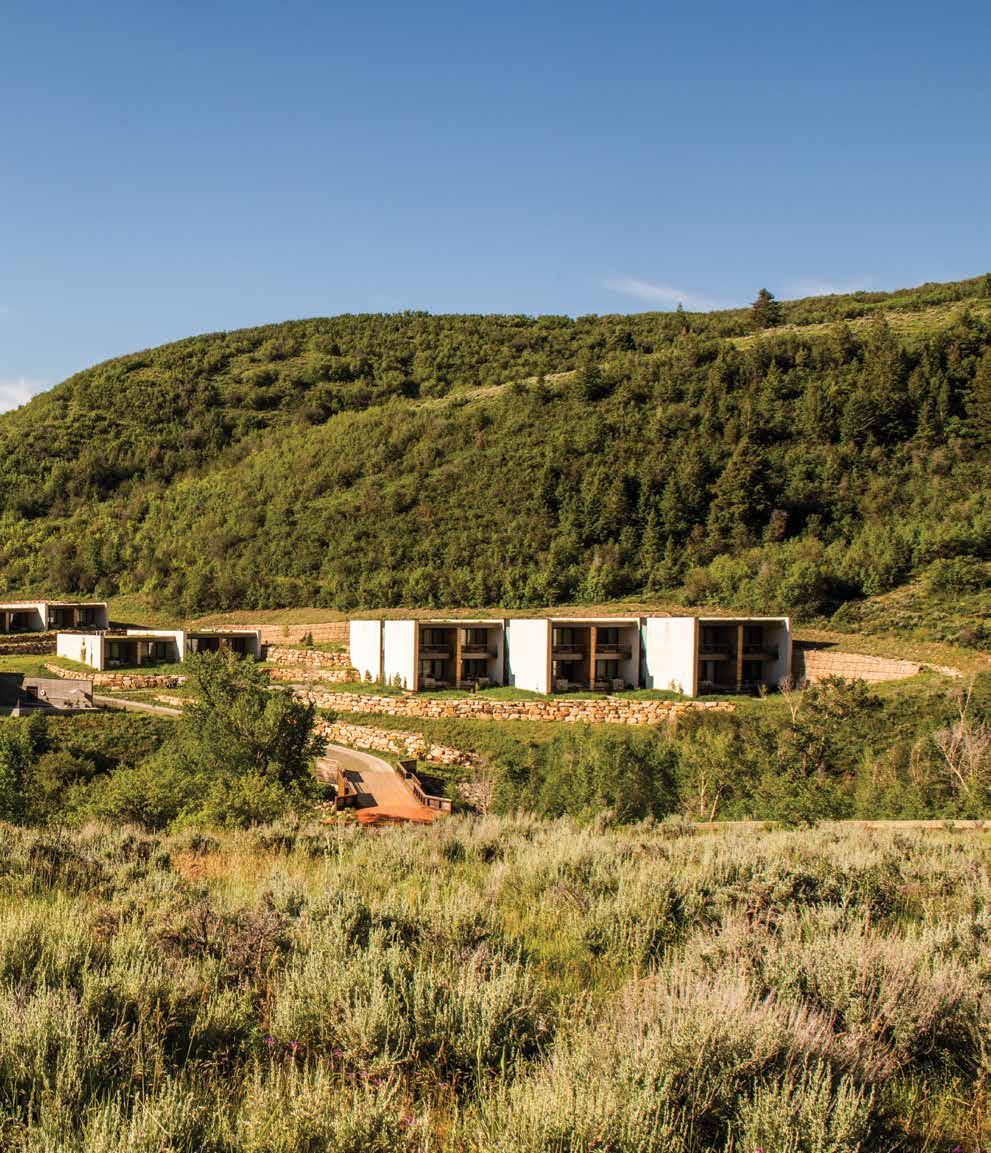
by
Photo
Lynn Donaldson
From the Saddle to the Land
Experience the apex of adventure at The Lodge at Blue Sky, the 3,500acre private retreat in the Wasatch Mountains, and reconnect with nature.
ADVENTURE
Become lost in the expanse the wilderness has to offer at the land-honoring luxurious escape. From Traditions of Natural Horsemanship, which educates guests on how to communicate and connect with horses and their unique personalities to fly fishing and sporting clay experience—embrace the great outdoors to its full potential.
FAMILY
The female-led “FarmHers” at Gracie’s Farm School are eager to teach all ages the secrets of creating a biodiverse farm and implementing sustainable practices. Connect with the land and experience the essence of this special farm. Also on offer for families is the Little Vaqueros Camp which helps connect younger guests with the wonders of Mother Nature.
WELLNESS
Recover and reset at the Edge Spa, a wellness sanctuary like no other. Aptly named for its dramatic location perched on the side of a precipice overlooking Alexander Creek, it seeks to restore guests after an enriching day exploring the great outdoors. On offer are several different types of massages and holistic treatments for the body and spirit. From transformational meditation in the wild to invigorating private pilates sessions, Soaring Yoga and breathwork courses, The Lodge at Blue Sky offers an idyllic backdrop for rediscovery.
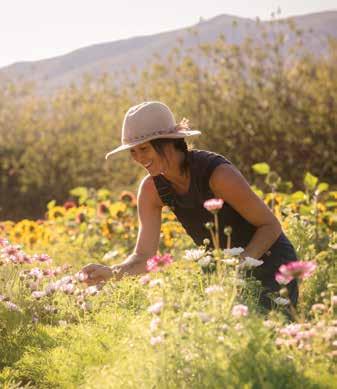
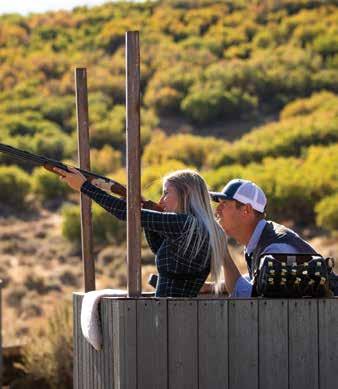
38
Summer at The Lodge at Blue Sky offers much for the adventure minded: from a sporting clay experience to fly fishing the diverse range of waters surrounding the picturesque property. Top: Photo by Patrick Brandenburg. Bottom and right page: Photo by Richard Schultz.
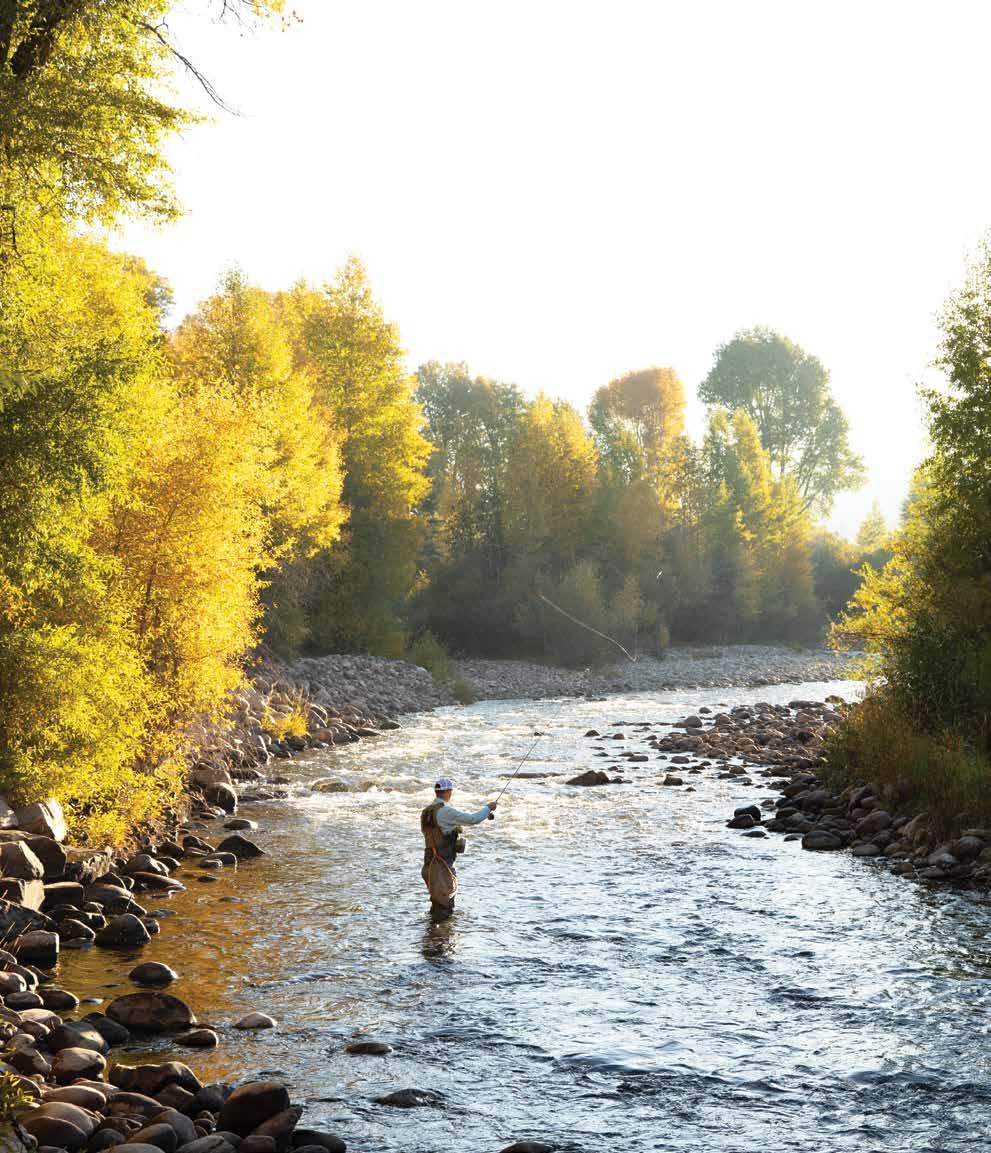

OF THE
the art wave
Native Hawaiian surfboard maker Brandan Ahuna is reviving the Sport of Kings for the surfers of tomorrow by looking to the past.
 TEXT BY SARAH ROSE PHOTOS BY BLAKE ABES
TEXT BY SARAH ROSE PHOTOS BY BLAKE ABES

“When I ride my alaia, I have more connection with nature and the ancestors, just because the board was once a tree, so it had a spirit, a mana.”
—BRANDAN AHUNA
From the instant Brandan Ahuna first saw a wooden surfboard while working as a professional lifeguard, he was hooked. “I took off on my first wave and stood up on it, rode it all the way. The board rode as good as it looked. It was unbelievable.”
Ripping that single wave connected Ahuna to his own culture in a way even a kid raised on a Hawai‘i homestead found exhilarating and ancient. “I just said to myself, look here, I am a Native Hawaiian riding this traditional Hawaiian surfboard, I feel like I should be able to make this myself.”
Today Ahuna is among a handful of native alaia surfboard shapers, reviving a lost skill, and linking indigenous craft to ocean sustainability.
After that first ride, Ahuna began making wood boards for friends, studying how pre-contact Hawaiians shaped theirs with visits to the Bishop Museum in Honolulu. He has been modernizing, tweaking and improving designs ever since. Now a bespoke board maker, he matches the wood and the length to the style of the rider and the size of their waves.
“When I ride my alaia, I have more connection with nature and the ancestors, just because the board was once a tree, so it had a spirit, a mana. That wood-on-water connection is amazing, it feels different.”
Not only different, but healthier for the shaper and the sea. Modern boards are a mix of fiberglass and foam, a collection of noxious chemicals, where Ahuna uses salvaged local wood, driftwood and recycled hardwoods. Hawai’i’s endemic trees are protected, so he partners with local sawyers and contractors to source wood that has fallen naturally or can be repurposed.
“All my boards are functional pieces of art,” Ahuna says over lunch at Mauna Lani, Auberge Resorts Collection on the Big Island of Hawai‘i. Classic wooden surfboards, known as alaia, were ridden for hundreds of years before Europeans arrived on Hawai‘i’s shores. While the boards are beautiful, with delicate inlays and a grain that seems to glow from inside the plank, Ahuna’s aren’t just wall-hangers, his boards are meant to be surfed.
Alaia surfing had all but disappeared until the Hawaiian cultural renaissance met up
43
Left: Surfboard shaper
Brandan Ahuna stands with one of his boards on the beach near his home in Hilo, Hawai‘i.
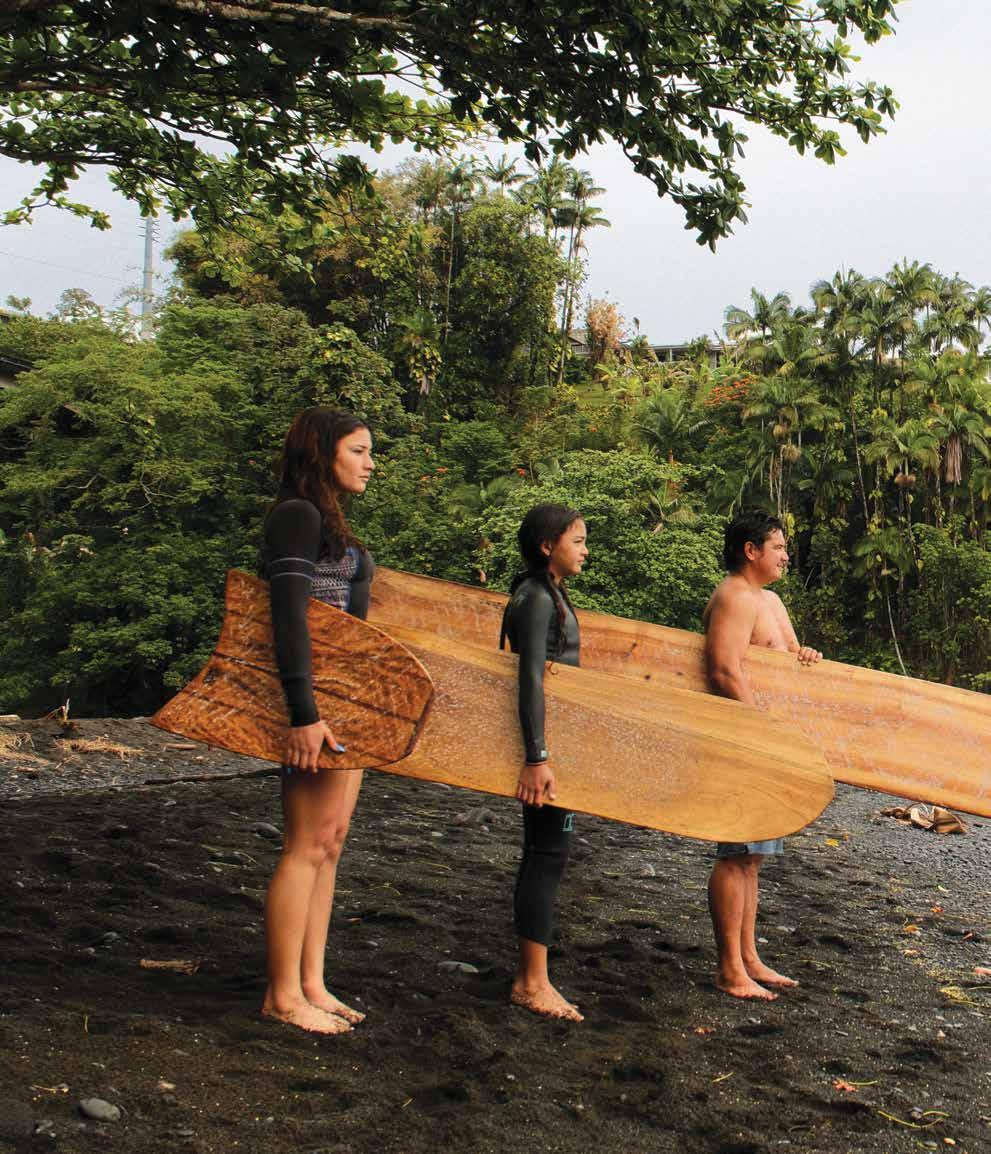

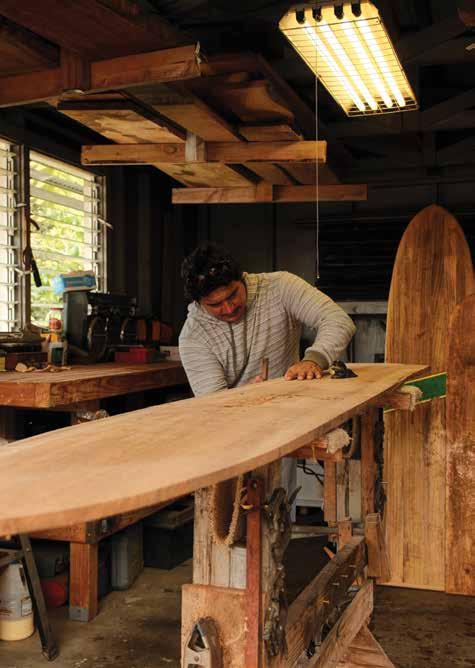
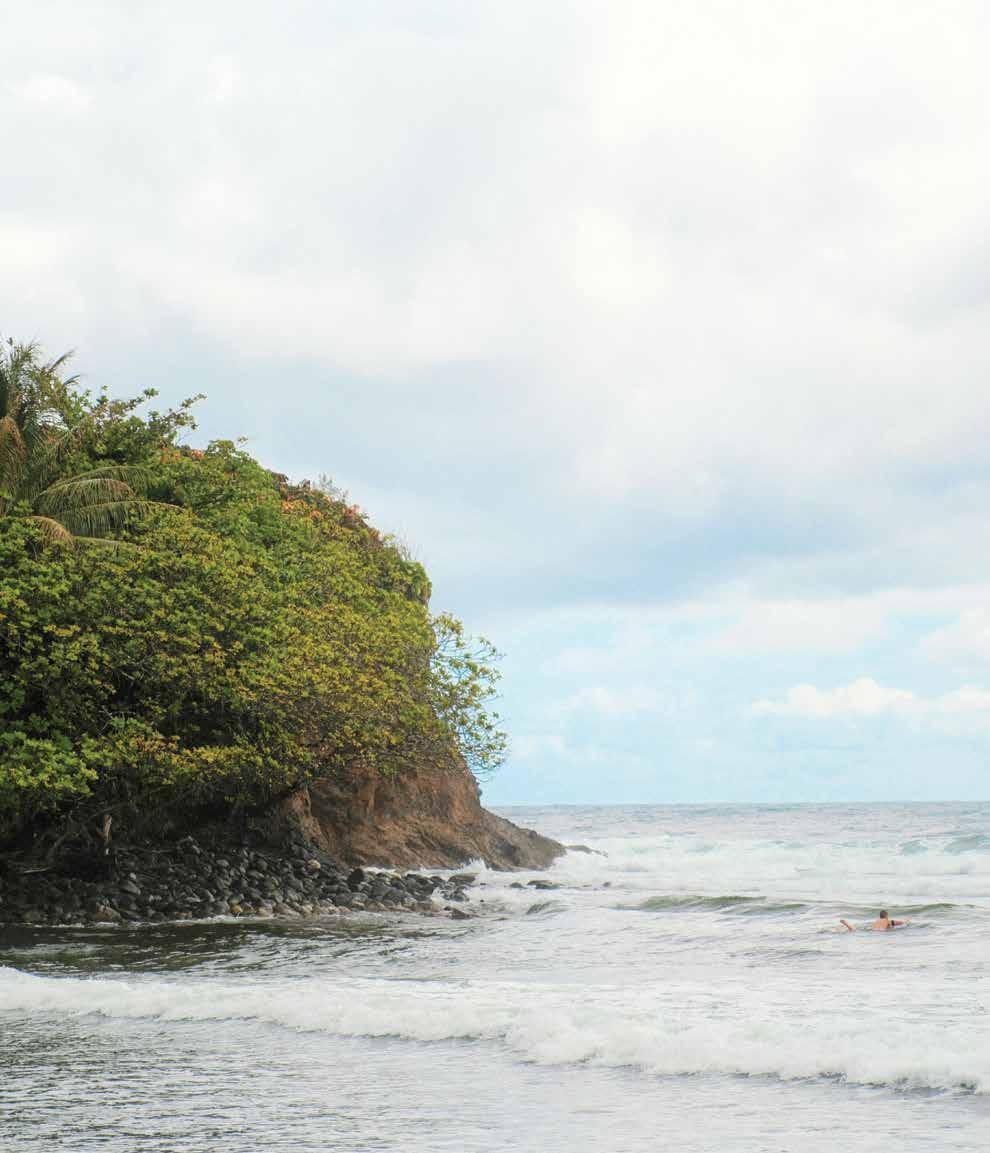
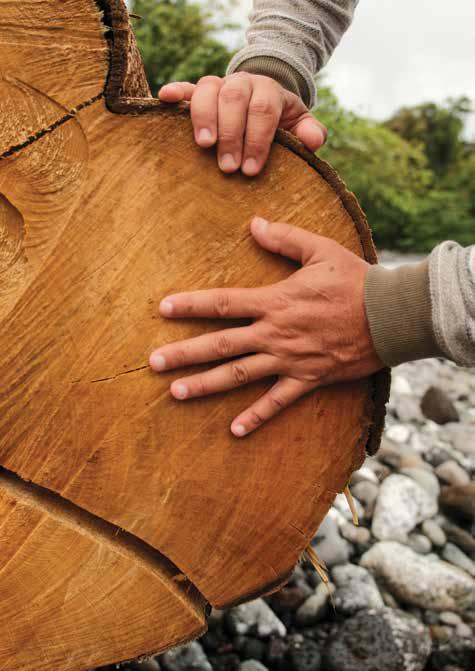
with 21st-century surfers. On first glance, Ahuna’s boards look more like snowboards or a skateboard deck—they are flat, short, and only an inch thin—and crucially, they lack bottom fins and so don’t grip the water the way a modern board will, they don’t have the same control or lift. Ahuna’s boards are celebrated for sliding down a wave’s face with what Hawaiians call lala, literally, on the diagonal. That is, they are unpredictable, fun, an adventure.
It takes about two weeks to complete each board, Ahuna says, he remains a Big Island lifeguard by profession. Where ancient Hawaiians used stone tools, water and natural resin to fashion boards, Ahuna’s workshop is his garage and looks like any modern woodworker’s, with bandsaws, planes and sanders. His three daughters, ages 17, 11 and 6, will pitch in to help on breaks and weekends, “when they’re stuck at home with dad.”
Today, Ahuna enjoys teaching local kids and his own children about traditional surfboards and can imagine himself passing on board-shaping skills to future generations of Hawai‘i’s grinders. These sustainable and historic boards have become Ahuna’s kuleana, his ancestral obligation.
“My grandfather told me, put it out there. It’s up to you to take it where you want.”
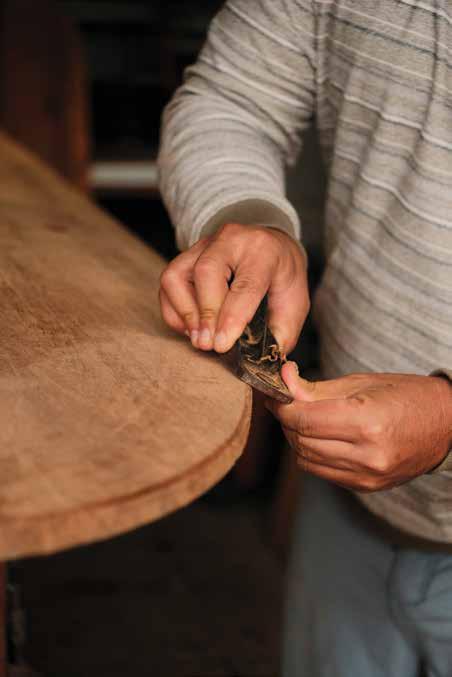
48
Next page: Mauna Lani’s legendary Surf Shack.
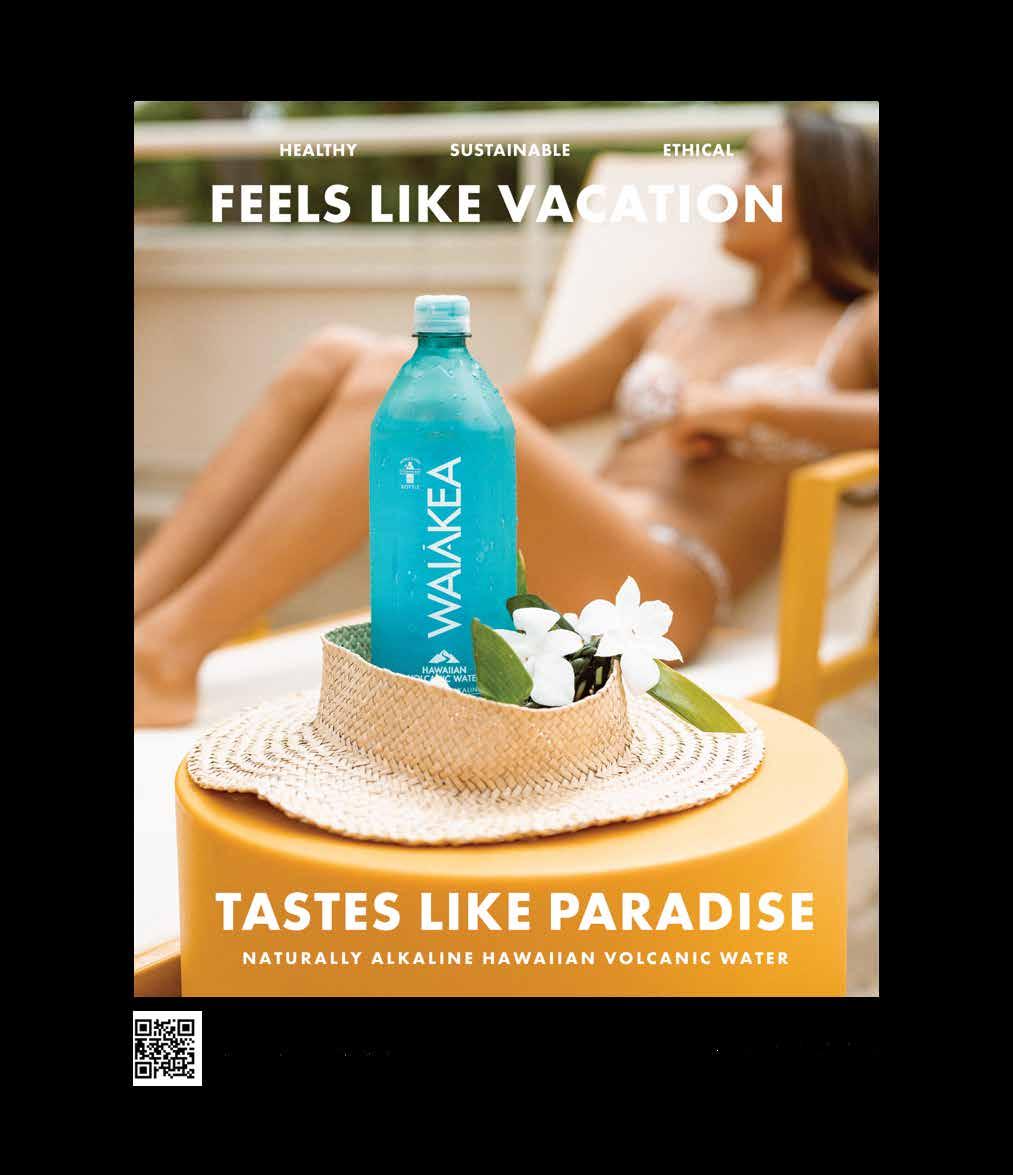
Beyond the Wave
Native Hawaiian tradition is celebrated at Mauna Lani with a deep dive into the Big Island of Hawai‘i’s rich history of sustainability, sea loving and star gazing.
ADVENTURE
At dawn, hop into a Hawaiian outrigger canoe and see the sun rise over the world’s tallest volcano. “Talk story” with Kainalu Pros as part of Surf Lessons from the Surf Shack, welcome the new day with traditional local chants, and Snorkel the Kohala Coast to meet creatures sharing the water: sea turtles, reef fish, and in winter, the song of the Humpback whales.
FAMILY
Holoholo Kids Crew adventure activities for children ages 5 to 12 are inspired by island culture: From tie-dying with native flowers picked from Mauna Lani’s gardens, to bamboo-pole fishing and net fishing, designing a double-hulled voyaging canoe out of cork, and painting personal petroglyphs. Kids learn stories of Maui and his fishhook constellation, sing moonphase chants, and hike to explore “nature’s touch tanks” in the resort’s historical Kalahuipua‘a fish ponds. Other activities on offer to families: Art of Lei Making, a Petroglyph Hike and Barefoot Bonfire
WELLNESS
The sacred healing art of Lomi Lomi Massage is practiced at the Mauna Lani spa, handed down from elders, the kupuna, to each next generation. The technique mimics the rhythm of ocean waves, using palms, forearms, and the essences of native and local plants and flowers. Kanani Facials, also available, are organic and customizable.

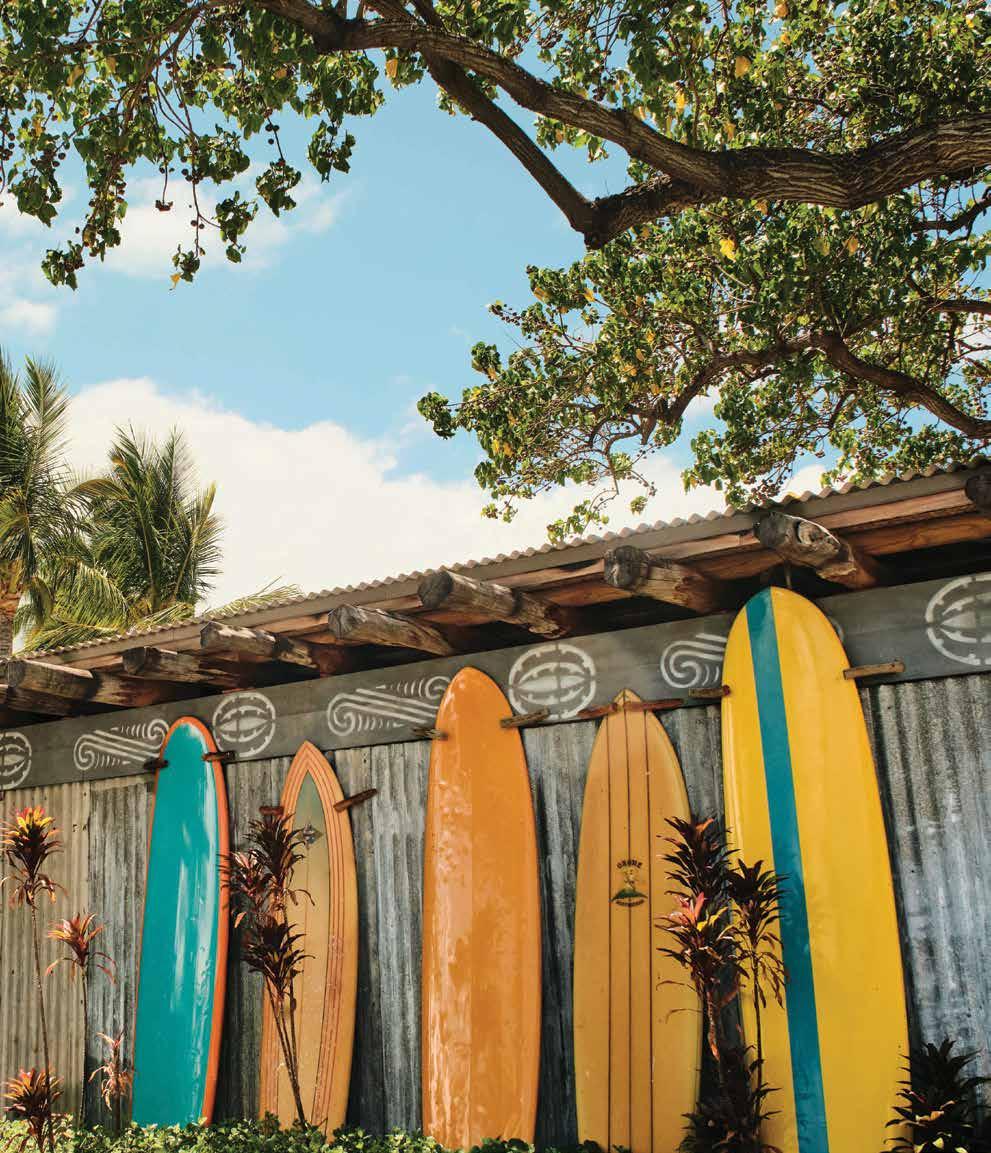
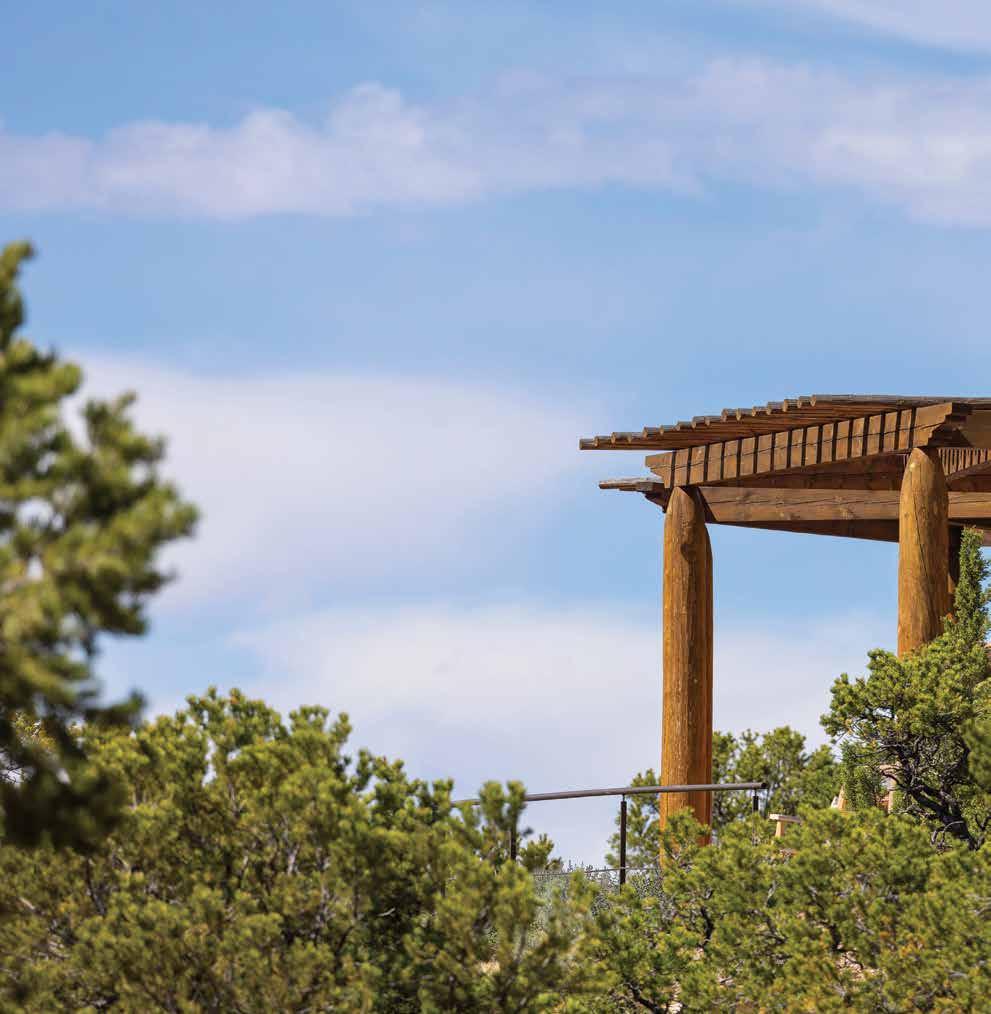 NEWPORT / CONNECTICUT COUNTRYSIDE / SANTA FE
Photo by Jen Judge
NEWPORT / CONNECTICUT COUNTRYSIDE / SANTA FE
Photo by Jen Judge
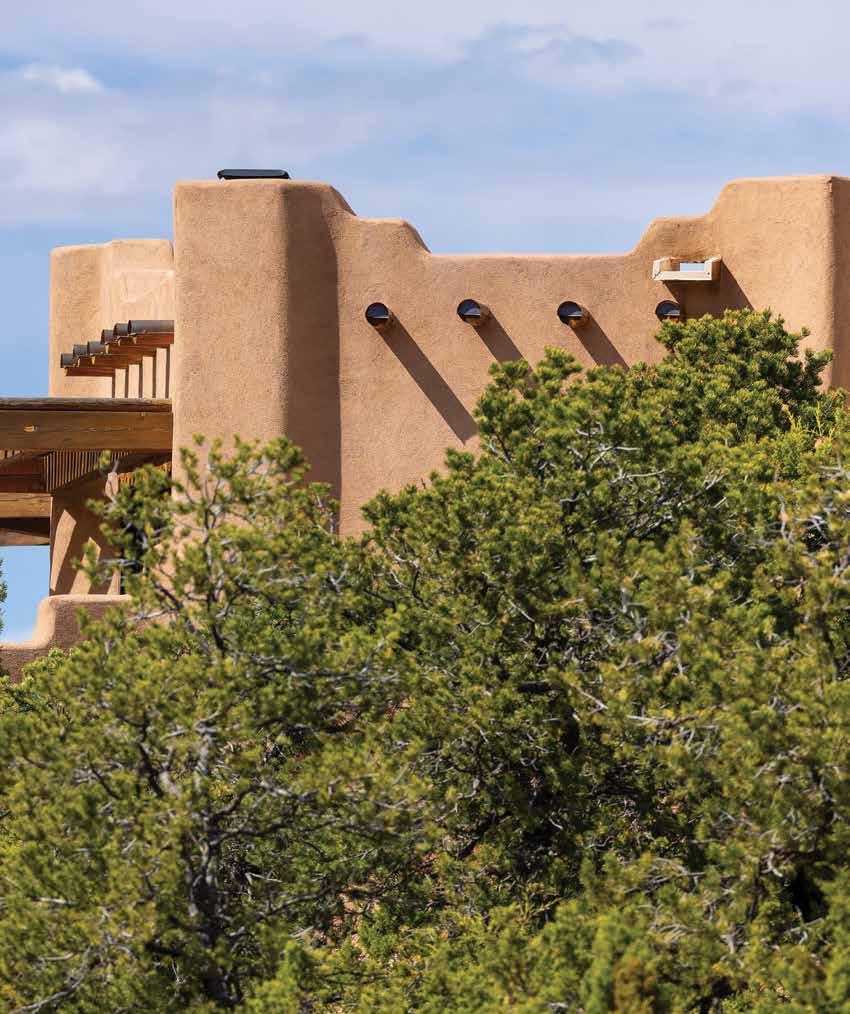
Voyage
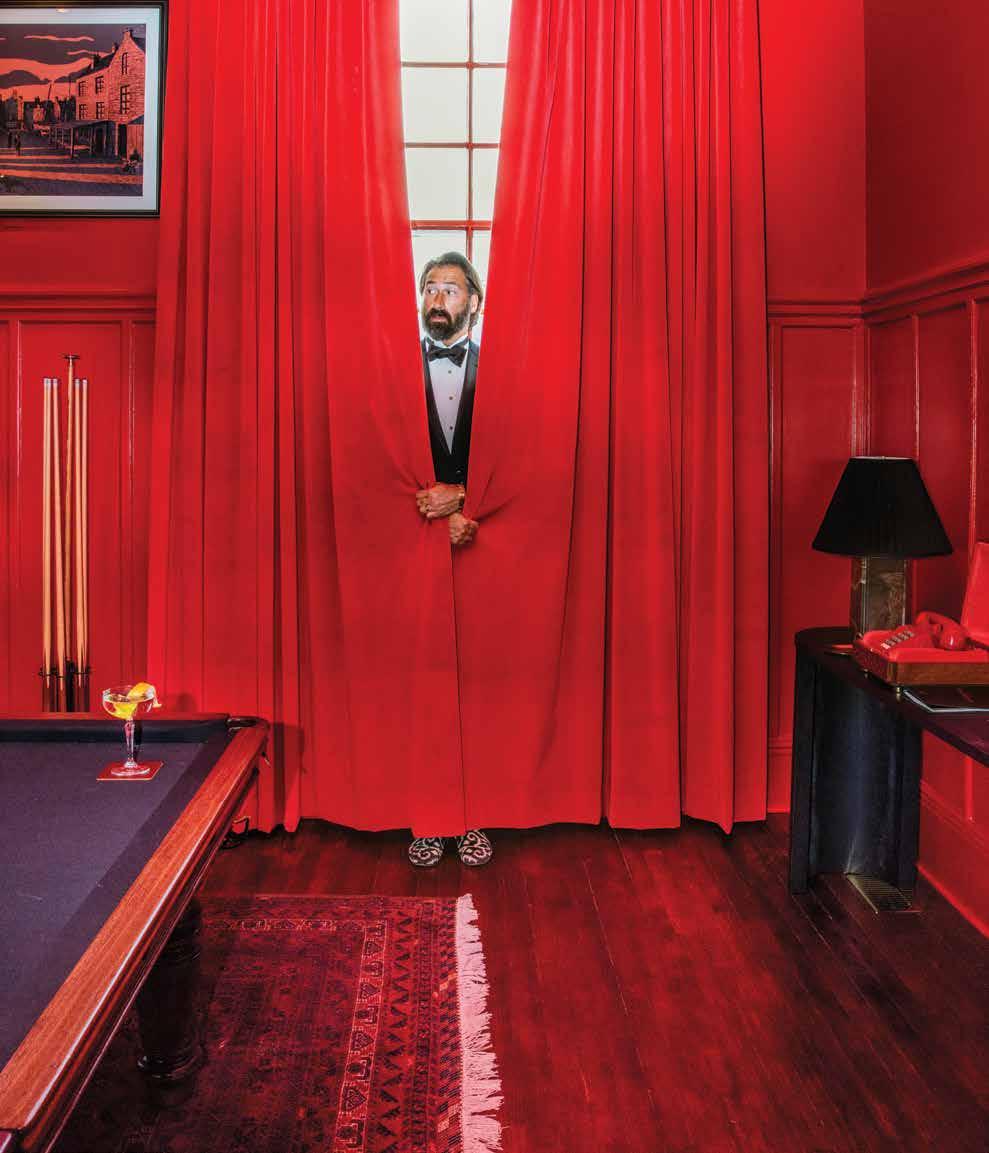 Nick Mele inside The Reserve Room at The Vanderbilt, Auberge Resorts Collection.
TEXT BY BRIAN MCMANUS
Nick Mele inside The Reserve Room at The Vanderbilt, Auberge Resorts Collection.
TEXT BY BRIAN MCMANUS
NICK MELE’S NEWPORT
WONDERLAND
View the charming seaside town through the unique lens of the talented photographer.
There’s not much Nick Mele can’t do behind the lens of his camera. Through it the world gets more interesting. Bolder. More colorful. (Even, somehow, when shot in black and white.) On the other side of the lens, the famed lifestyle photographer also showcases his talent, vividly displayed in the following pages as the camera turns to capture him in Newport, Rhode Island.
That won’t be a surprise to the thousands who follow his @a.social.life Instagram account, which frequently sees him turning the camera on himself and his family in ornate, audacious, luxurious, extravagant settings. (“More is more and less is a bore,” is his oft-stated motto.) But in the photo essay that follows, one that includes photos of and by Mele, we hope readers get a sense of just how well he knows every aspect of his craft—what makes a great photo, whether he’s the one pointing the camera or grinning in its direction.
With the latter, he can change the mood of what’s in frame by simply raising his brow, opening his eyes widely to show their
whites, or tilting his body ever so slightly. His expressive face is a broad canvas.
Newport is where Mele summered as a child (and still now, as a grown man, husband and father of two), where his mother and in-laws still live and where he visits very often. He understands the vibrant seaside town like he understands his camera’s aperture. “They filmed the original ‘Gatsby’ here, the one with Robert Redford,” he’ll toss off casually while pulling up to Rosecliff, a Gilded Age mansion on the edge of town, just down the road from the churning waters of the Atlantic and his childhood summer home.
In his book of photos about this magical place, A Summer in Newport, he captures images of the season in which it comes most alive, breaking it down month to month— the parties, the clambakes, the sunshine, the revelry, the joy and, as always, the color.
Take a look inside Nick Mele’s Newport, which often includes visits to The Vanderbilt, Auberge Resorts Collection. All quotes are his.
55 PHOTOS BY NICK JOHNSON AND NICK MELE
“In many ways, Newport is one of the last bastions of old school American high society. The grand houses of yesteryear still stand—often untouched by modern renovation and style.”
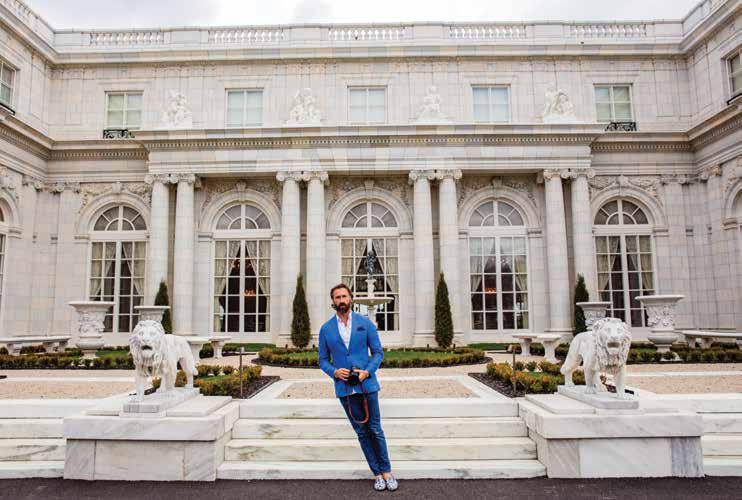 Above: Mele poses in front of the Gilded Era Rosecliff mansion. Right: Nick Mele on the edge of town, on the hood of a vintage Mustang, provided by The Vanderbilt, Auberge Resorts Collection. Driving a classic car is an experience offered to guests of the hotel. Next page: Mele at Newport’s International Tennis Hall of Fame.
Above: Mele poses in front of the Gilded Era Rosecliff mansion. Right: Nick Mele on the edge of town, on the hood of a vintage Mustang, provided by The Vanderbilt, Auberge Resorts Collection. Driving a classic car is an experience offered to guests of the hotel. Next page: Mele at Newport’s International Tennis Hall of Fame.


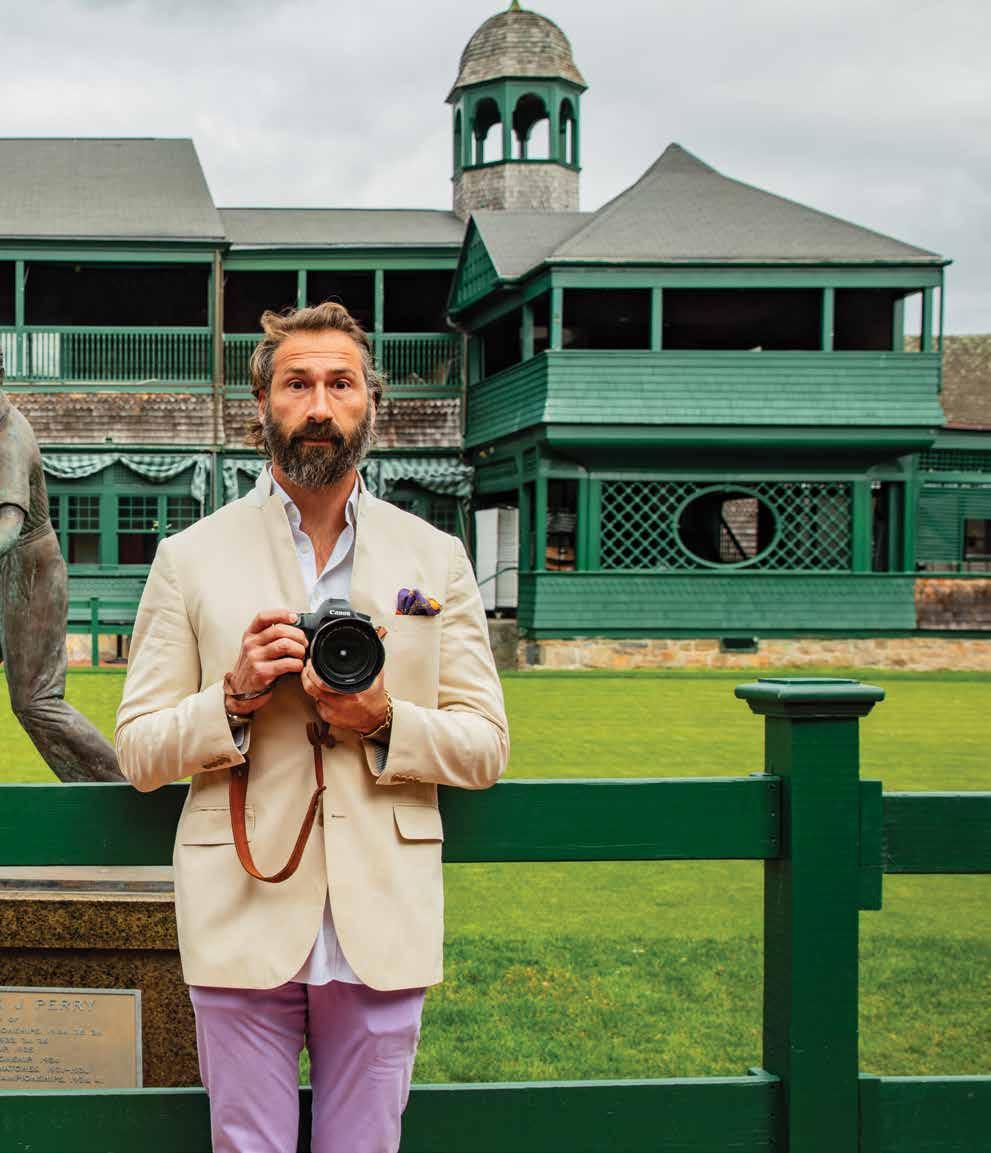

“Underneath everyone’s perception of its wealth, Newport has an understated elegance—the things that set it apart from every other summer destination— a charming patina from generations of being.”
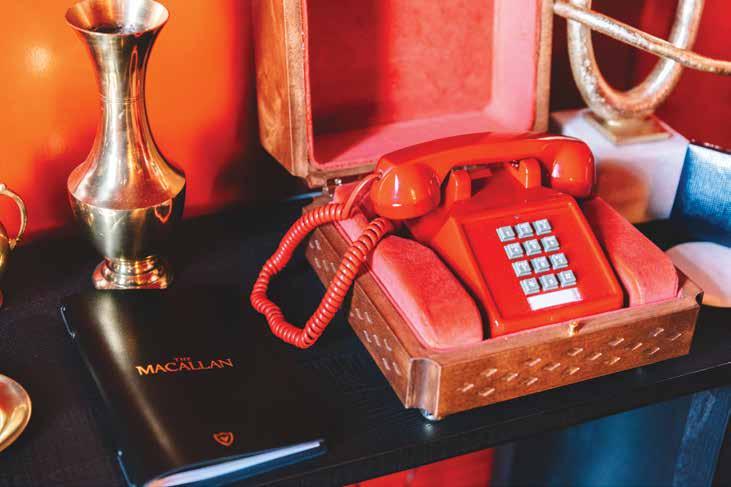 Left: Mele has a drink inside The Dining Room at The Vanderbilt. Above: A secret phone inside the hotel’s Reserve Room.
“Much like typewriters, old landlines have taken on something of a romantic quality, don’t you think?” asks Mele. Photo by Nick Mele.
Left: Mele has a drink inside The Dining Room at The Vanderbilt. Above: A secret phone inside the hotel’s Reserve Room.
“Much like typewriters, old landlines have taken on something of a romantic quality, don’t you think?” asks Mele. Photo by Nick Mele.
“It is a town that refuses to forget its history and tradition. Walking through people’s homes, you can almost see the ghosts of parties past—splendid cocktail affairs and marvelous dinners that have left a palpable imprint behind.”
 Above: Nick Mele on the steps of The Vanderbilt in his beloved Newport, Rhode Island. From this vantage point he can see the home of his in-laws, who live a stone’s throw away. Right: Nick Mele in the mirror of The Dining Room at The Vanderbilt. Photo by Nick Mele.
Above: Nick Mele on the steps of The Vanderbilt in his beloved Newport, Rhode Island. From this vantage point he can see the home of his in-laws, who live a stone’s throw away. Right: Nick Mele in the mirror of The Dining Room at The Vanderbilt. Photo by Nick Mele.
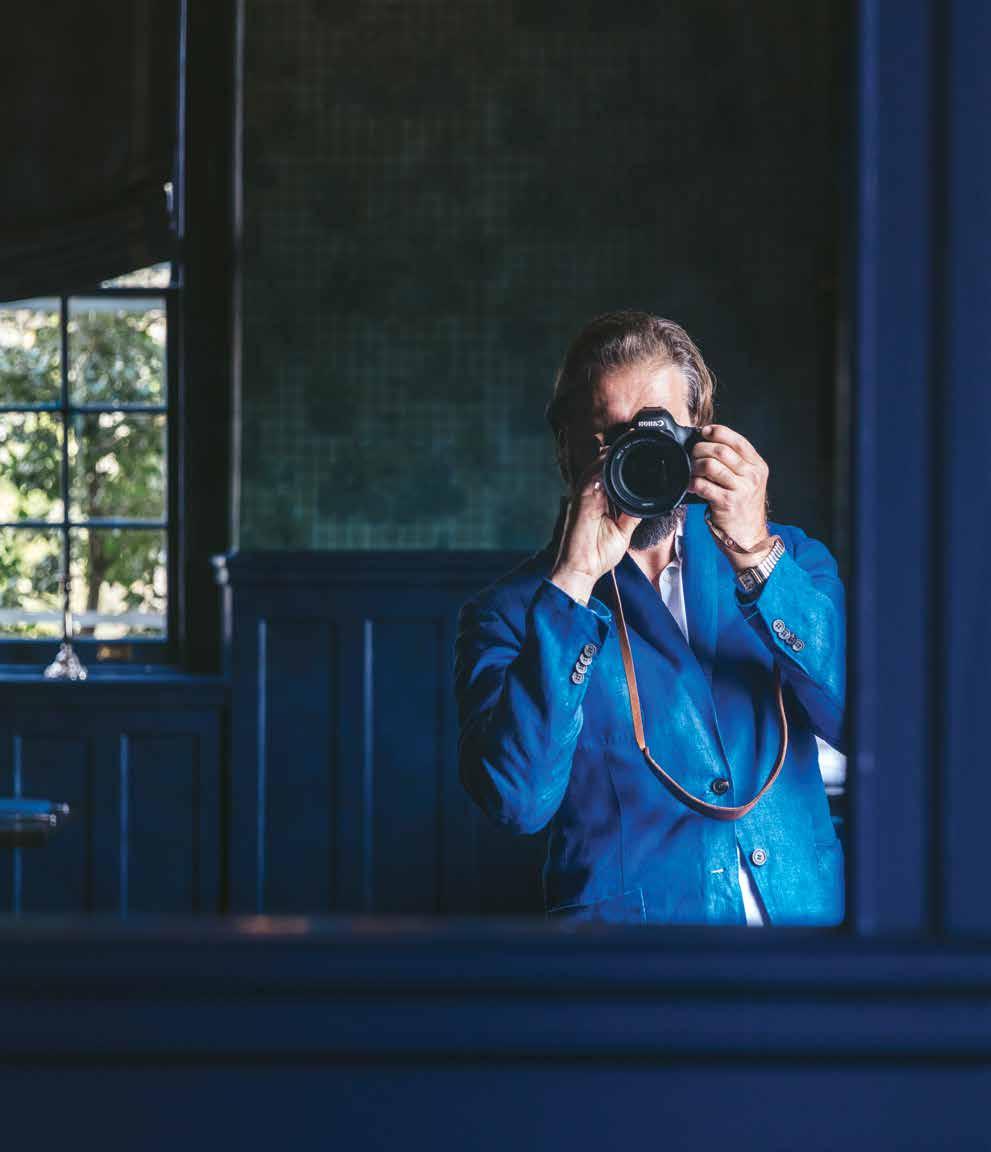

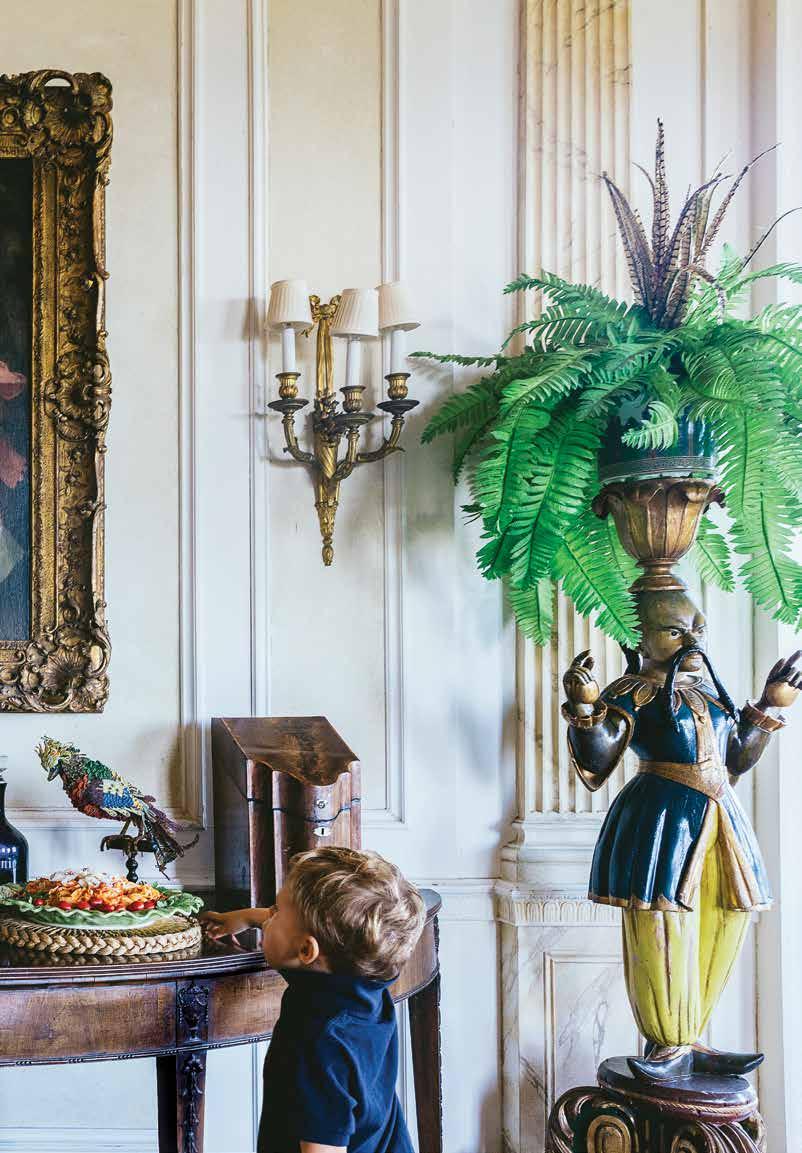
A
Image
from
Summer in Newport
“I appreciate Newport’s respect for conservation, connection and multigenerational entertaining in the face of an ever-evolving present and future.”
 Left: Nick Mele unlocks the secret closet inside the The Vanderbilt’s Parlour.
Right: Mele is transported to another era via The Green Hour, an absinthe experience inside the Parlour.
Left: Nick Mele unlocks the secret closet inside the The Vanderbilt’s Parlour.
Right: Mele is transported to another era via The Green Hour, an absinthe experience inside the Parlour.

 Creative Director Wes Gordon (in black) at home in Connecticut with husband Paul Arnhold. Photo by Lindsay Thompson.
Creative Director Wes Gordon (in black) at home in Connecticut with husband Paul Arnhold. Photo by Lindsay Thompson.
A Portrait of SMALL-TOWN SPLENDOR
The creative director of Carolina Herrera shares his love for this beautiful corner of the world. From topflight dining to destination shopping, the lush and gentle hills of western Connecticut make Washington a quintessential New England gem.
The tranquil Litchfield Hills have been enticing travelers for decades, a green escape for well-to-do New Yorkers, frequented by luminaries such as Meryl Streep, Danny Meyer, Oscar and Annette de la Renta, Diane von Furstenberg, and Carolina Herrera Creative Director Wes Gordon, who calls the place home.
Nestled amid the serene landscapes of Litchfield County, its rolling hills and whispering trees, Gordon finds solace and inspiration in the tranquil beauty of rural Connecticut. Here, far from the frenetic pace of the fashion world, he has cultivated a sanctuary where his creativity can flourish and his vision can take flight.
It makes perfect sense, once you dig deep into Gordon’s philosophy about life and design. “The pursuit of beauty should be celebrated, never dismissed as frivolous or unnecessary,” he says. “The world is overflowing with ‘things’—if one is going to bring something new into existence, it should be special, beautiful and perfect; nobody needs more stuff.”
In that way, charming Washington, Connecticut, and Gordon’s home there, certainly fit the bill. Special. Beautiful. Perfect. His life in the state is purposeful and free of clutter.
So it is with his work, as well—for each collection at Carolina Herrera, he strives to celebrate the transformative power of fashion, to imbue his designs with a sense of reverence and purpose. “My design approach is to make something beautiful,” he says of the looks he creates for the fashion house known for its impeccable style and bold elegance. “To make clothes that make a woman feel gorgeous, confident and empowered.”
As Gordon continues to shape the future of Carolina Herrera with his distinct vision in the quiet elegance of Washington, Connecticut, he has found not only a home but a source of endless inspiration for his creative endeavors. Despite a hectic schedule (shows at New York and Paris Fashion Week), the fashion designer answered some questions about why he chose the town he now calls home, and what he loves most about it.
69
PHOTOS BY WILLIAM KANER TEXT BY AARON SHORT
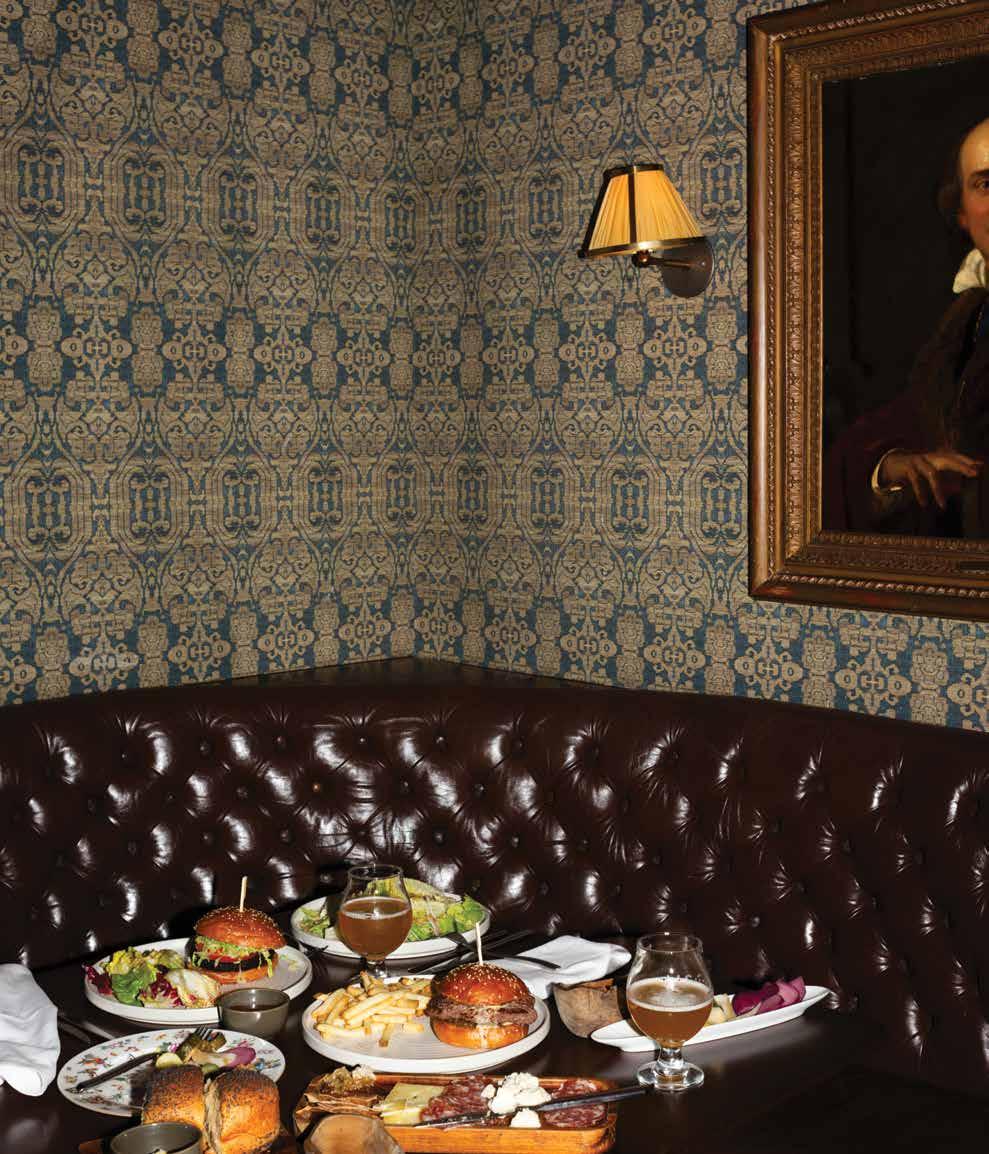
“The pursuit of beauty should be celebrated, never dismissed as frivolous or unnecessary.”
—WES GORDON, CAROLINA HERRERA’S CREATIVE DIRECTOR
What first drew you to western Connecticut and Washington? Why did you choose it to make a home?
Wes Gordon: My husband grew up in New York City and he and his family would spend their weekends in Roxbury, Connecticut. I got to know the area through him and fell in love with it. When a property adjacent to his family came up for sale, it was fate.
What’s a day in your life out in Washington look like? What are you doing, where are you going, who are you seeing? Being outside as much as possible—we are usually quite reclusive and spend time on our property. We are lucky to have many animals and our two children love to spend the day outside playing with the horses, chickens and goats.
What’s your favorite thing to see or do in the area?
Discover and explore…drive down roads I’ve never been on before, visit a new shop, try a new restaurant.
Tell us something about the area you hadn’t suspected before you lived there that’s proven true. How naturally beautiful it is. Considering you’re under two hours away from Manhattan, the landscape and topography feel worlds away.
Living in that part of Connecticut and being part of the community there, how does the natural environment and local culture influence your creative work?
I have many friends in creative industries who also spend weekends in the area so I’m always inspired by their talent and initiatives. Also, creativity benefits so much from moments of pause and calm, two things I’m able to find when I’m in Connecticut.
Favorite place in the area to eat: If we’re going out to dinner, it would be either to the Mayflower [Inn & Spa], G.W. Tavern or CT [Community Table].
Favorite place to shop in the area: Privet House and Plain Goods—both are beautiful stores with an extraordinary curation in picturesque New Preston.
Finally, any advice for aspiring fashion designers or creative directors? Trust yourself. This is an idea we all talk about often, but rarely have the courage to really act upon. You have to be your own North Star; it’s your uniqueness that will make you successful, and trying to emulate other successful people runs the risk of dampening your own fire. Trust yourself, listen to yourself—you’ll never make everyone happy so therefore you cannot look to others for your own validation.
71
A corner booth at Mayflower Inn & Spa’s Tap Room, which serves
delicious pub fare.
Washington, Connecticut, and the surrounding region has become a destination for striking design, world class dining, and rejuvenating wellness activities, including at what may just be the most luxurious resort in New England, Mayflower Inn & Spa, Auberge Resorts Collection.
The food alone makes it a destination. If you’re a morning person and like to keep things light, Po Cafe, whose floor-to-ceiling windows look out on the historic Washington town green, dishes out a stellar acai bowl with bananas and blueberries. The coffee, roasted locally by Washington’s Zero Prophet and Bantam’s Krafted Brew Lab, is no slouch, either.
From there, don’t be afraid to sip a glass at The Owl Wine & Food Bar. Owner Ryan Cangello recommends pairing a French chenin blanc with an acorn squash fondue.
“It’s a roasted half-acorn squash with a gruyere fondue, so you can kind of mix it all together and it’s served with crudites and crostini— and people absolutely love it,” he says.
Do consider a meal at the historic G.W. Tavern before you head home. Built inside an 1850 colonial home, the presidential outpost serves seasonal specialties like duck leg cassoulet and vegetarian Cobb salad. And if you’re in the mood for exquisite New American cuisine, Arethusa al Tavolo in Bantam never disappoints.
Then there’s Bantam’s Materia Ristorante, where you’ll find seafood items like
yellowfin tuna crudo with osetra caviar and linguine with manila clams are standouts. “Linguine alla vongole is a signature dish. It’s out-of-this-world good,” Chris Hodson, Materia’s dining room manager, says.
Finally, in addition to being a fantastic option to hang your hat, Mayflower Inn & Spa offers some of the best victuals in the state. Nibbles and a cocktail in The Tap Room can yield quickly to a foray to The Garden Room, where you’ll be pampered by carefully considered creations. (Don’t worry about a jacket and tie: the dress code is “country casual.”) Previous menus from guest chefs have seen freshly shucked oysters, roasted leeks, three cheese gnudi with delicata squash, and fried quail with kale and sunshoke slaw and sweet chili sauce. A brioche ice cream sandwich also made guests swoon.
Lest you fear there’s little but wining and dining to be done here, the culture, crafts, and hiking in Washington and the surrounding region will assuage that notion swiftly. Upscale home goods and furniture shops have clustered along East Shore Road since the 1990s, and a new crop including Plain Goods, Anthony Todd Home, Pergola, and Privet House have garnered attention from New York Times Style magazine tastemakers.
All the stores are independently owned—and most of the time, the owners are present to help you select the perfect olivewood serving bowls and Danish-designed flatware to go with your antique folding harvest table. Privet House owner Suzanne
72
The Wicker Patio at Mayflower Inn & Spa, Auberge Resorts Collection.

Cassano says her shop is known for its eclectic German brush collection and handwoven baskets, but she doesn’t buy anything for the store she wouldn’t use herself. “Everybody has their own point of view and as a result of that each store has its own personality,” she says of the shops.
Beyond dining and shopping, you simply must hit the Appalachian Trails. About 52 miles of the iconic 2,190-mile path run through the northwest corner of Connecticut, but you don’t need to be a veteran mountaineer to tackle it. Dave Bruno, who maintains the region’s trails as head of the Appalachian Trail Mountain Club’s Connecticut chapter, recommends an easy mile-and-a-half trek. Park at the lot off Bulls Bridge Road and Route 7 in Kent, head over the Bulls Covered Bridge, which crosses the Housatonic River, and follow the blue-blazed trail for a quarter mile. You’ll arrive at the Ten Mile River Lean-to, a well-loved campsite frequently used by thru-hikers. (There’s a more challenging six-mile excursion that begins at Route 44 in Salisbury, and fearless hiking fanatics can try Bear Mountain, the tallest point in the state.)
And if the season is right, don’t spend so long on the trail, at the bar or collecting gorgeous wares that you fail to watch vintage stock cars at Lime Rock Park, where Paul Newman once raced. It’s a magical way to finish a visit to a place that would be more historic if it didn’t feel so full of life.
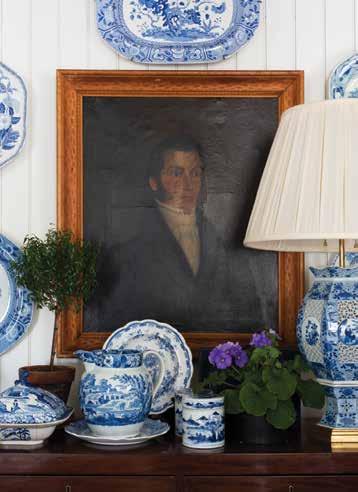

74
Top: Inside Plain Goods, a lifestyle shop in New Preston, Connecticut, founded by Michael DePerno and partner Andrew Fry.
Bottom: The New American cuisine at G.W. Tavern should simply not be missed.
Right page: The wares on offer at Plain Goods.
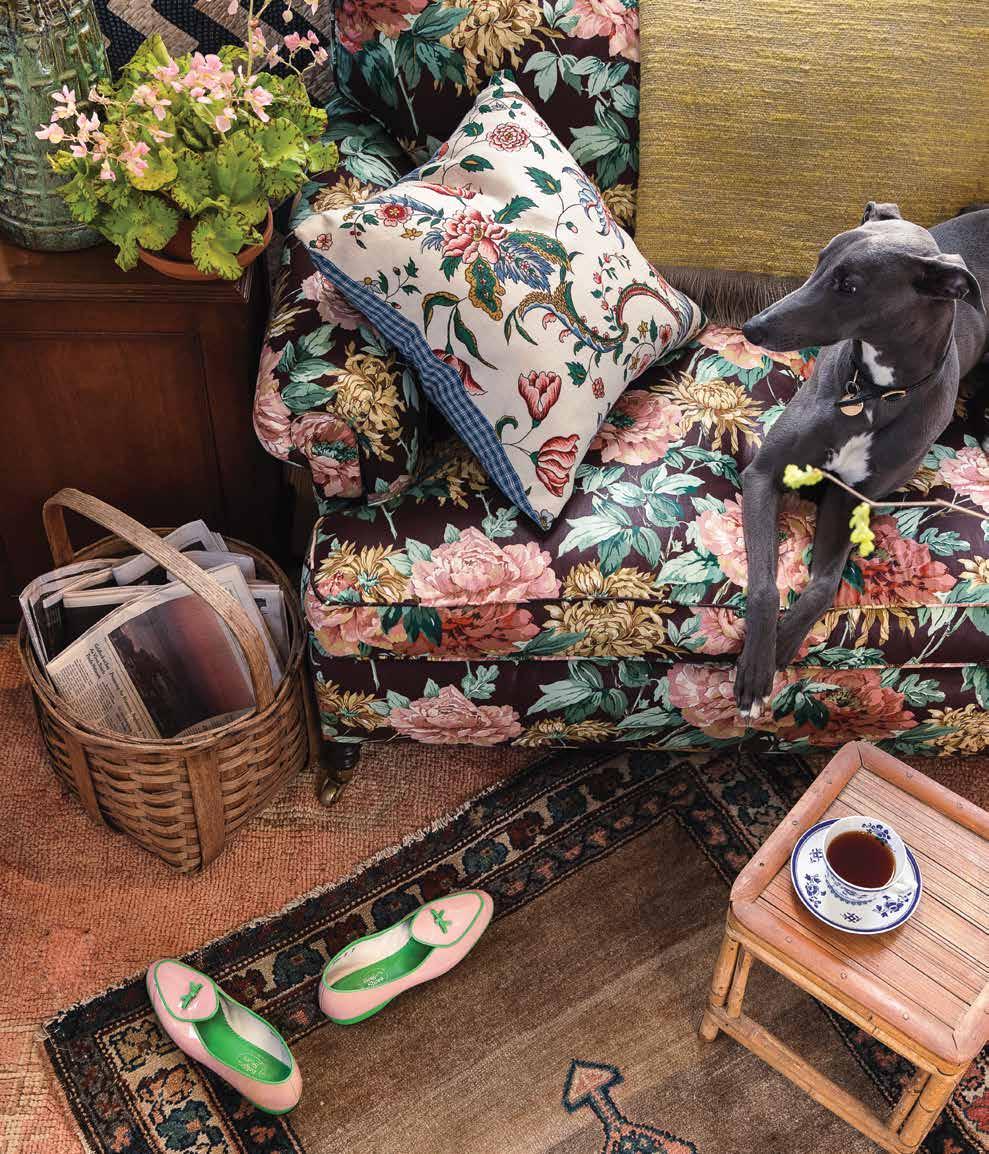
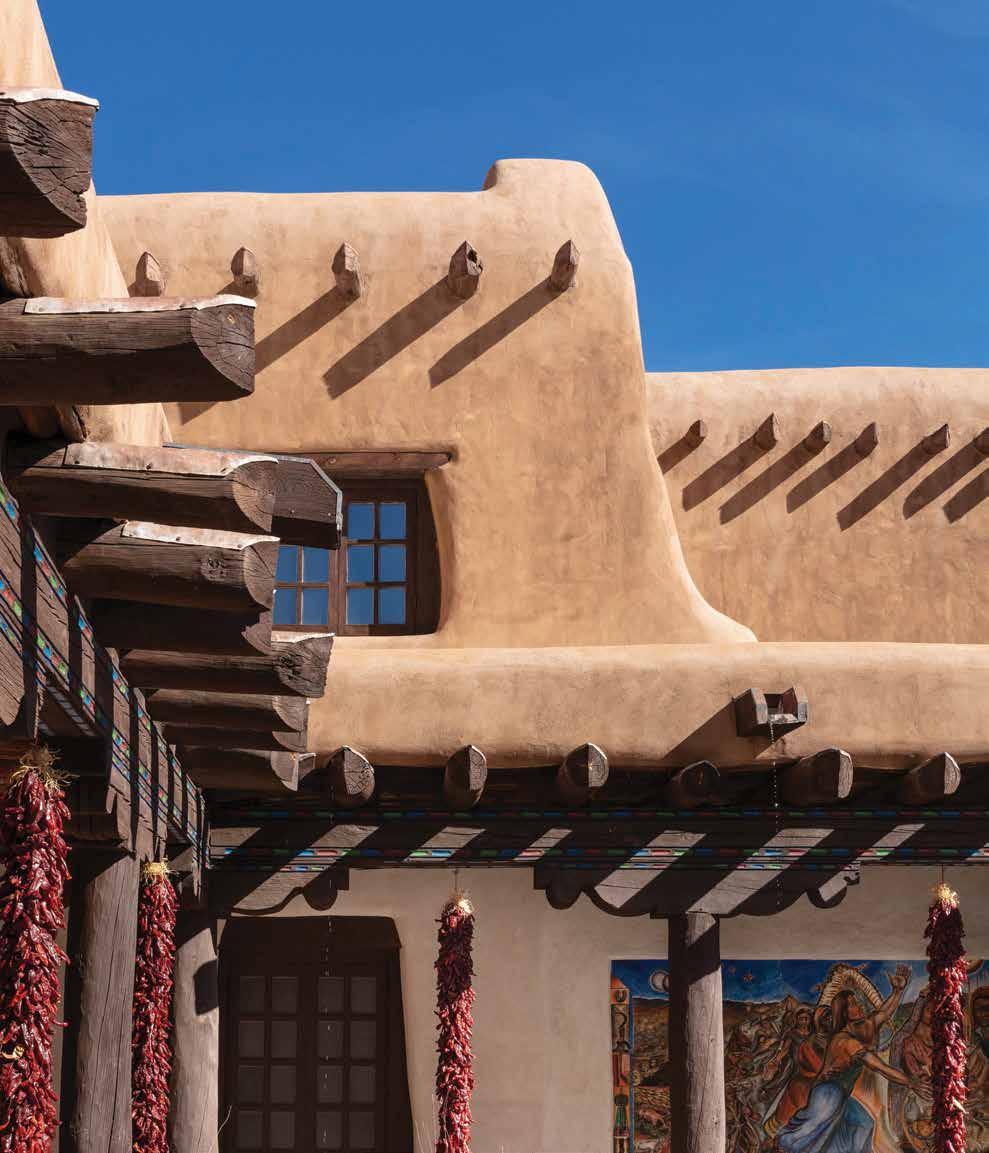
The Creative Soul
With an influx of artists and entrepreneurs, the relaxed, remote, tony capital continues to reimagine itself.
OF SANTA FE
On the whitewash Gothic altar of Bishop Lamy’s Chapel, in the foothills north of Santa Fe, Roxana Villa traces her bare fingers through mounds of ground juniper berries, piñon needles, cedarwood, osha root, creosote and sage.
An artist and aromatherapist who moved to New Mexico’s capital in 2017, Villa is crafting incense rooted in this land. After mixing the herbs—plus frankincense, an homage to the Egyptians who pioneered the art of perfumery—she binds it with a dab of local honey. Once the ball of herbs is lit, cords of sweet, earthy, olive smoke redolent of the surrounding Sangre de Cristo Mountains curl up to the chapel’s century-old vigas.
The incense-making class is one of a host of experiences offered by local haven Bishop’s Lodge, Auberge Resorts Collection, which invites guests to delve into the culture and history of Santa Fe, one of America’s oldest cities. The chapel, which was built to be a private retreat in 1874 by the first Roman Catholic archbishop of Santa Fe, Jean-Baptiste
Lamy, and later became the centerpiece of the original 1918 Bishop’s Lodge, is an apt setting for visitors to get situated. Even as this place brims with history, it invites everyone who passes through to experience something fresh and urgent.
“Art, environment, culture—I think that’s what brings a lot of people to Santa Fe. It’s what brought me,” Villa says. “And it’s that continuing influx of people and ideas that keeps Santa Fe interesting.”
Santa Fe has long been a melting pot of ideas and aesthetics, beckoning for centuries to entrepreneurs, wayfarers, and free spirits. It first drew artists from the East Coast in the 1880s to document Native American culture, followed after the turn of the century by a second wave of photographers and painters—including Georgia O’Keeffe—who were drawn by the patchwork of cultural influences and the sage-fringed high desert space and light. The city is now host to some 250 dealers and galleries, making it the third-largest US art market after the much-larger New York
77
The Santa Fe Plaza shops.
JEN JUDGE
TEXT BY AARON GULLEY PHOTOS BY
and Los Angeles. And in the last several years, Santa Fe has continued to evolve and develop as a new generation of creatives and entrepreneurs find their way here.
Case in point is the Santa Fe Plaza, the oneblock square where New Mexico’s capital sprang up some 400 years ago. From the center of the square, you can see the Santa Fe Indian Trading Company, Shiprock Gallery—one of the finest purveyors of Navajo jewelry and art in the city—and the New Mexico Museum of Art, which houses an extensive collection of works by the Los Cinco Pintores, five painters who helped establish Santa Fe as an art colony in the 1920s, as well as paintings by O’Keeffe, woodblock prints by Gustave Baumann and notable works of other pioneering artists of the American West.
But in a testament to the city’s relentless evolution, last fall, the museum opened Vladem Contemporary, a cantilevered concrete and steel offshoot in the nearby Railyard Arts District dedicated to abstract, conceptual, video, and interactive art of the state and southwest. “Shadow and Light,” the opening show in the $20.2 million museum, fills the entire 35,000-square-foot facility with works from the last 50 years by seminal New Mexico figures such as Larry Bell and Nancy Holt, as well as more contemporary artists such as Leo Villareal and Virgil Ortiz. “The goal is to showcase the modern work of this region, which is every bit as vibrant and
Roxana Villa stirs a mixture of crushed juniper berries, piñon needles, sage, cedarwood, osha root and creosote with her hand to create incense at Bishop’s Lodge, one of the experiences on offer at the hotel.
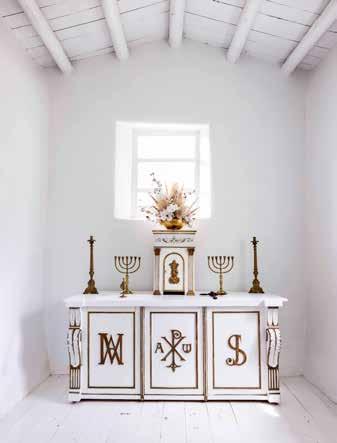
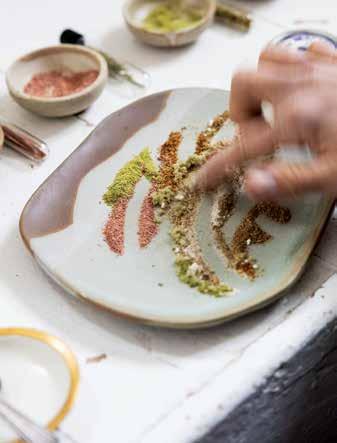
78
Top: The altar at Bishop Lamy’s Chapel, at Bishop’s Lodge, Auberge Resorts Collection.
Bottom:
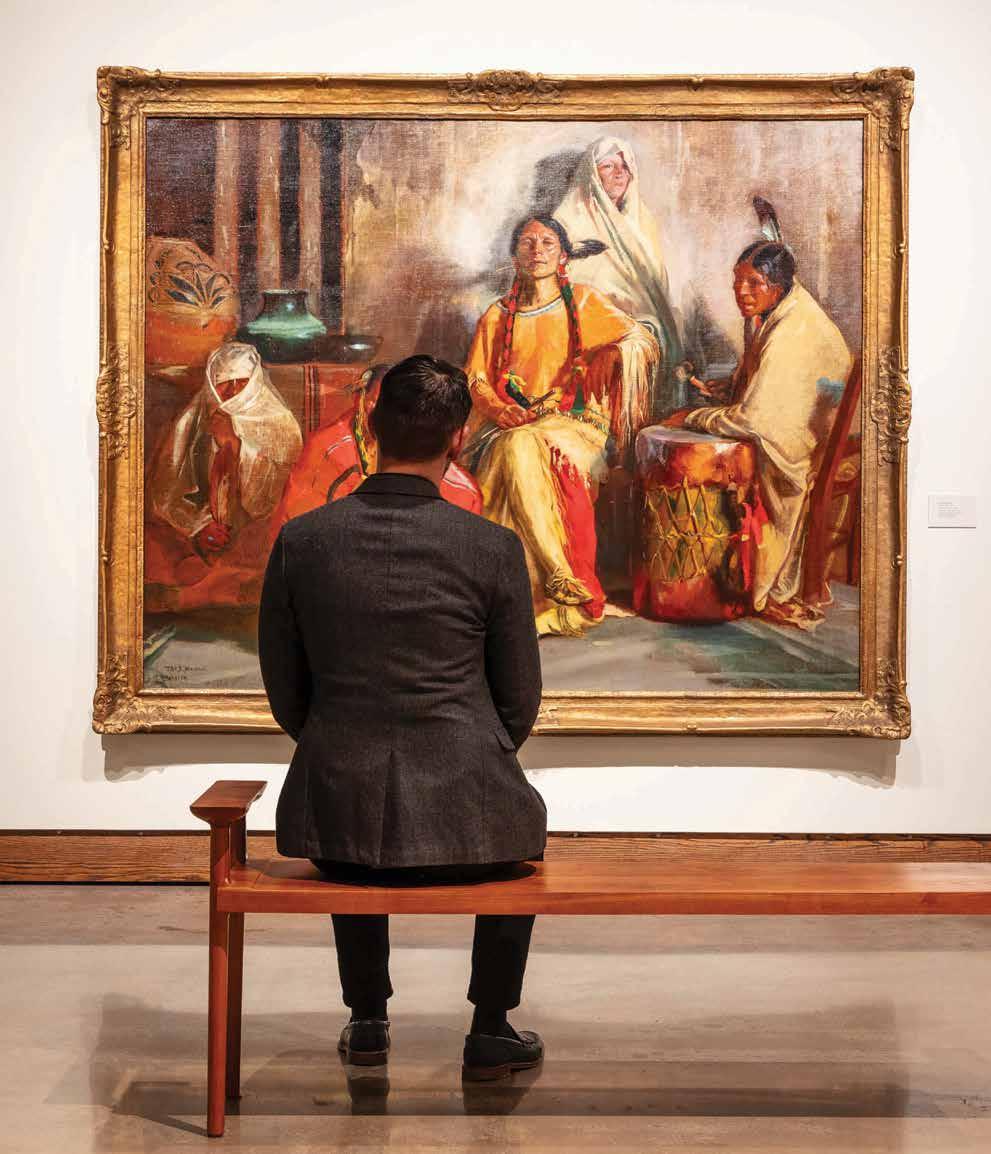
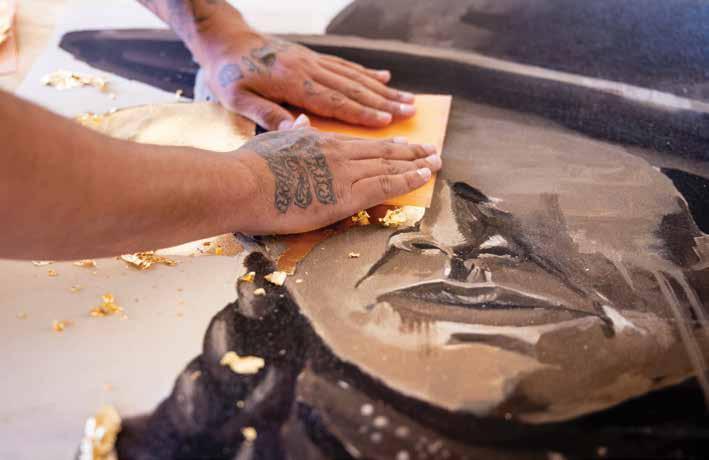 Above: Artist George Alexander Ofuskie at work. Right: Aritst Amy Denet Deal’s 4KINSHIP is the first and only indigenous-owned business on Santa Fe’s gallery-packed Canyon Road.
Above: Artist George Alexander Ofuskie at work. Right: Aritst Amy Denet Deal’s 4KINSHIP is the first and only indigenous-owned business on Santa Fe’s gallery-packed Canyon Road.
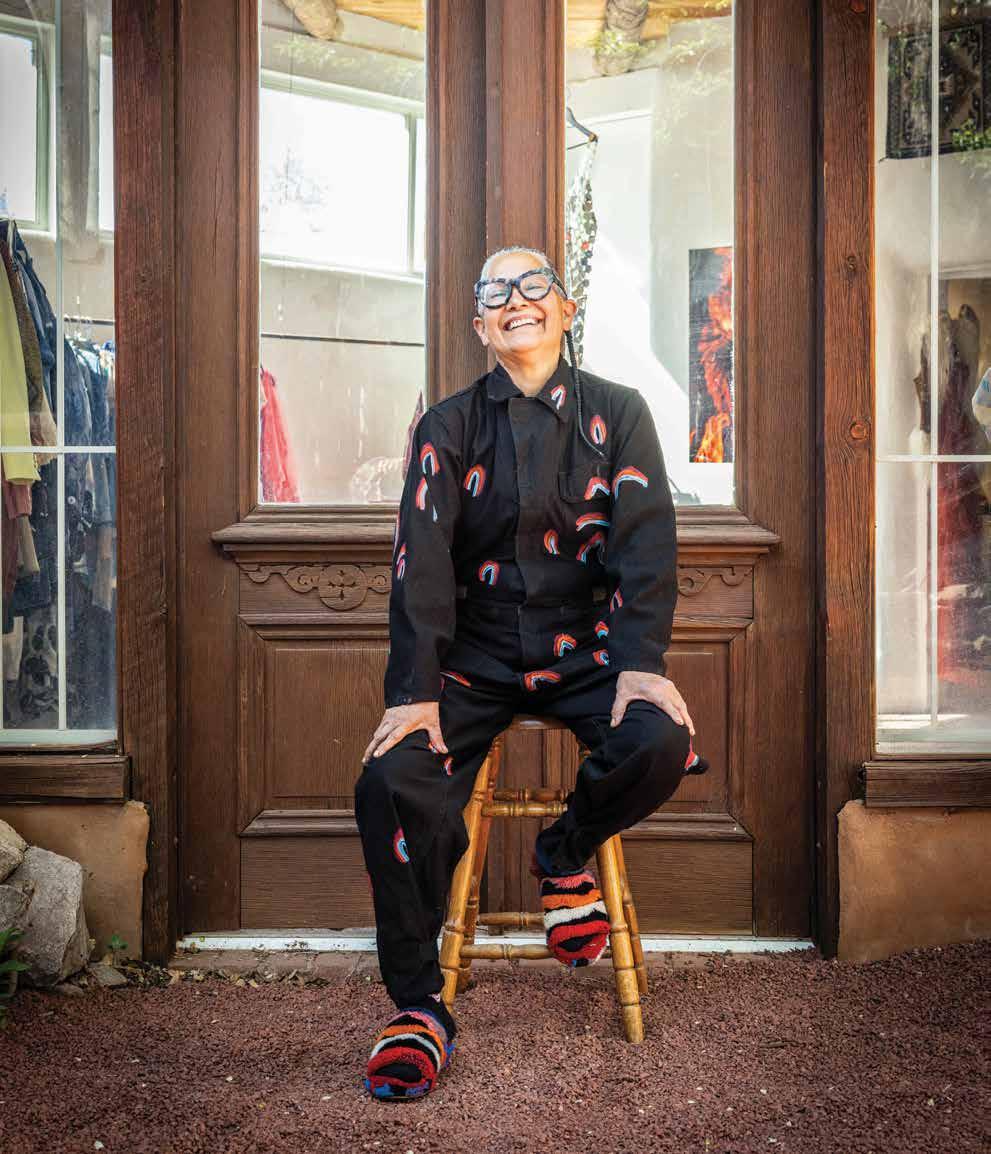

“Art isn’t about the object you make...it’s the conversation around that object.”
—ARTIST GEORGE ALEXANDER OFUSKIE
important as the historical works downtown,” a docent explains during a recent visit.
Such juxtapositions can be found all over town. Beneath the timbered arcades of The Plaza’s long, low cinnamon-colored buildings, Native American traders huddle on brightly patterned blankets and peddle silver and turquoise jewelry, like a century-old scene out of rural Mexico. A block away, 34-yearold George Alexander Ofuskie, an up-andcoming Muscogee Creek artist, paints in his convival working studio that’s open to the public. Ofuskie’s astronaut series, which explores perspectives on culture, borders, race and politics through a tableaux of spacehelmet clad figures in western and urban landscapes, landed him spots in the National Gallery and on the cover of the prestigious 2023 SWAIA Santa Fe Indian Market.
During an afternoon visit to his studio, Ofuskie scrolls through the 1930s murals of Oscar Howe and Flatstyle paintings by Fred Beaver, a modernist approach rooted in Plains hide painting that are currently inspiring his work. He stresses tradition and culture, but also emphasizes the importance of questioning beliefs, expanding his vision, and making things that are accessible. He says he’s just as excited about the collection of Flatstyle stickers he’s working on as the wall-size paintings on his easel and stacked against the walls.
“Art isn’t about the object you make,” Ofuskie says. “Art is the conversation around that object.” It isn’t linear or about any certain medium or only for galleries, he continues. Art can be anything and everywhere.
That sense of expansiveness pervades the Santa Fe scene. The Santa Fe Opera is every bit as iconic as those in Sydney or Vienna, but here it’s open-air, with views of the Jemez Mountains and always preceded by dress-up opera house parking lot tailgate parties. And even places with no immediate connection to the arts are inspired by the town’s creative and cultural bent, such as the historic Mesoamerican drinking elixirs and exquisitely decorated chocolates at Kakawa and the Japanese garden-inspired soaking tubs at Ten Thousand Waves Spa, which also recently underwent a major renovation.
But if any one place typifies the fresh creative and collaborative energy in town, it’s 4KINSHIP, the first and only indigenous-owned business on Santa Fe’s gallery-packed Canyon Road.
Opened in summer 2022 by the Diné artist and fashion designer Amy Denet Deal, the store sells a vibrant assortment of Deal’s handmade and upcycled clothing and designs, while simultaneously serving as an incubator and showcase for young indigenous artists. Where most galleries
83
There’s more to Santa Fe than meets the eye, which visitors will find on the resident trail system at Bishop’s Lodge.
take a 50 percent commission, Deal gives guest artists in her space 100 percent of proceeds, describing it as her duty to help foster native art. She also uses the revenue from her own work to fund development projects on the Navajo Nation, including a youth skate park. “Coming to Santa Fe was one of the best things I ever did,” she says. “It’s such a vital and creative community.”
Bishop’s Lodge, Auberge Resorts Collection, has taken new inspiration from these vibrant surroundings. The 100 rooms have been fully renovated with native fabrics, local textiles and artifacts, and accents of aspen and other indigenous woods. And the new restaurant, Skyfire, serves an eclectic menu that blends local flavors with reimagined traditions from lesser-known parts of Mexico and Central America. Tostadas are festooned with yellowtail, pumpkin seeds, and guacamole; New Mexican lamb is braised with local wild mushrooms and served over grits; delicious margaritas are spiced up with apricots and Hatch chile; and hot chocolate is a dark, sumptuous, cinnamony blend passed down from one of the pastry chef’s Diné grandmothers. The bold flavors at the restaurant are as rich, refined and colorful, as Santa Fe’s broad, historic art palette, and should not be missed.
Bishop’s Lodge’s resident trail system is also a microcosm and gateway to the vast lattice of hiking and biking tracks across Santa Fe’s foothills and mountains. The resort has revamped and expanded the singletrack on its property, which
wends across piñon- and juniper-stippled foothills. It’s a great little system for strolling, but the real prize is access to some 800 miles of trail. And there’s something here for everyone, including fast, flat gravel riding on the Caja in winter and fall, rollercoaster desert singletrack at La Tierra and Dale Ball, bikepark-style flows trails at Glorieta, and cool, shady, high-alpine singletrack where you can escape the heat of summer. There’s even rideable trail to the 12,409-foot Lake Peak, which grants access to a 12-mile ride downhill all the way back to Bishop’s Lodge. Based on the volume and variety of its trails, Santa Fe offers as much of an outdoor playground as it does art.
About that: on opening, the team at Bishop’s Lodge restored four wall-size paintings that had been tucked away for decades and nearly forgotten. The series, striking portraits of Native American characters in stylized environments, was painted by Warren Rollins, an early 20th-century artist whose work also hangs in the New Mexico Museum of Art. The story goes, before he gained notoriety, Rollins racked up a hotel bill at the Bishop’s Lodge that he couldn’t afford and paid the tab with these paintings. Rollins would eventually go on to become the first president of the Santa Fe Art Club and have an outsize influence on Western art.
But the tale’s power is in its simple truth: Santa Fe has been attracting creatives for over a century—and art and its sense of free spirit has long been the town’s currency.
Skyfire, the restaurant at Bishop’s Lodge, serves an ecclectic menu that blends local flavors with reimagined traditions from lesser-known parts of Mexico and Central America.
84
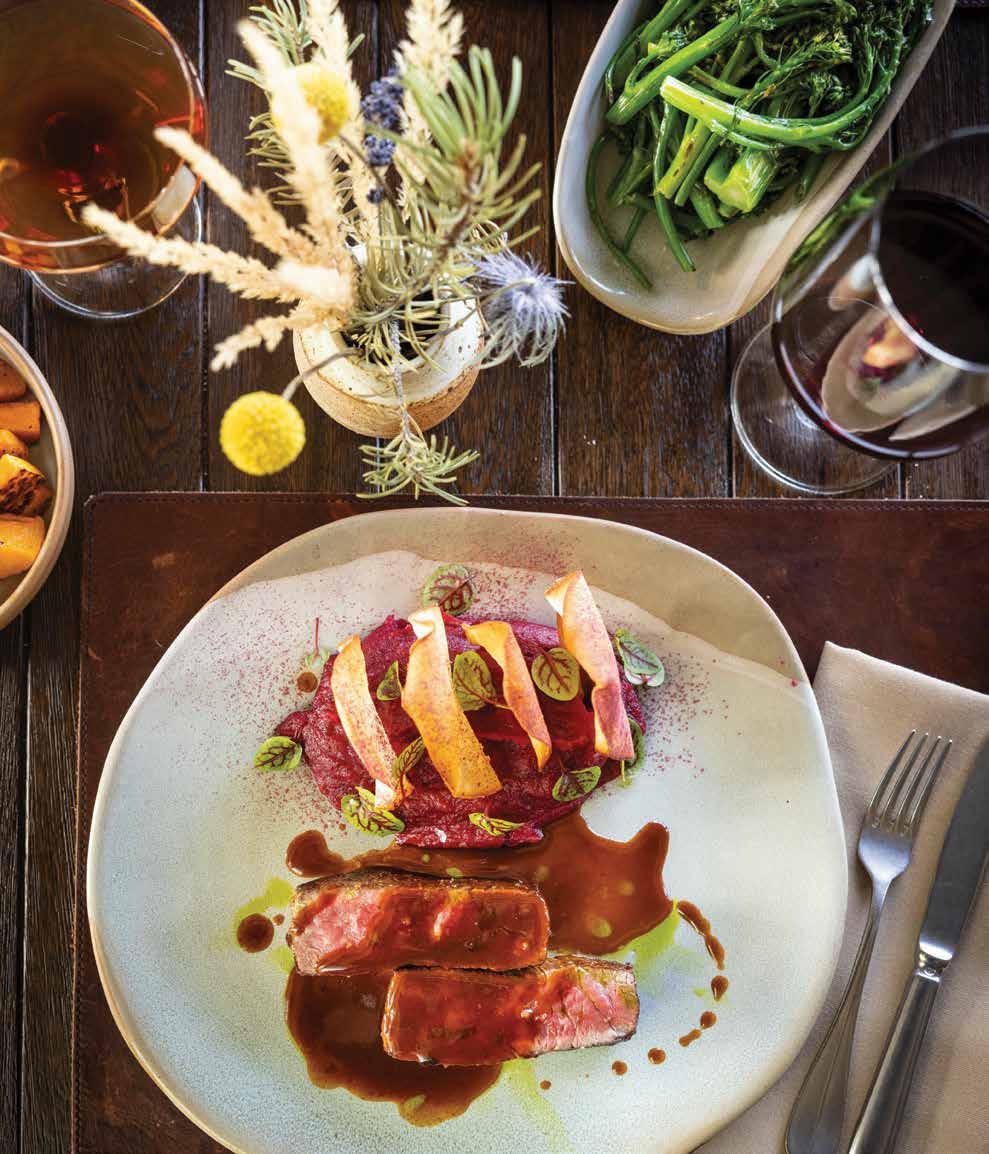
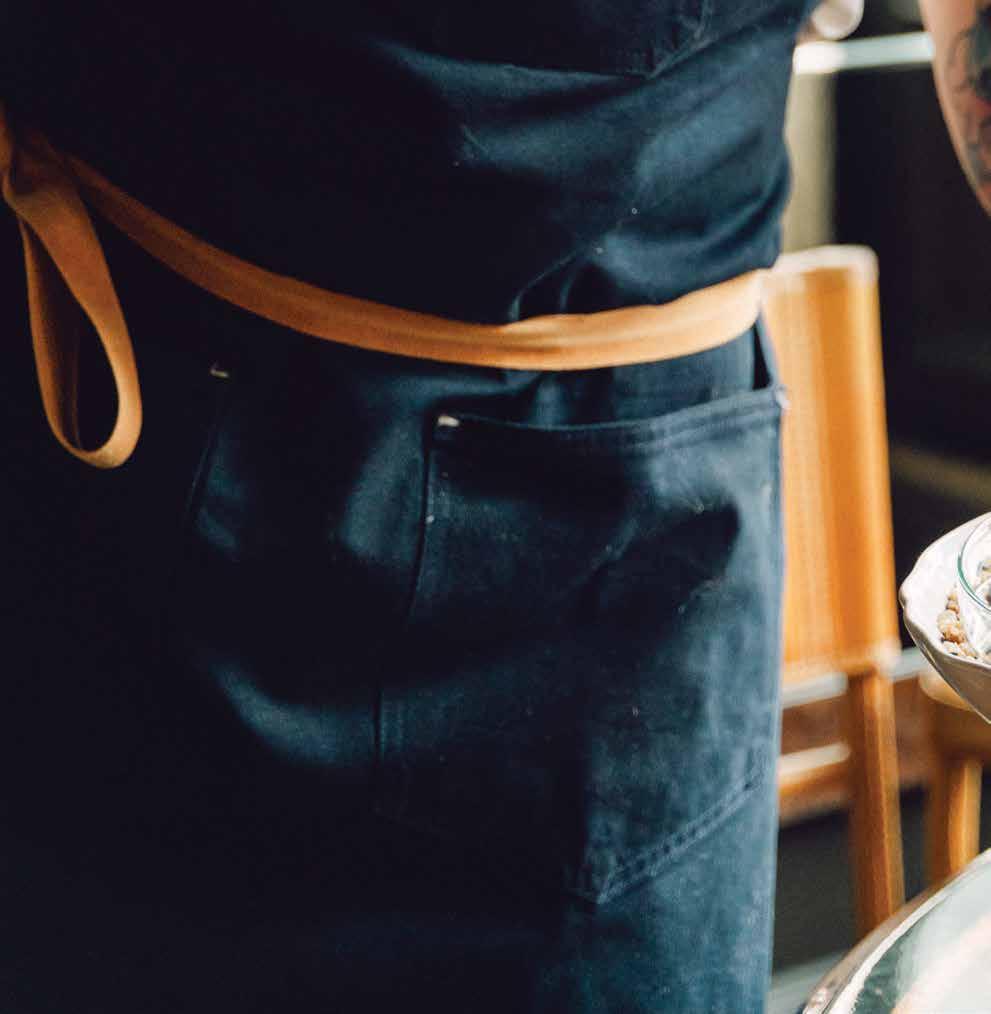 Photo by Trevor Trevino
SANTA BARBARA / PUNTA DE MITA / ASPEN
Photo by Trevor Trevino
SANTA BARBARA / PUNTA DE MITA / ASPEN
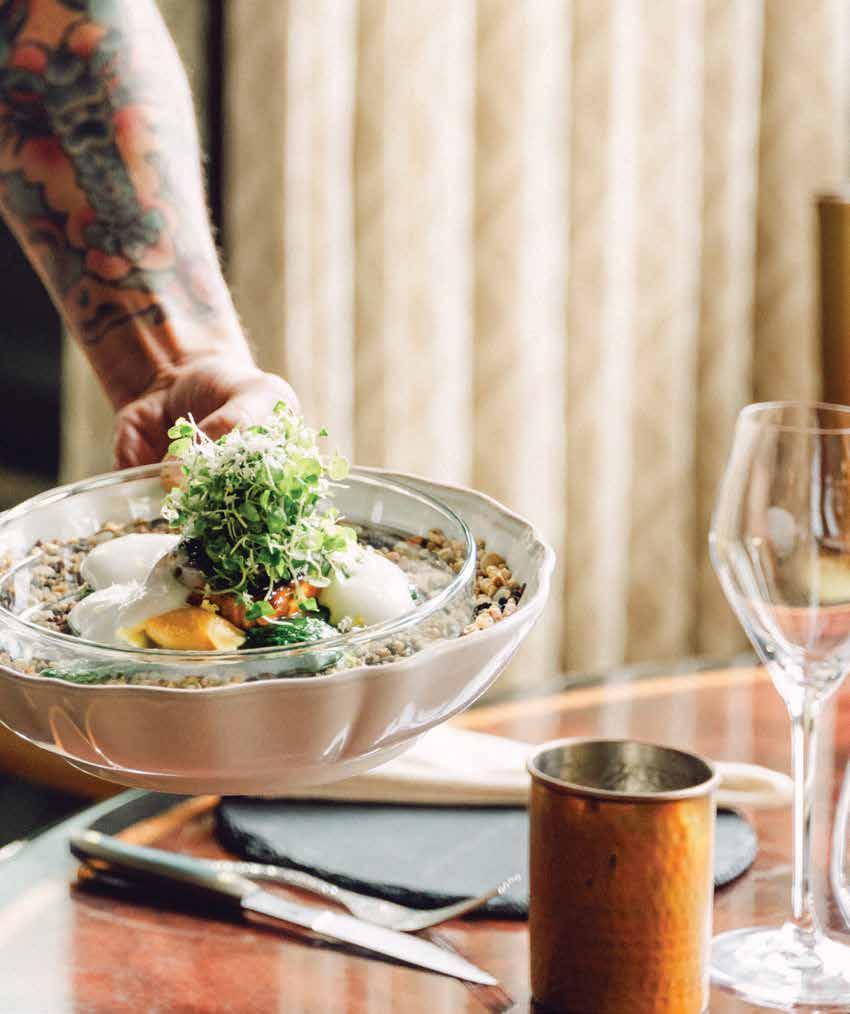
S
avor
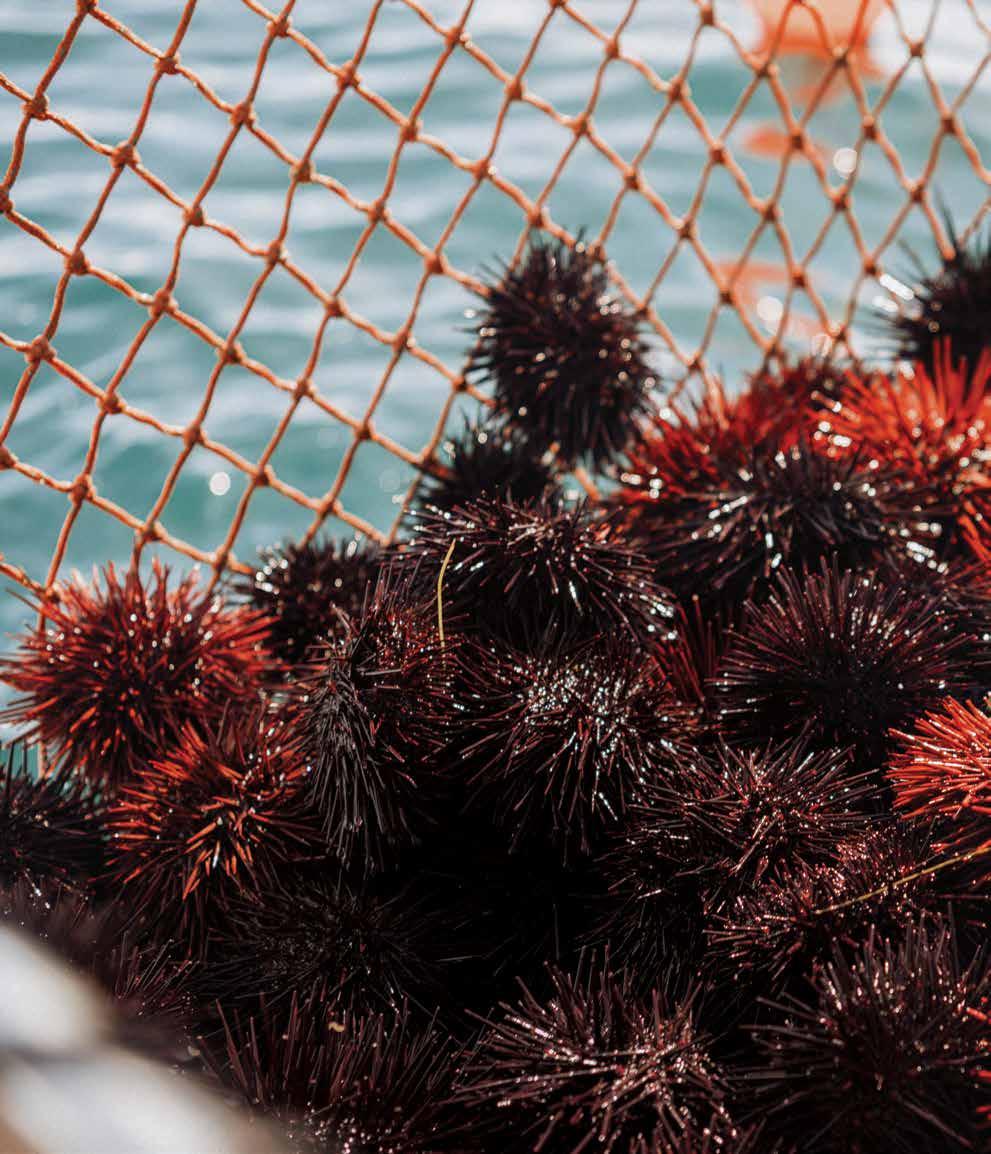
THE OPULENCE
The best sweet, briny, buttery delicacy in the world, uni, can be found in the Santa Barbara Channel.
OF EDIBLE GOLD
TEXT BY ADAM ERACE
PHOTOS BY TIM AUKSHUNAS

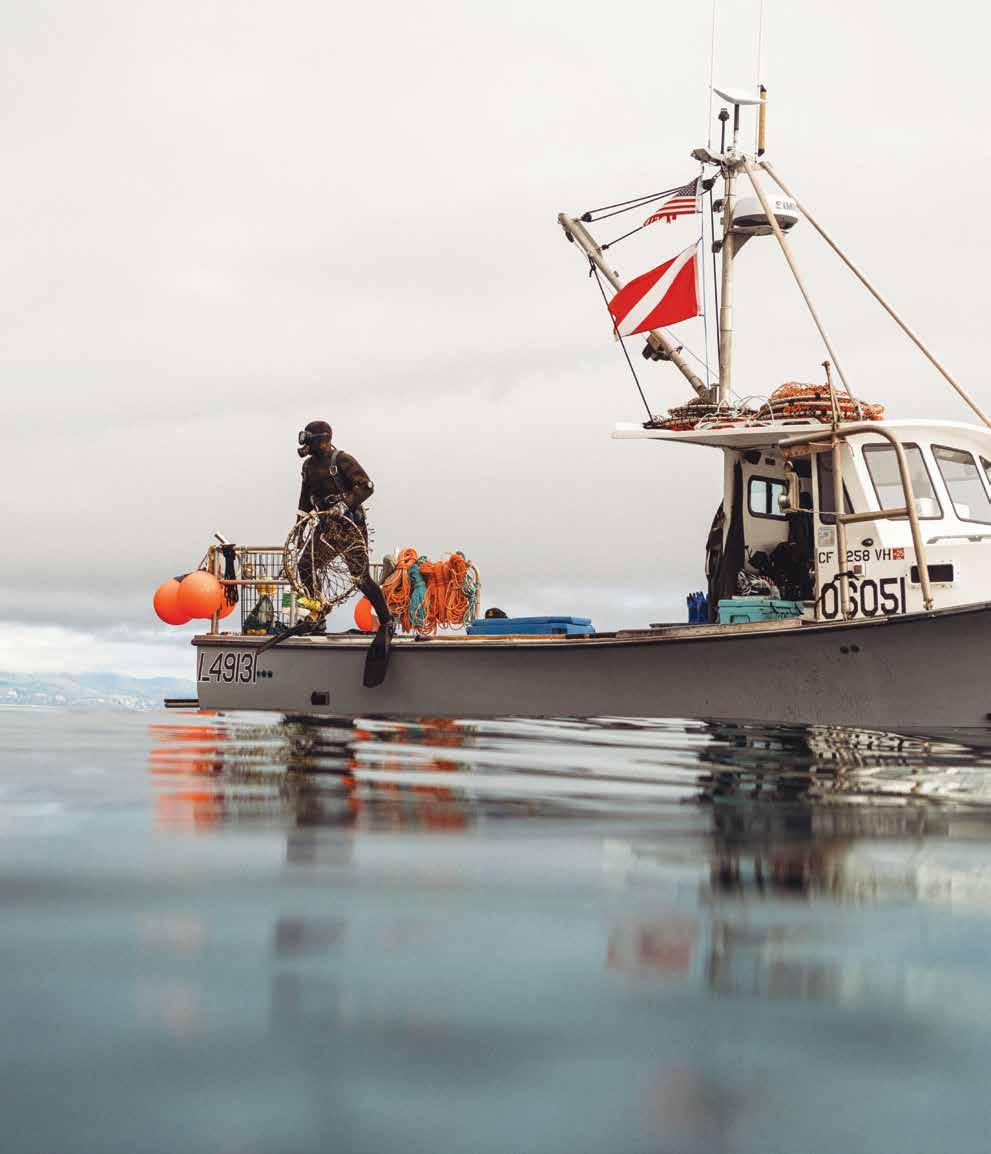 John Hoadley prepares to dive off his boat, Sol Rising, in search of delicate, delicious sea urchin.
John Hoadley prepares to dive off his boat, Sol Rising, in search of delicate, delicious sea urchin.

It’s still dark when John Hoadley sets out to go treasure hunting in the Channel Islands off Santa Barbara. The 40-year-old diver’s 32-foot lobster boat is newly christened Sol Rising, after his daughter, Soleil, but its captain is more veteran than newbie: For the past two decades, Hoadley has been corralling spiny lobsters, shy sea cucumbers, and, his primary catch, the world-famous Santa Barbara red sea urchins.
A couple hours after departing from the wharf, the second-generation diver drops anchor, straps on his gear, and plunges into the Pacific. Following in the flippers of his father, an avid amateur diver, Hoadley’s been ranging these waters since he was five years old.
Though the underwater terrain is as familiar as walking around his house, each hunt still makes him prickle with anticipation. “Once I start exploring, I find out really quickly whether there’s any urchins I want to harvest,” he says, cracking one open for a spot-check of its gonads—the velvety, Creamsicle-colored organs colloquially
referred to by their Japanese name, uni, in the culinary community. “Beautiful, goldenyellow lobes; that’s the prize product.”
Since late 2013, when an intractable mass of warm water began to emerge off the California coast—locals sometimes call the phenomenon The Blob—this prize product has become less plentiful and thus, more precious. Now, fishers and divers are retooling, changing their games to keep pace with the elements in their hunt for these delectable prey.
As Hoadley explains, “All up and down the West Coast of the United States, The Blob did a number on kelp forests,” the food of choice for red urchin world. Hoadley pivoted his business to sell his urchins directly to consumers and restaurants. Chefs and their customers, don’t seem to have a price ceiling when it comes to the primal experience of consuming this oceanic, multifaceted umami.
Take Chef Brad Matthews, who gets his urchin delivery right as dinner service is getting underway at his Iberian-accented restaurant, Bar Le Côte, in Los Olivos
91
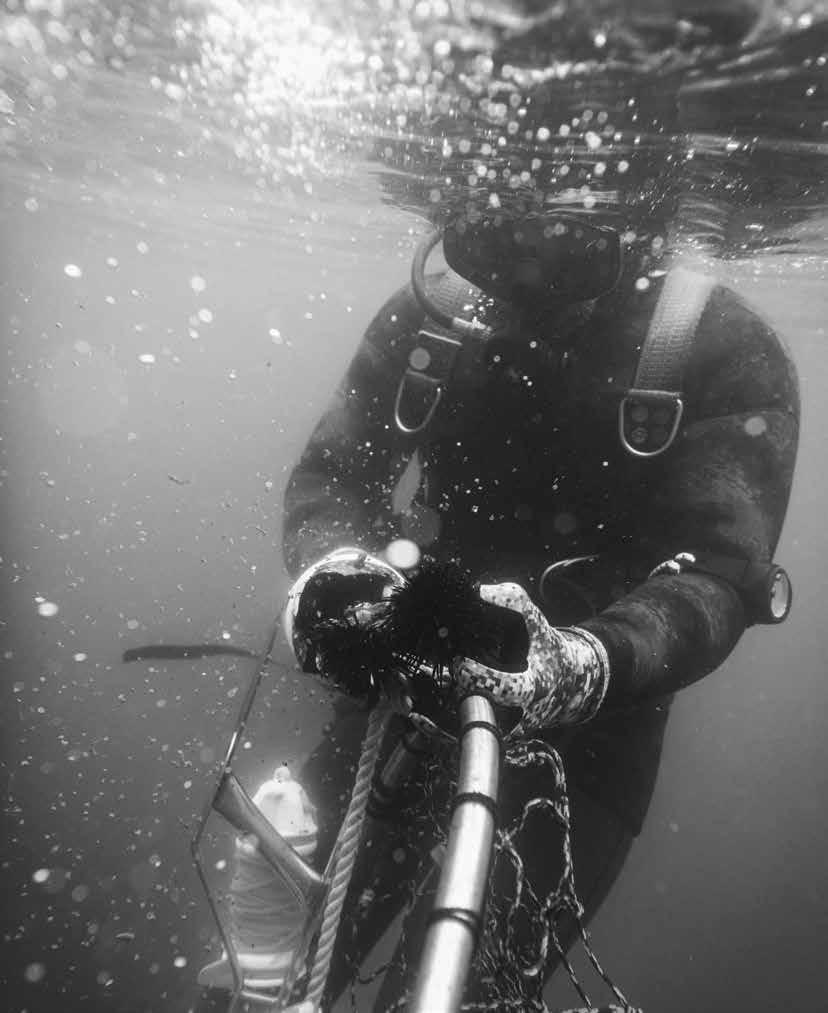

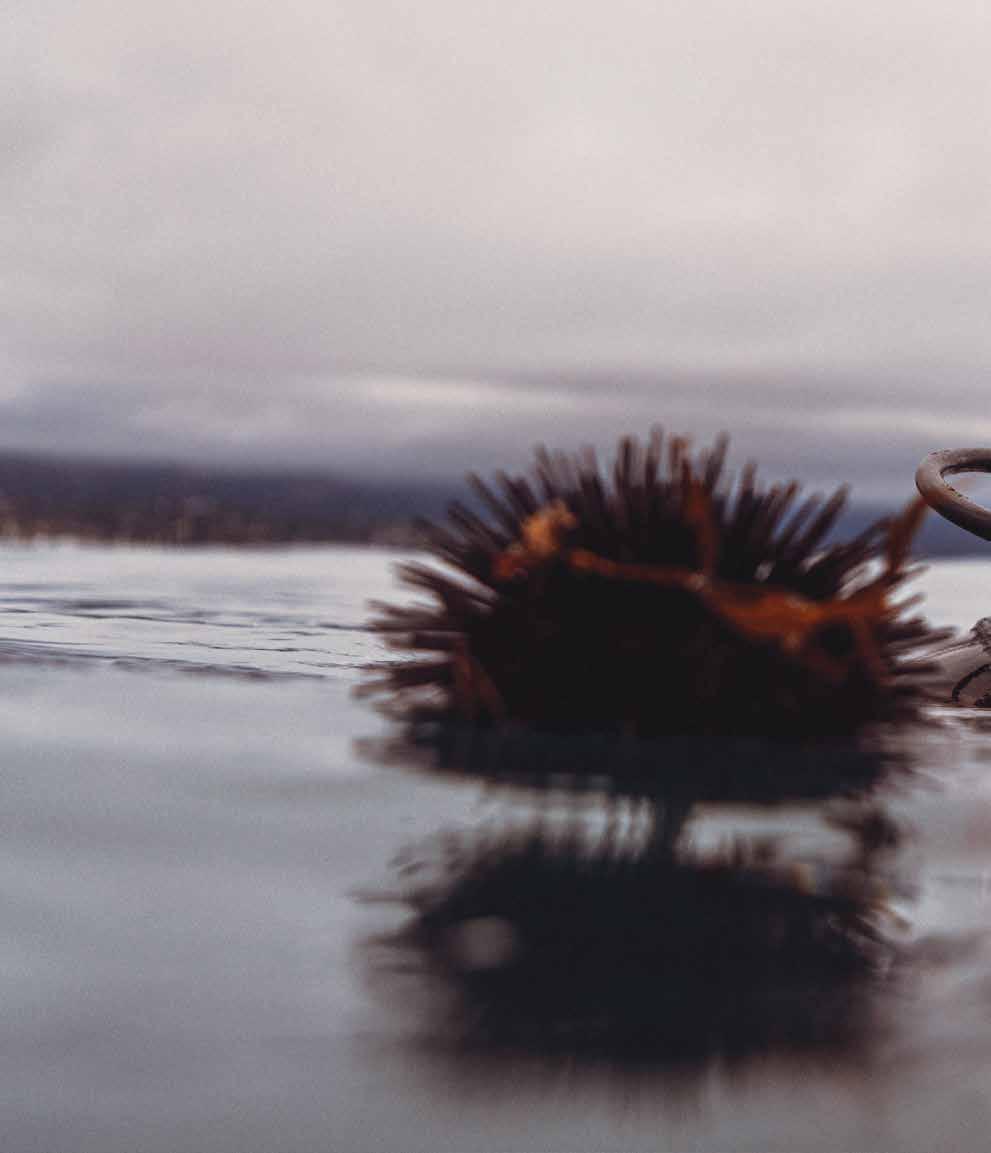
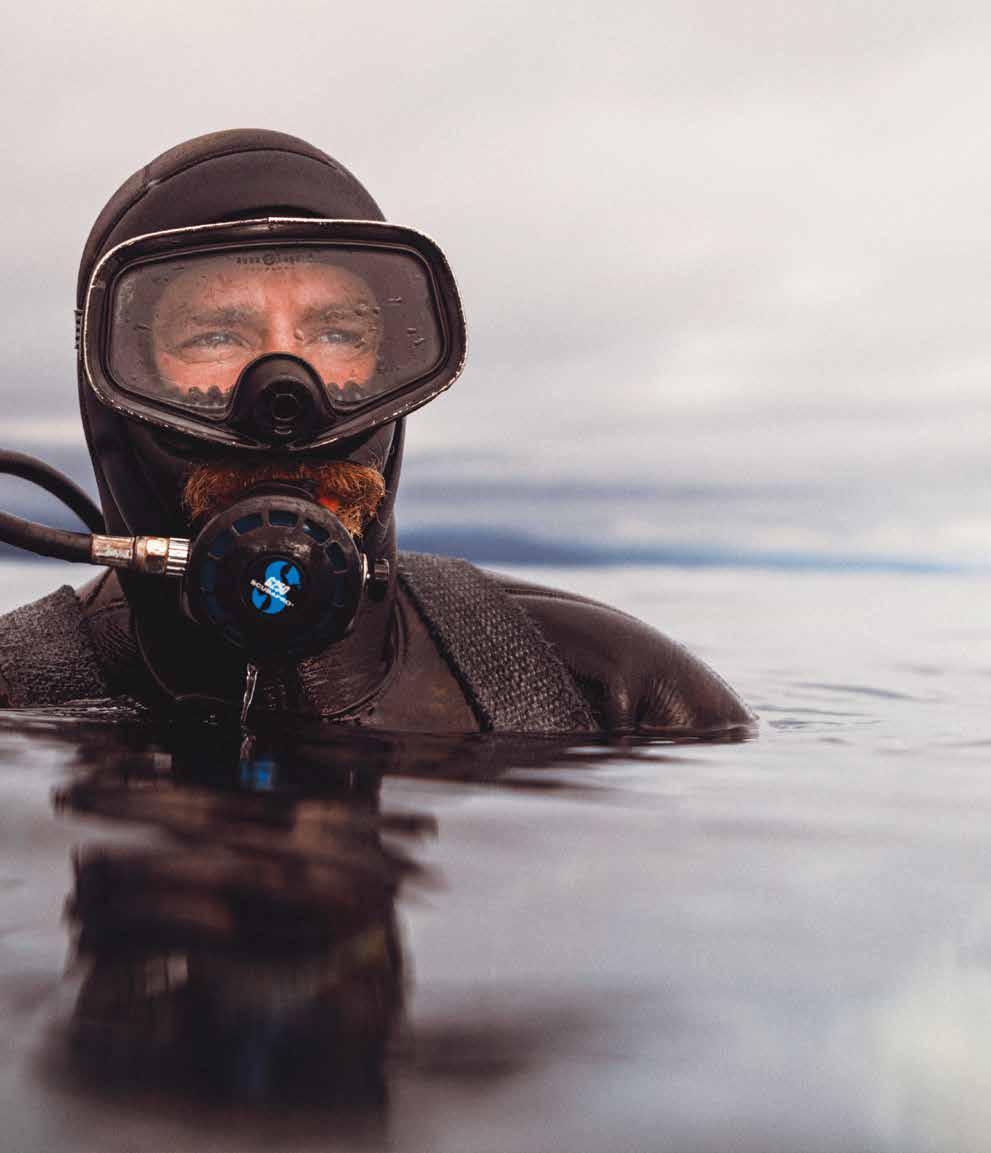
(sister restaurant to the MICHELINstarred Bell’s in Los Alamos), just a few short blocks away from The Inn at Mattei’s Tavern, Auberge Resorts Collection, an iconic Santa Ynez Valley property reborn last year. “You walk right through the front door,” he tells his urchin dealer, Stephanie Mutz, waders and all. “I want people smelling that blast of fresh seawater.”
Heads swivel in the white-and-emerald dining room, jaws agape and full of marinated boquerones and crab potpie, to watch the bin of spiny echinoderms approach the kitchen. “It’s a spectacle,” says Matthews, who typically orders 50 urchins a week and double that in the summer, when he sets the uni over lush creamed corn with shrimp and basil. Mostly, though, he prefers serving them like oysters, simply shucked and raw over ice. Presented this way, “They are at their purest and truest form, and I think that there’s something so utterly romantic about that as a chef. It’s a beautiful glimpse of what the ocean has to offer.”
“Sea urchin is so special from this area— Santa Barbara,” says Mutz, picking through a basket of a recent catch while her boat is parked in its slip in the city’s marina.
“They are at their purest and truest form, and I think that there’s something so utterly romantic about that as a chef.”
—CHEF BRAD MATTHEWS, BAR LE CÔTE
“The flavor is so complex. It evolves in your mouth. In one bite, you get sweet, you get salty, you get umami, then you get sweet again. It’s like an adventure. It doesn’t taste like anything else. When people ask me what it tastes like I say sweet ocean with an avocado or custard texture—that’s as close as I can come.”
“The other reason,” she continues, explaining Santa Barbara uni’s exalted status, “it’s a delicacy.”
That fact has revealed itself vividly over the last several years.
Matthews and his customers by the Santa Barbara Channel are lucky enough to feast on red urchins with “lobes as large as a wristwatch.” This is decidedly not the case in other parts north on the coast, where harvesters have come to depend on purple urchins that can be as small as quarters, according to second-generation diver Grant Downie, who dives near Fort Bragg north of San Francisco.
Unlike in the Santa Barbara Channel, where the native macro kelp that urchins feed on can tolerate warm water, the
96
Chef Brad Matthews of Bar Le Côte.

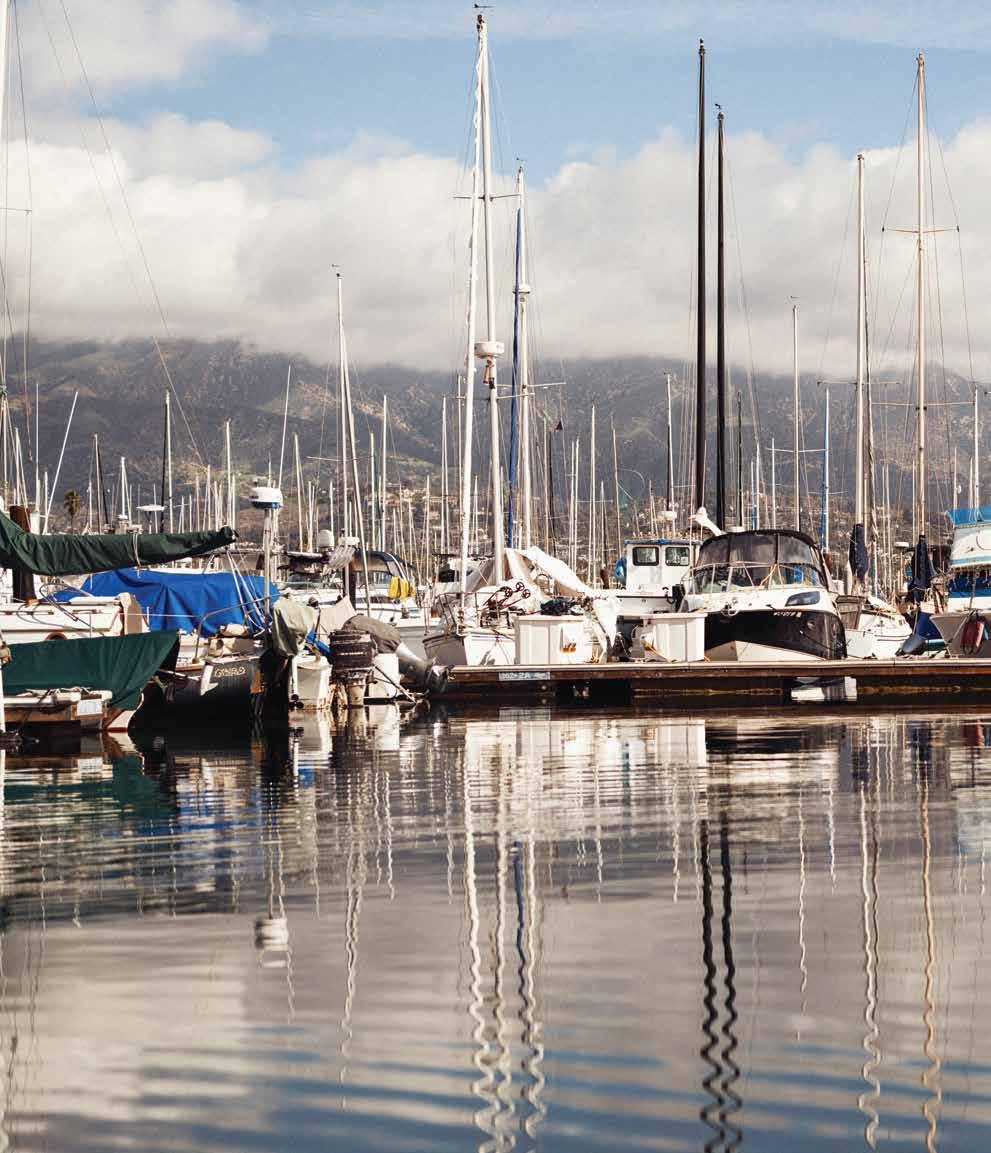
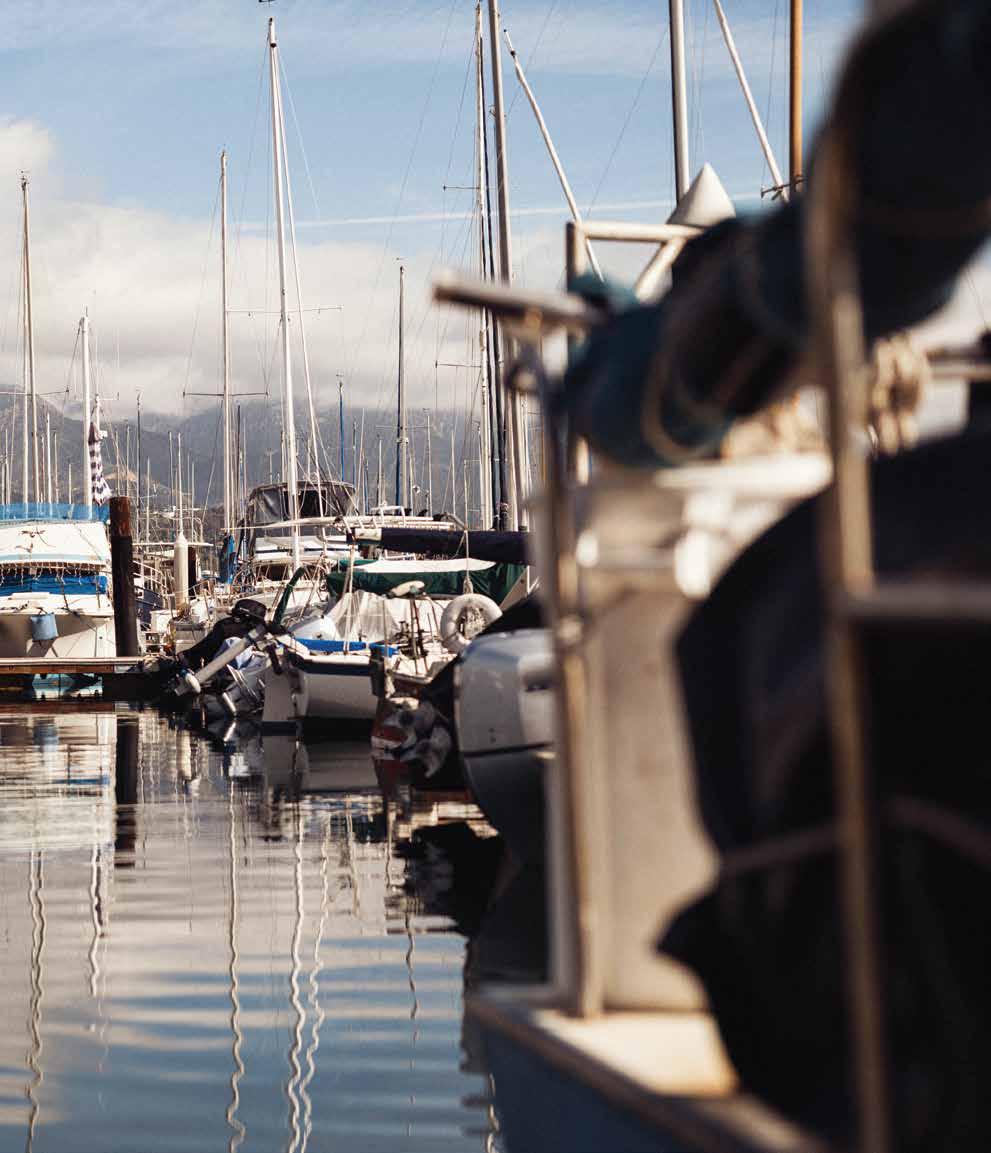
 Above: Rhoda Magbitang, executive chef of The Inn at Mattei’s Tavern, cracks open urchin for guests taking part in the hotel’s Art of Uni experience. Right: Chef Rhoda Magbitang’s Art of Uni experience at The Inn at Mattei’s Tavern, which features the delicacy prepared in three distinct and delicious ways, including uni toast with bacon jam and a translucent veil of torched lardo.
Above: Rhoda Magbitang, executive chef of The Inn at Mattei’s Tavern, cracks open urchin for guests taking part in the hotel’s Art of Uni experience. Right: Chef Rhoda Magbitang’s Art of Uni experience at The Inn at Mattei’s Tavern, which features the delicacy prepared in three distinct and delicious ways, including uni toast with bacon jam and a translucent veil of torched lardo.

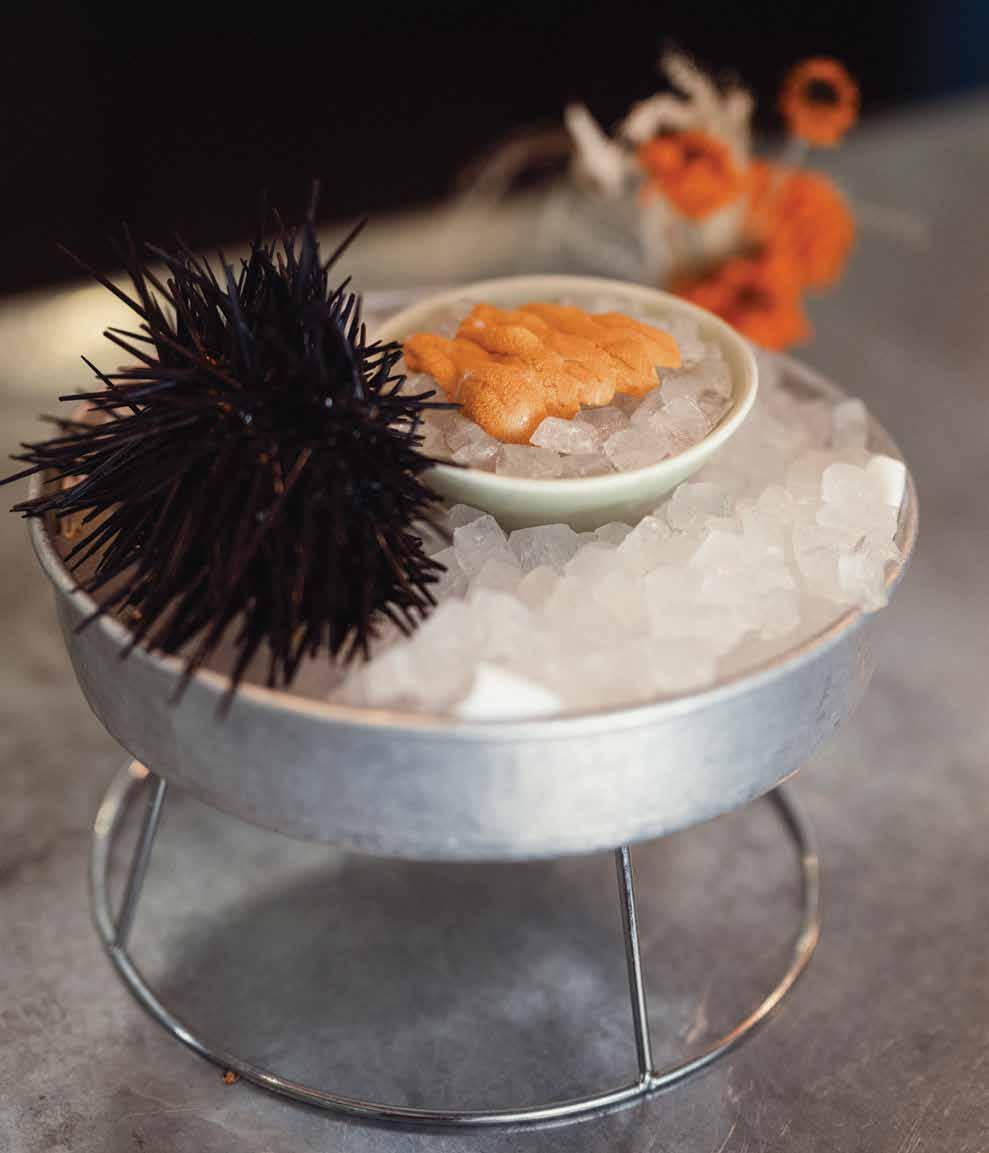
The uni at Bar Le Côte, served unadultarated over ice, “a beautiful glimpse of what the ocean has to offer.”
sensitive bull kelp in other areas have been decimated since The Blob. In a cascading disaster, the sunflower sea star population was also at risk. The sea star is the main predator of the purple urchin, and in their absence, the latter proliferated.
The purps, as they’re sometimes called, can survive on so little food that they also go by the nickname zombie urchins. The cycle has been a vicious one, with the purps devouring remaining kelp that used to feed their red counterparts, ensuring their dominance. The purple urchins are edible, but nowhere near comparable to the sweet and creamy flavor of their crimson cousins—so-called “sea butter,” as Anthony Bourdain once famously described them.
Red or purple, education is key; even though urchins have been a part of this landscape for millennia longer than humans, some diners still see them as aquatic enigmas, and may, upon first glance, look at them with a mix of intimidation and curiosity. “What am I going to do with that?” is a question often asked.
Rhoda Magbitang, executive chef at the Inn at Mattei’s Tavern, gets that one a lot, which is why the chef spearheaded the immersive
Art of Uni experience at the storied hotel. “It’s not like teaching people how to peel a shrimp, so it felt kind of like a crazy idea at the time,” says Magbitang. “You don’t know what people are going [to] be like when they arrive; could they be squeamish? Could they be like, ‘What did I get myself into?’”
Her apprehensions proved unfounded. The guests learn how to break down the urchin and delicately excise their gold. Magbitang encourages them to taste the uni au naturel, then in a pairing with champagne and chardonnay, before demoing three outrageous dishes: fried oysters with uni, smoked Okinawan sweet potato with black garlic and uni, and uni toast with bacon jam and translucent veil of torched lardo. “Utilizing uni in pasta and risotto is wonderful, but I think there’s just so much more [you can create with it],” Magbitang adds.
Obviously, it’s no surprise guests love the food and wine, but Magbitang did not expect them to love the prep work. “I think the most surprising takeaway is how much they enjoy the process of cleaning the urchins,” she says. “People get into it. Some of them ask for seconds.”
103
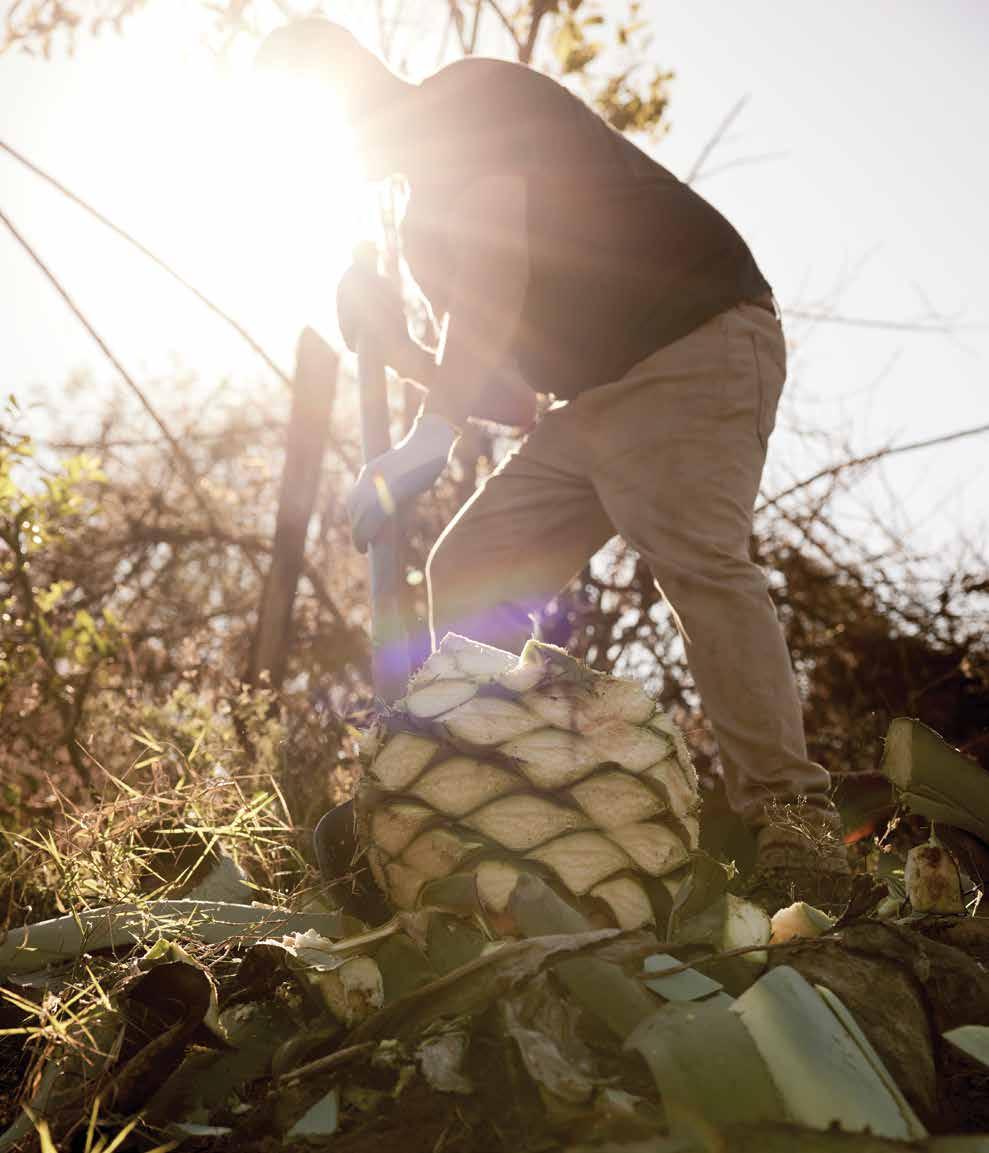
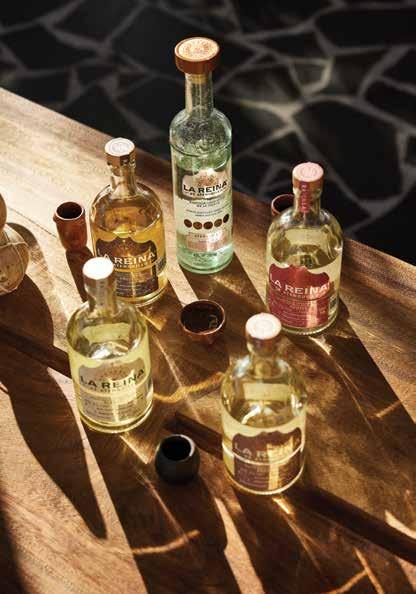
ANCIENT ROOTS, MODERN INTRIGUE
From raicilla to sotol and distinctive gins, a diverse array of delectable liquors will make you say “Move over, mezcal.”
PHOTOS BY MICHAEL PERSICO
TEXT BY DAVID SHORTEL

If mezcal, the Mexican spirit that won over cocktail connoisseurs with its signature smokiness, is cooked like a brisket—with the agaves that compose it smothered in an open-earth pit to seal in the flavor—then raicilla, its upstart cousin, comes about like a hearth-roasted vegetable.
At least that’s the comparison favored by Rio Juan Chenery, the founder of Estancia raicilla, to differentiate the colonial era agave drink he produces from its more widely known analogs.
At his rough-hewn distillery in the mountains that rise over the resort city of Puerto Vallarta, Mexico, he shows me the three domed ovens where the local variety of the agave plant, the mint green maximiliana, is baked for two days, before being mashed, fermented, and distilled into the fragrant, clear raicilla.
Made of adobe mixed from the region’s red soil, the ovens are fed before dawn with oak logs that will impart a slight char. After eight hours, once the flames reach a height where they move in slow motion, workers toss agave hearts in through a hole in the back like an arcade basketball game, and the oven is patched shut. At times, the pressure inside grows so great cracks form on the surface that must be smoothed over with mud.
The result is a fresh and bright spirit with a pungency that tickles the nose as it kicks in the throat. The taste is more
nuanced than tequila—with floral and grassy notes unique to the maximiliana— and more subtle than mezcal.
“You can smell it from far away,” says Chenery, an Australian whose family in Puerto Vallarta introduced him to the drink. “Yesterday, we were drinking in San Pancho, and my wife brought in a small glass of raicilla and,” smelling it in the air, “I said, ‘Ah, where’s the raicilla?’”
It’s a question you may start hearing more frequently at the buzzy cocktail bars and hip supper clubs. Since Chenery became one of the first to sell raicilla outside of its native Jalisco ten years ago, more than a dozen brands have followed suit.
In the years since mezcal first accustomed drinkers’ palates to more sophisticated Mexican flavors, a new generation of distillers and brewers moved into the mix, bottling drinks with indigenous ties and exotic ingredients. Regional moonshines, fruity ferments, and local takes on age-old European liquors now line the shelves at innovative bars around the world, appealing to a growing niche that’s looking for more story and heft when they sit down at the counter.
“They’re looking for complexity, they’re looking for weight on the palate, they’re looking for culture,” says Kaj Hakkinen, a founder of the Back Bar Project, an alcohol importer that works with Estancia.
107
Left: Rio Juan Chenery and his wife, founders of Estancia raicilla.

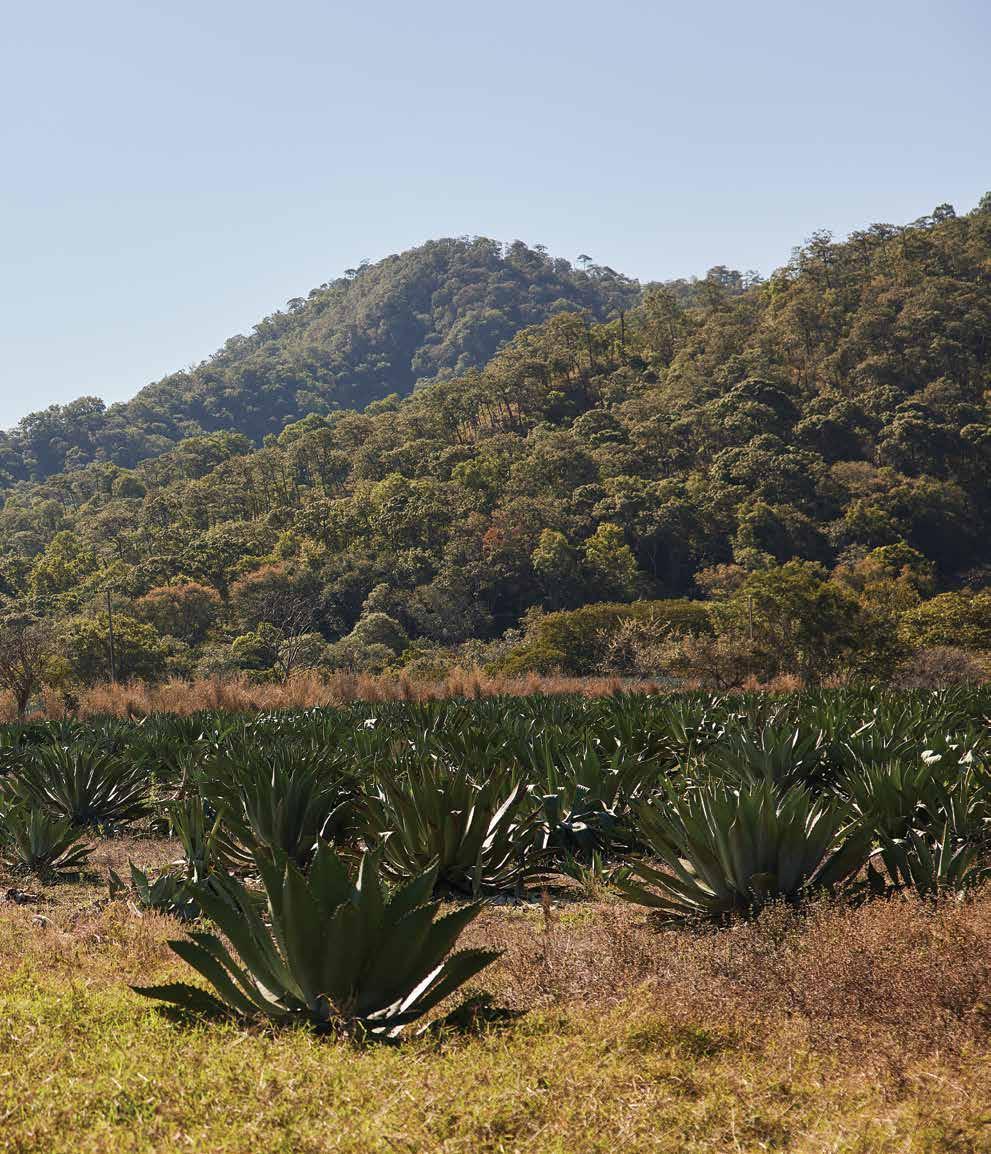
 Agave hearts roast in an oven.
Agave hearts roast in an oven.
 The extreme heat of the oven can cause the seal to crack. If it does, it is patched over with mud.
The extreme heat of the oven can cause the seal to crack. If it does, it is patched over with mud.
In its earliest days, raicilla—which under Mexican law can only be made in the state of Jalisco and one part of its neighbor, Nayarit—was the homebrew of the area’s gold and silver miners, made out of the maximiliana to skirt protectionist Spanish colonial alcohol rules. The ovens of that time were built straight into the side of the steep-rising Sierra Madre Occidental mountain range.
While the spirit of the backwoods remains, raicilla production has gone mainstream: A decade ago, about 80,000 liters of the drink was distilled each year. Now, according to Álvaro Fernández Labastida, head of the main raicilla industry association, producers bottle more than half a million liters annually. Some years, demand for raicilla is so great that by the end of rainy season— when daily downpours mean the especially absorbent maximiliana is too waterlogged to harvest—real raicilla is scarce.
“It’s just a small amount that’s produced. Tequila produces 500 million liters a year. But for the industry, it’s a very big growth,” Fernández explains. “What’s made is sold. We’ve got nothing in storage.”
Much of the production falls along the so-called raicilla route, a stretch of switchbacking highway that wends through the Sierra Madres, connecting spare cobblestoned villages, like Atenguillo, where Ana López, the founder of La Reina raicilla, grew up.
As she serves a glass of her brand’s smooth blanco expression, she tells me how she used to bring a bottle of raicilla with her to parties during her college years in Guadalajara, Mexico’s second largest city, even though no one had heard of the hinterland drink. “When you drink it, you get more talkative, you get more creative, you become more connected,” López says.
She can see the transformation in real time from a breezy tasting room at Susurros del Corazón, Auberge Resorts Collection’s property in Punta Mita, where she offers an “Origins of Raicilla” experience, a pairing of five of La Reina’s varieties with sweet guava candies and a local cheese. Over the hour-long tasting journey, as generous pours collect on the table—from the rare ancestral line distilled in the hollowedout trunk of an ash tree to the 110-proof Puntas, a favorite—“people become like family,” says Juan Pablo Mercado, López’s husband and a co-founder of La Reina.
If there’s another Mexican liquor set to break out for savvy drinkers, many insiders have their money on sotol, a brassy spirit from the country’s desert north that’s accumulated centuries of legends.
The origins of the drink, made from the spindly dasylirion succulent, date back to the pre-Hispanic days: archaeologists excavating the Paquimé ruins in the Mexican state of Chihuahua have found evidence that sotol was cooked there.
112
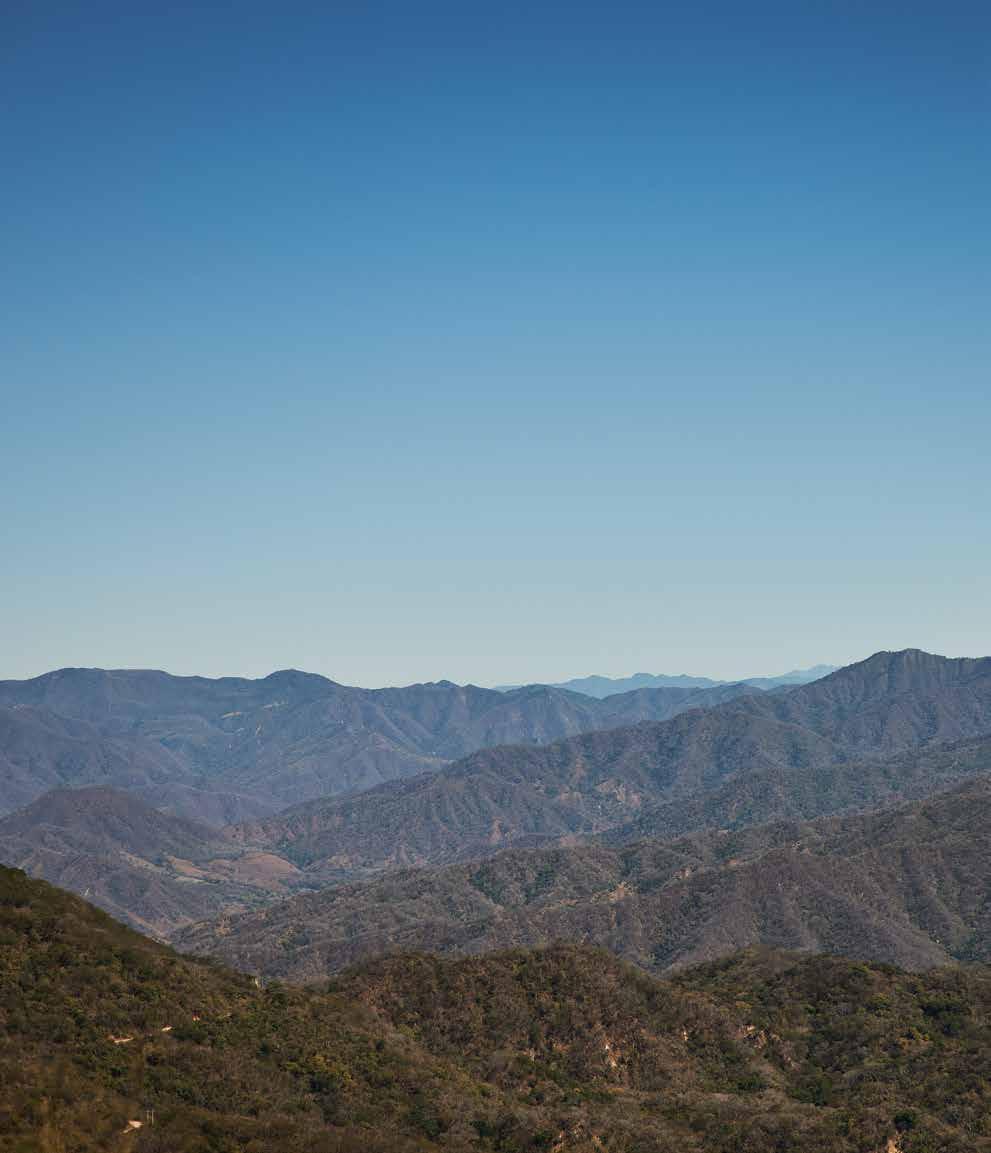

 Above: La Reina raicilla in the glass, swirled like wine to release its aroma at Susurros del Corazón’s Origins of Raicilla. Right: Ana Lopez and Juan Pablo Mercado, the husband and wife founders of La Reina.
Above: La Reina raicilla in the glass, swirled like wine to release its aroma at Susurros del Corazón’s Origins of Raicilla. Right: Ana Lopez and Juan Pablo Mercado, the husband and wife founders of La Reina.
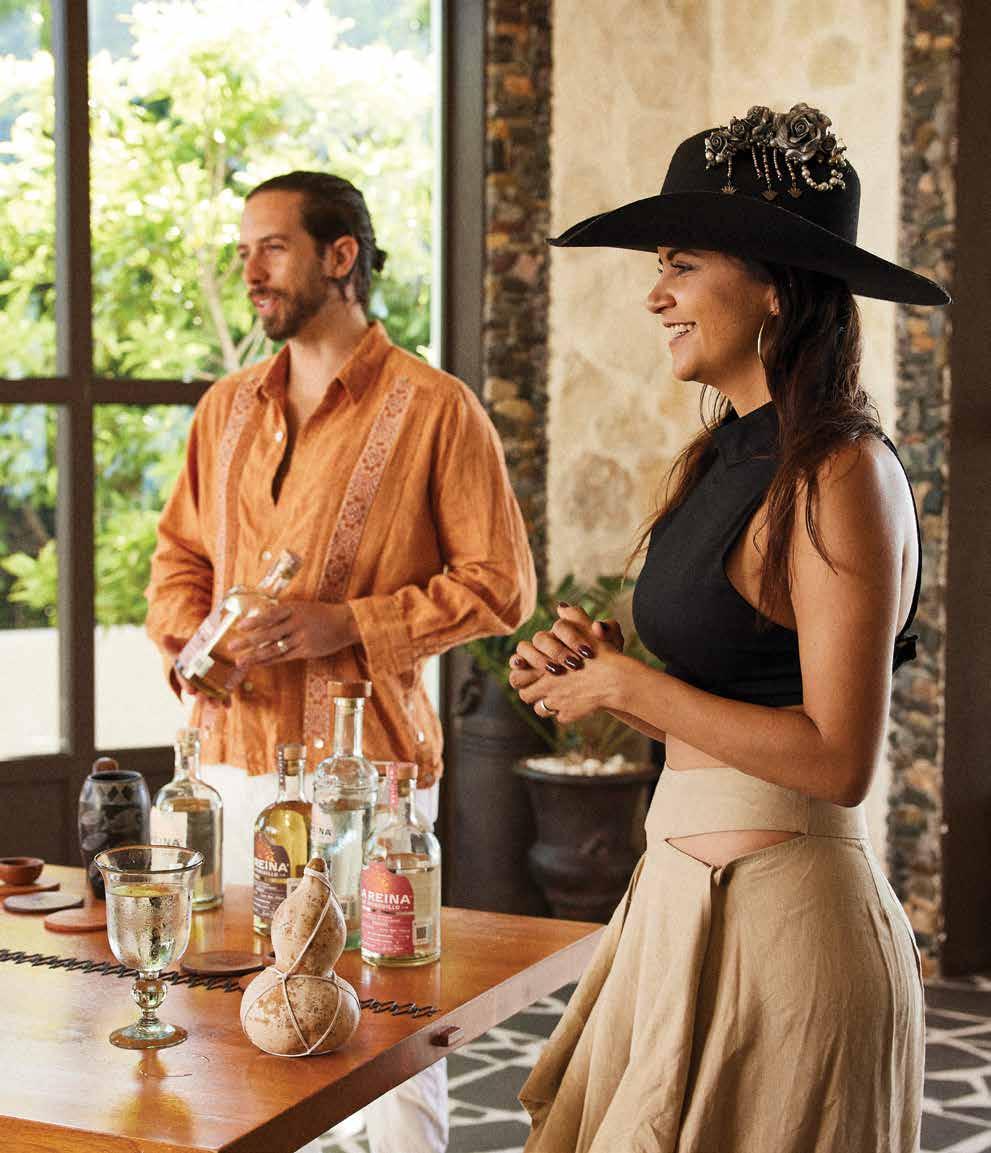

But in more recent times, sotoleros were treated like outlaws. Mexican prohibition laws, mirroring the temperance movement on the other side of the border, shunted the liquor’s production underground, nearly killing off the ancient tradition. Distillers recall relatives subjected to violent roundups. Local lore proposes that Al Capone used to smuggle it north.
It’s all part of the allure that has driven sotol’s commercial revival since the first legal licenses for its production were issued in the 1990s.
Go to a rooftop party in Mexico City or swim-up bar at Susurros today, and a bottle of Sotomayor sotol, one of the first brands to go to market widely, is a staple on bar carts. Isidoro Guindi, the line’s founder, says he likes it mixed in a cocktail with lemongrass and green apple.
“Sotol’s flavor is smoky, minerally and a bit sweet,” Guindi says. “The acidity helps balance it very well.”
But if a smoky finish remains the country’s cocktail calling card, distillers in the capital are also beginning to experiment with traditional aperitifs and botanicals, adding a dose of Mexico City cool to urbane European drinks.
There’s Primo, a stepped-up Aperol made from local oranges and grapefruits, and Pastis de México, a spin on the south-of-France anise essential. And then there’s Condesa Gin—named for the leafy zone of Mexico City brimming with fashionable dining and art—which was started in 2021 to prove that
the city could compete on the world stage with the austere European strongholds of gin.
“They sort of had this claim to the origins and cultural augustness of gin,” says Ben Brooksby, one of the brand’s founders. “The idea was to use Condesa Gin to plant Mexico’s flag in that space and say Mexico City is on par with these global capitals and can make a world-class gin.”
They’ve done that by infusing their batches with aromatics emblematic of the country, like prickly pear cactus and palo santo, a tree from the Yucatan that shares chemistry with citrus fruits. The recipe also calls for a mystical element: each of the botanicals selected pays homage to the rituals of traditional healers, or curanderos, around Mexico City.
In a limpia, or ceremonial cleansing, curanderos bundle aromatics like lavender, rosemary and sage, dip them in water and pass them over the person they’re treating.
“Beliefs vary, but one central to us is that the person receiving the limpia may have lost his or her spirit, and the botanicals sweep away negative energies, allowing the spirit to return to the body,” Brooksby says.
Take a sip of some Condesa Gin mixed with tonic and you’ll feel why: the cocktail is transcendent, a combination of deep-rooted flavors and inventive practice sure to upend expectations.
Maybe it’s time to update the old adage—one tequila, two tequila, three tequila, no more. There are more exciting spirits now heading north for those who know where to look.
117
At Susurros del Corazón’s raicilla experience, guests sample five varieties of the spirit.
Above
Dining The Clouds
How Colorado became a World-Class destination for food lovers.
Like a lot of people who call the state home, Max Mackissock came to Colorado from a long way off. He grew up mostly in New York, where his introduction to the culinary world was cooking in mom-and-pop Italian restaurants starting at 14 years old. “I fell in love with it, right off the bat,” he says of the kitchen.
It was ski slopes, not frying pans, that lured Mackissock to the Rocky Mountain State in 1998, when he moved to Breckenridge to spend a season snowboarding. After a stint in Italy, he returned to New York in 2001, a few days before the September 11 attacks, which convinced him to go back to Breckenridge and try his hand at food again.
At the time, Mackissock says, what passed for a local “food scene” was very much nascent. Specifically, he sees that era of local dining as having been dominated by an old-school crowd with old-school expectations for the kind of meat and potatoes fare native to Colorado restaurants back then. “The diner wasn’t ready to go outside of the box,” he recalls.
In the two decades since, the food scene in the state has exploded, as many visitors to the state have opened new eyes to the Colorado lifestyle. Then came droves of modern explorers from both coasts, and these more sophisticated palates created a demand for better food. In the early
118 TEXT BY WINSTON ROSS
PHOTOS BY TREVOR TRIANO

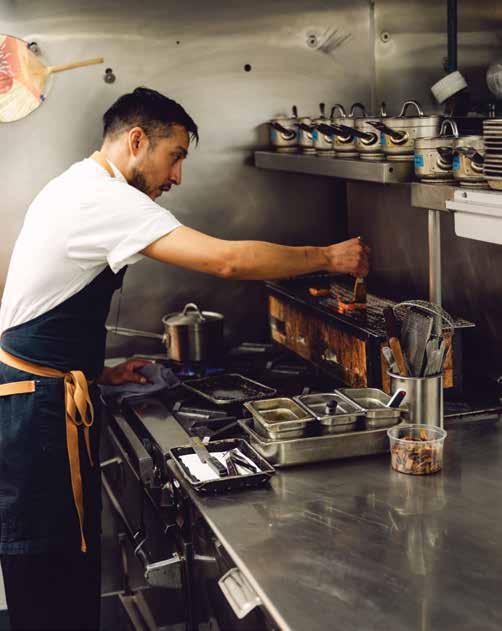 Above: A cook preps for service at Prospect, the signature restaurant at Hotel Jerome, Auberge Resorts Collection. Right: The latest menu at Prospect, led by chef Connor Holdren, showcases a bounty of the Roaring Fork Valley and surrounding region, and includes Montrose beef short ribs, McClure red potatoes, Paonia Valley chicken and morels and Palisades plum.
Above: A cook preps for service at Prospect, the signature restaurant at Hotel Jerome, Auberge Resorts Collection. Right: The latest menu at Prospect, led by chef Connor Holdren, showcases a bounty of the Roaring Fork Valley and surrounding region, and includes Montrose beef short ribs, McClure red potatoes, Paonia Valley chicken and morels and Palisades plum.
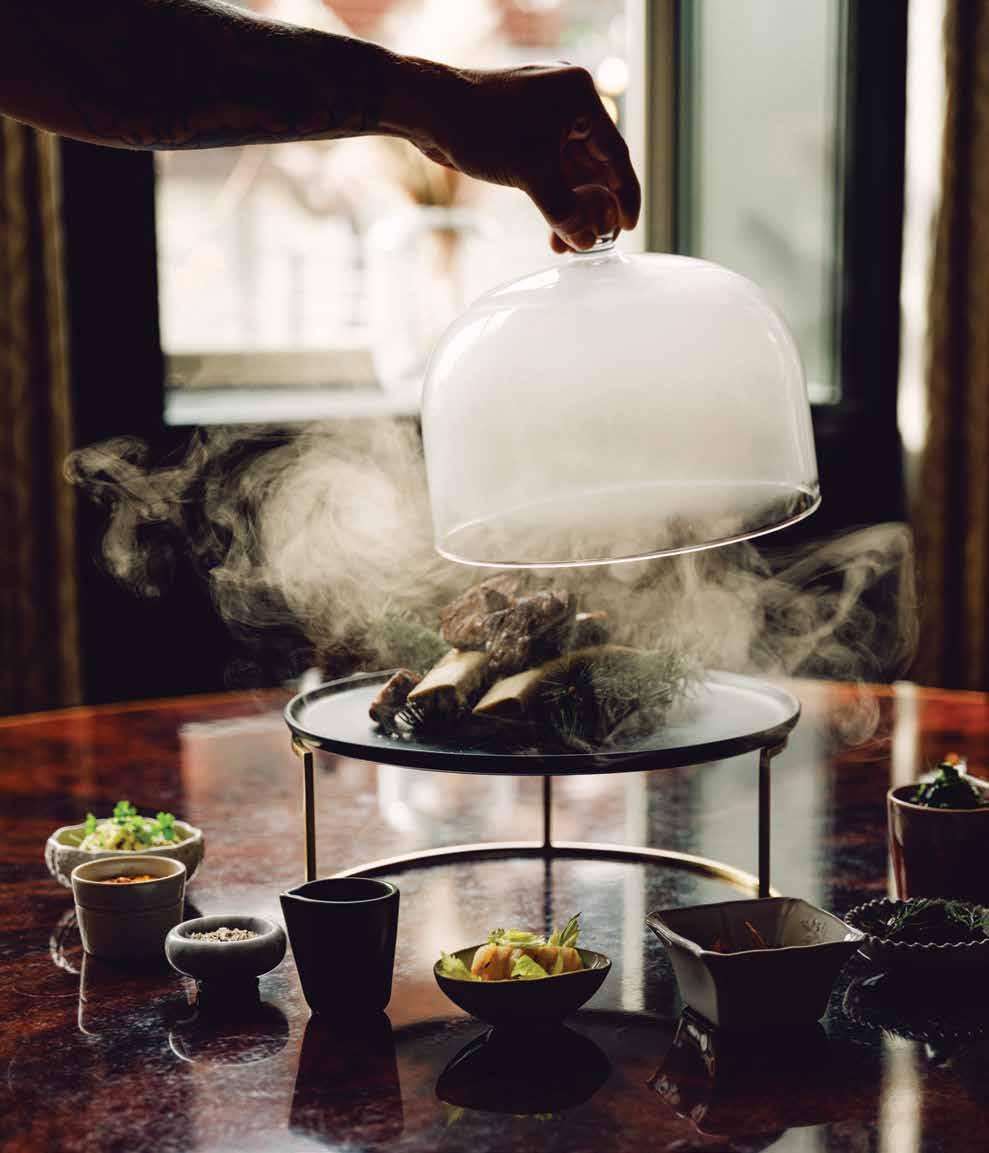

“An epicurean journey into the land that surrounds us, from the mountains to the rivers, across pastures and ranches.” —ON
2000s, Mackissock remembers, “they would tell you not to put fish on the menu, that nobody would eat it,” he says. “Now, we’re getting fresh fish overnighted, and we have these amazing farmers and ranchers—and purveyors who can source products from California in the months when we don’t have a huge abundance of produce.”
Mackissock now runs the Culinary Creative Group and its 14 restaurants across Denver—from the upscale Latin tacos of Mister Oso to the inventive Italian at Bar Dough—thriving in a Colorado food scene that’s all grown up. Even in the resort towns where restaurants might, in the past, have dished out merely serviceable fare to tourists who expected little more, local restaurants have evolved and then some. From Durango to Denver, innovative chefs are opening dynamic new eateries, drawing on their travels and traditions to offer patrons a delectably wide variety of cuisine, from nontraditional Vietnamese to nouveau Mexican. And the world has taken notice: last summer, the MICHELIN Guide added Colorado as its latest
destination, noting the state’s “rich culinary community, many creative restaurant teams, and an exciting mix of flavors.”
Johnny Curiel is one of those chefs who helped take Colorado to the next level. He grew up in Breckenridge, and his father owned traditional Mexican restaurants in Denver and Colorado Springs. The style was a familiar kind of comfort food, he says: “100 menu items, queso on every plate, heavy and fatty,” and Curiel wanted to try something different.
So he traveled to different parts of Mexico and learned more about the country’s rich food culture. After several years abroad, Curiel returned to the U.S. and got a job with Richard Sandoval in New York, who was leading a revolution in Latin cuisine. After four years with Sandoval, Curiel returned to Mexico to learn more, and then went back to his home state and some of Denver’s best restaurants, like Guard & Grace, in different roles in the kitchen. He still felt like the scene had a ways to go, that “the East Coast, L.A. and
123
Chef Connor Holdren of Hotel Jerome’s signature restaurant Prospect, whose hyperlocal menu is true to Colorado and the Roaring Fork Valley.
THE NEW MENU AT HOTEL JEROME’S
PROSPECT

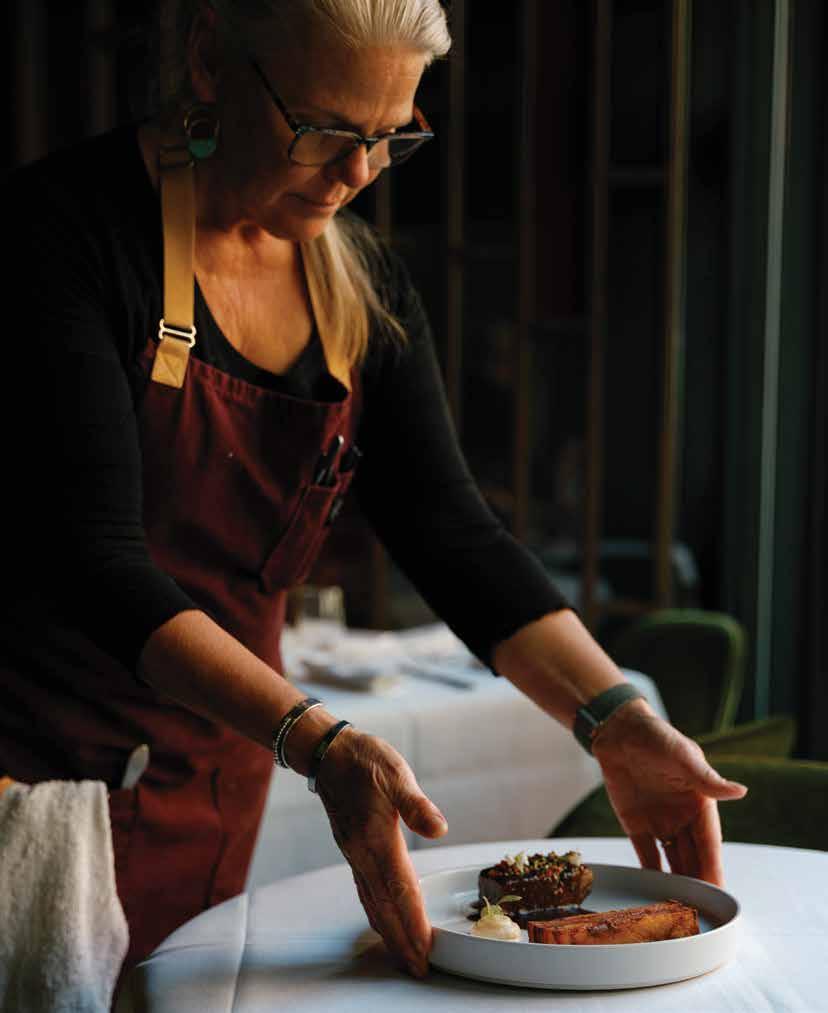
San Francisco always seemed like 10 years ahead of us,” but that changed, especially as chefs began to tap into the bounty of Colorado’s produce and livestock. “We have a lot more to offer than green chile burritos and Rocky Mountain oysters,” he says. Curiel now helms Alma Fonda Fina, in the city’s Lower Highlands neighborhood.
Great food, wine from 200 producers across the state, a booming craft beer scene and creative cocktails can be found far beyond the capital city’s borders, too.
Chef Barclay Dodge grew up in Aspen and has been in the restaurant industry since he was 18 years old. After culinary school in San Francisco, Dodge traveled for five years, working as an executive chef for Auberge Resorts Collection and at one of the world’s most renowned restaurants, Spain’s El Bulli, before returning to Aspen in 1995 with an idea that was ahead of its time: an eatery where he created an array of dishes employing many of the molecular gastronomy tricks he’d learned abroad. While the restaurant got plenty of good press, it was hard to keep the place full, as people saw it only as an option for special occasions,
he recalls. So Dodge switched to Bosq, derived from the Spanish bosque, for “forest,” an homage to foraging for products in the woods. “We’re trying to capture the feel of being in this particular part of Colorado, focusing on hyper-seasonality,” Dodge says.
Bosq finds itself in increasingly illustrious company. It’s one of what are now four Aspen restaurants the MICHELIN guide highlights—one being Prospect, Hotel Jerome, Auberge Resorts Collection’s signature restaurant that takes diners on “an epicurean journey into the land that surrounds us, from the mountains to the rivers, across pastures and ranches and through the agriculturally rich flatlands.”
Connor Holdren is the executive chef at Prospect, arriving at the start of 2022 from Auberge du Soleil, in Napa Valley. The growing season is much longer in California, he explains, but working there taught him the importance of employing as much local produce and protein as possible. In Colorado, “we don’t have as much abundance of everything, and we have some very local and specific things we can use, so we really try to stay hyperlocal
“We’re trying to capture the feel of being part of this particular part of Colorado, focusing on hyper-seasonality,” says Dodge, whose food (right), if often foraged close by Bosq.
126
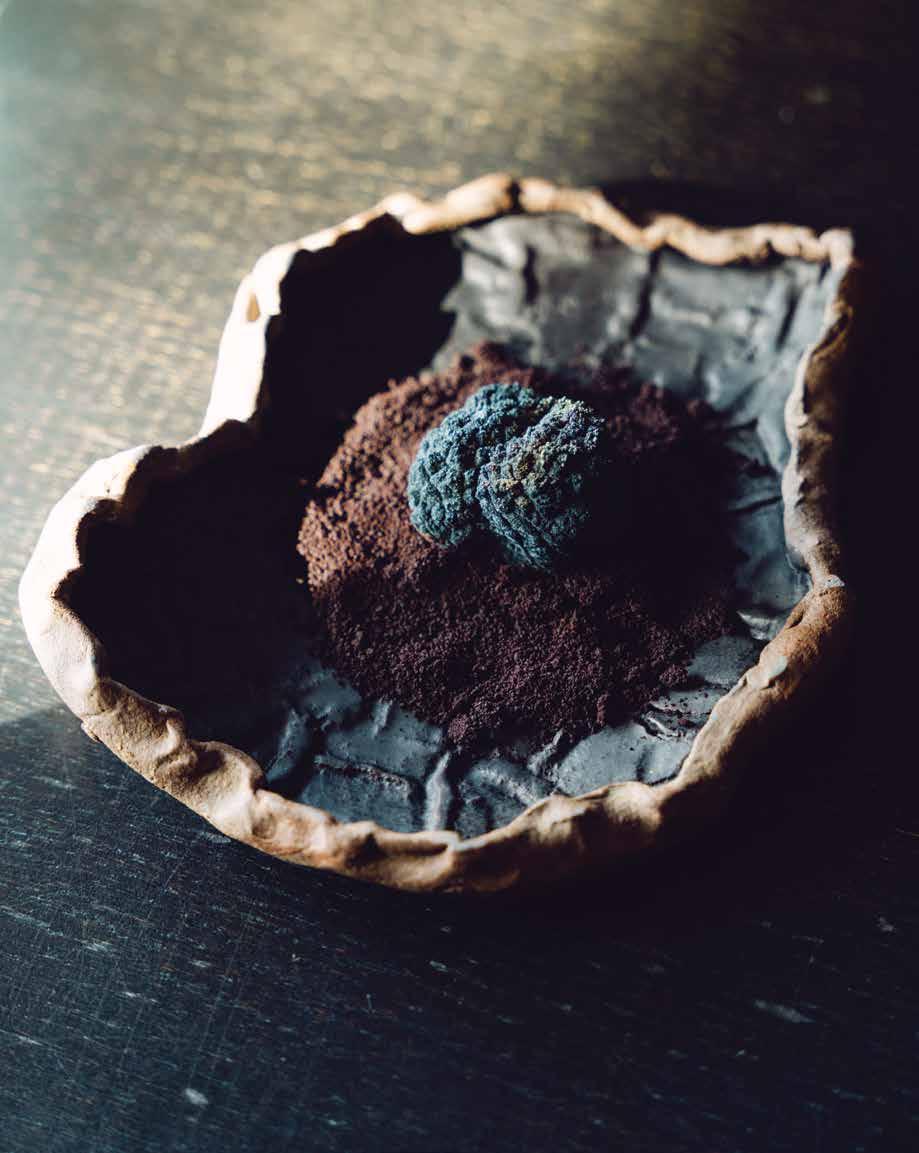
 Above: The food at Aspen’s Bosq highlights a “sense of place,” says its executive chef Barclay Dodge, and features items like a mushroom quinoa cracker, grilled celeriac, duck liver mousse and lobster grilled over locally foraged juniper branches. Right: Chef Barclay Dodge.
Above: The food at Aspen’s Bosq highlights a “sense of place,” says its executive chef Barclay Dodge, and features items like a mushroom quinoa cracker, grilled celeriac, duck liver mousse and lobster grilled over locally foraged juniper branches. Right: Chef Barclay Dodge.


and true to Colorado, but also to the Roaring Fork Valley,” Holdren says.
In a dish called “The Rivers,” for example, there’s local rainbow trout, a puree of watercress found in local rivers and a bonebroth dashi foam made from the trout’s bones. “Every dish is named after some aspect of the valley,” Holdren explains. “The ‘Walk through the Forest’ is like when you’re lost in the trees snowboarding or skiing, so there’s a wildberry spruce-infused gummy bear nestled in pine branches, a play on the bears in town that come out every year before hibernation.”
The state’s offerings are bursting with similar creative outputs, and they defy easy categorization. Ni Nguyen started working at his mother’s pho restaurant in California in 2010, first as a cashier and then boiling noodles. He fell in love with it, “with the motion, the intentionality of food,” he says, and begged his parents to support his dropping out to go to culinary school, which was “a super hard thing to do as a first-generation Vietnamese American. They were hesitant.” In school, Nguyen met his wife, Anna, who was from Colorado, and after working at various restaurants in California, the pair moved to Denver, in 2014. “It just wasn’t very diverse,” Nguyen says of the food scene
in the city then. “You saw a lot of the same flavors, not a lot of fish sauce.”
The couple left for LA, working for several top chefs, returning to Denver in 2020 to open Sap Sua, where they combined Nyugen’s heritage with their new wealth of experience. It is regarded as one of the city’s most inventive restaurants.
Colorado was due to evolve, according to chef Jennifer Jasinski, who moved to Denver from California after falling in love with the state’s natural beauty on a tour of the country with her mentor, the famed chef Wolfgang Puck. She started as executive chef at the local Italian restaurant Panzano and ignored the advice not to put fish on the menu, replacing the veal in an osso buco dish with monkfish, the meat in tortellini with an artichoke mousse. She then opened a Mediterranean restaurant, Rioja, with Panzano’s business manager, winning a James Beard award in 2013.
“There’s just been a great synergy,” Jasinski explains, a confluence of circumstances that make Colorado a destination. “Great shows, great music, great theater, conventions, all these things. And now a clientele that wants to have good food.”
Luckily, in Colorado, the latter is easier to find than ever.
131
Ni Nguyen, left, moved to Colorado in 2014. “It just wasn’t very diverse,” he says. Now, his Vietnamese restaurant Sap Sua is widely regarded as one of Denver’s most inventive restaurants.
 HUDSON VALLEY / KIAWAH RIVER / UTAH / NAPA
Photo by William Kaner
HUDSON VALLEY / KIAWAH RIVER / UTAH / NAPA
Photo by William Kaner
Bespoke
 BY WILLIAM KANER
BY WILLIAM KANER
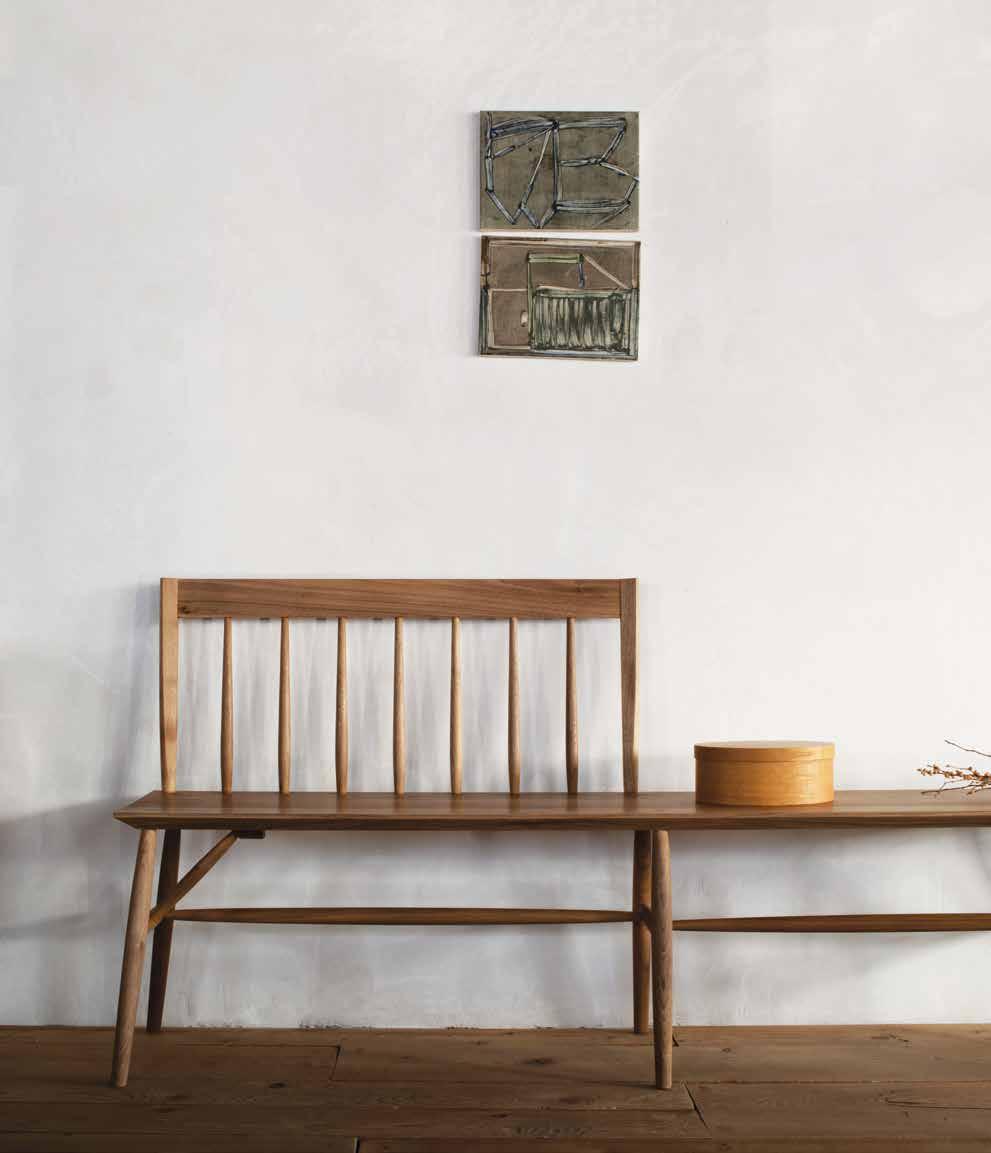
CRAFTING
LUXURY
From custom dining tables to unique textiles, artisans are building lavish furniture in the Hudson Valley.
TEXT BY JULIET IZON
PHOTOS
At this point, it’s almost a rite of passage
for New York City residents to trek upstate to the Hudson Valley with antique furniture in mind. With an abundance of shops and artisan fairs, the increasingly buzzy towns and villages here have long amounted to a preeminent destination in which to hunt down distinctive furniture, from dining tables and desk chairs to textiles and objects. But lately, design-minded connoisseurs aren’t traveling upstate only to hunt for one-of-a-kind collector vintage pieces, but to take advantage of the boom in custom, artisanal furniture makers mastering their craft on location. And Brad Ford has been in the thick of it.
As founder of FIELD + SUPPLY, interior designer Ford oversees a bonanza of opportunities to scope out and scoop up custom furniture in his biannual fairs. Billing itself as a modern interpretation of an design bazaar, the multiday event held at Hutton Brickyards in Kingston is a veritable who’s who of furniture makers throughout the Hudson Valley. And this year, the lively market is celebrating its tenth anniversary, making it an especially exciting season to visit.
“The first time we did it, I organized it in probably three months, with close to 24 vendors,” Ford says. “Now, we probably have
close to 300 and anywhere from eight to ten thousand visitors attending. I’d like to think it’s something people really look forward to at this point, because we have it at the same time every year. And I love that there’s an appreciation of all the different artisans who live in the community and are celebrated.”
With 30 to 40 percent of those vendors in the furniture space, it’s almost assured you’ll find at least one maker who aligns with your own aesthetic. The market showcases everything from the zero-waste pieces from FN Furniture in Kingston to the sleek, custom-order tables and cabinets from Germantown’s Michael Robbins. The fair, of course, is also home to many other types of makers: Some of Ford’s favorite pieces for this upcoming Spring session include KHEM Studios’ walnut cutting boards, Horton Daniel Furnishings’ hand-carved mirrors, and Cambium Lost Arts’ handwoven baskets.
If the fair serves as a sort of hub for locally made furniture, it’s understandable that it’s also raised the profile of many makers who have participated. “So many of them may have started off building as a hobby, but have now become full-fledged businesses. It may have been a one-man shop that now employs several people,” Ford says.
135
A custom-crafted bench from Jonah Meyer’s Sawkille Co.
Sam Moyer, Brian Persico and Jonah Meyer are just a few of the artists who have participated in FIELD + SUPPLY with great success. And these makers and their contemporaries have formed a bubbling community of creatives with a wide array of styles who tend to share a distinct regional ethos.
Like many creative movements, this local alchemy of makers doesn’t have an exact formula, but is better understood instead as the confluence of factors, starting with simple geography.
As more and more artists left the five boroughs for a myriad of reasons, the Hudson Valley became ever more appealing as an alternative. Nearly all of the region’s cities and towns—Hudson, Kingston, Gardiner and Rhinebeck to name a few— offer a slower pace of living, easy access to New York City, and an aura that champions
Brian Persico (right) studied industrial design at Pratt, and began woodworking after discovering a career in the former would lead to a life of making “disposable things out of plastic.” His onetime furniture making hobby turned into a new career with the opening of Brian Persico Studio, in Windham, NY.

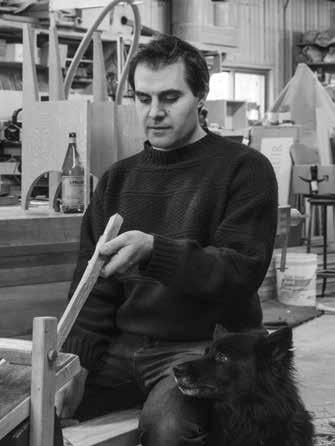
136

creativity, whether it’s in food or furniture. It’s easy to understand just how important the region’s energy and pace is to this budding movement of makers. There is more room to focus on one’s craft because there’s less noise, both literally and figuratively. And finally, it’s difficult to write any story about the Hudson Valley without mentioning its rightfully famed natural beauty. Vistas here can range from views of the undulating Catskills to rolling verdant pastures, and finding creative inspiration can be as easy as looking up.
Such is the case for Moyer, who moved to Salt Point in 2011, after starting his furniture business in Los Angeles. In true Upstate fashion, just prior to our interview he was chopping firewood in his backyard, while also admiring the topography of the forest that surrounds his home. “There’s a lot that’s happened on this terrain,” he says. “Being surrounded by that legacy feels really holistic, really fulfilling.” Moyer also draws inspiration from woodworking legend George Nakashima and the simple designs of Shaker furniture for his custom pieces, which range from dining and coffee tables to 20-drawer cabinets.
But perhaps what draws clients to Moyer most—aside from glowing write-ups in the
“It’s not the most efficient way to work, but it’s a really interesting way to work.”
SAM MOYER
likes of the New York Times, Architectural Digest and Interior Design—is his passion for creating a piece of furniture that both solves a problem and functions as a piece of art. “It’s not the most efficient way to work, but it’s a really interesting way to work,” he says. “And sometimes, the results you get when you work that way are surprising and unexpected and pretty delightful.”
Brian Persico, whose company Brian Persico Studio is based just about an hour southeast in Windham, is another area woodworker who has found success in fashioning bespoke furniture. After studying industrial design at Pratt but then realizing he didn’t want to make “disposable things out of plastic for the rest of my life,” Persico slowly morphed his hobby of furniture making into a career. Drawing on regional vernacular designs like post-and-rung chairs, his finished pieces are an eye-catching mix of traditional and modern, like a sofa inspired by ladder-back chairs paired with a printed, handwoven cushion and chic antler pins. Persico is also game to tackle virtually any type of furniture, from dining tables to armoires. “It’s a really wide range, which is good because it keeps me from getting bored,” he laughs.
But no name may be more synonymous with Hudson Valley furniture than Jonah
138
Right: Jonah Meyer and his team at Sawkille Co. in Rhinebeck, NY, make everything from bedframes to cabinets in a wide variety of styles, and may be best know for its cheeky design flourishes.

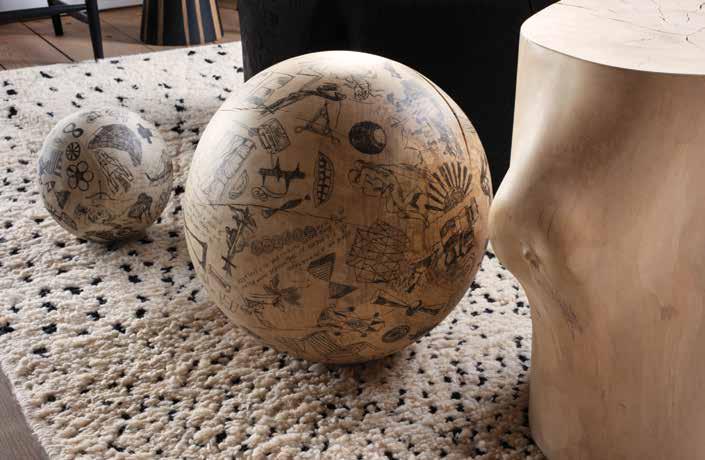 Above and right: Accessories and furniture from Sawkille Co.
Above and right: Accessories and furniture from Sawkille Co.
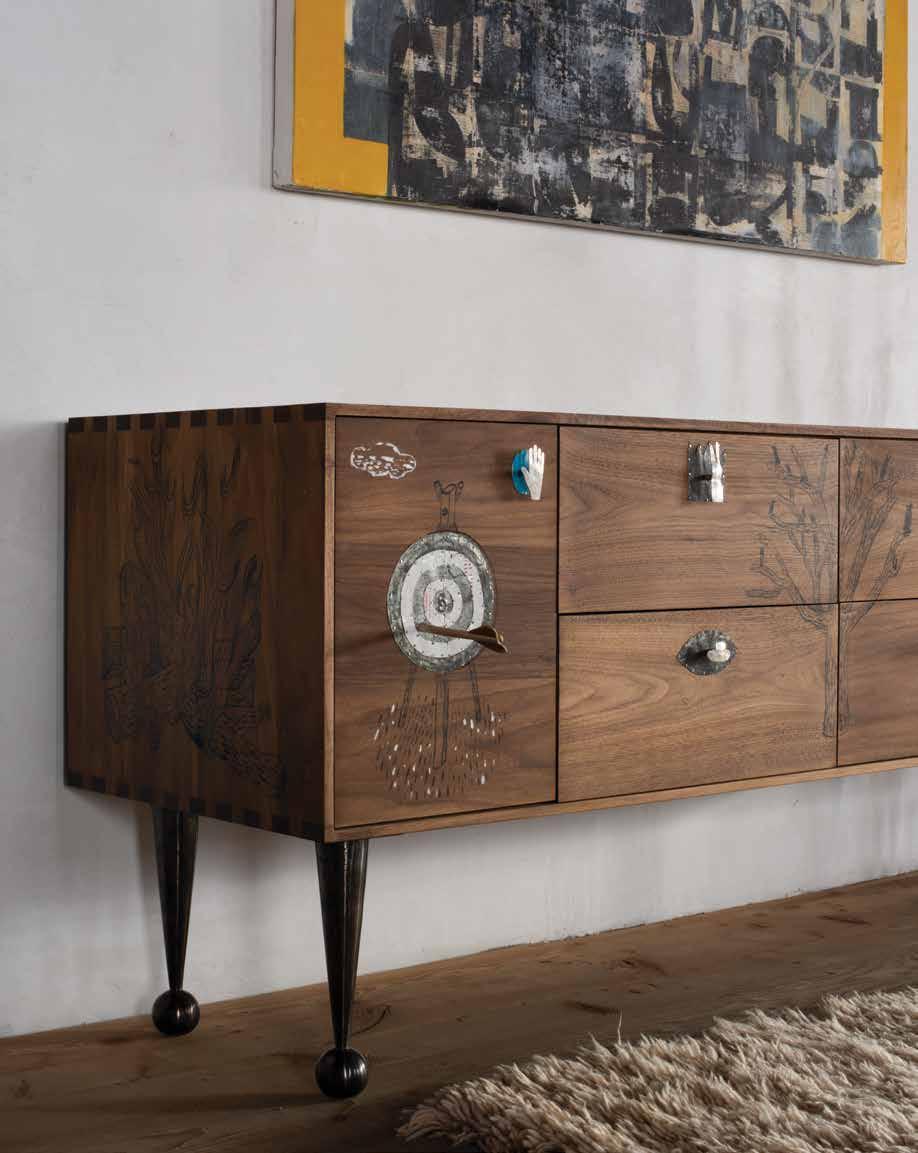
Meyer, the owner and designer of Sawkille Co. While Meyer and his team fashion tables, bed frames, and cabinets in a wide variety of styles, the company may be best known for the cheeky brass patches that can be inlaid on top of the dining tables, in designs like hands and banners. “The American furniture tradition is very small and very particular,” Meyer says. “And it also is born out of necessity. People want simple, well-made pieces.” But be warned: A visit to Sawkille Co.’s chic shop in Rhinebeck may have you debating the merits of tossing out all your dining chairs in favor of Meyer’s handsome models made out of American black walnut. Plenty have, including some celebrity clients Meyer is far too modest to name.
At Wildflower Farms, Auberge Resorts Collection, located in the heart of the Hudson Valley in Ulster County’s Gardiner, you’ll find many of the furniture styles for which the area has become known. Scattered throughout the property are tables and lighting sourced from Ron Sharkey’s shop Maple Lawn 1843 in Stone Ridge; felted stools and art in the fitness and movement studio from local fiber artist Jess Ludwicki of Love Lamb; antique chairs procured from Indiko Antiques in Hudson. Interior design duo Ward + Gray designed
“The American furniture tradition is very small and very particular.”
JONAH MEYER, OWNER AND DESIGNER OF SAWKILLE CO.
Wildflower Farms capturing the essence of the land and its stunning scenery by emphasizing connection, creating custom pieces for both the communal areas and the guest rooms. “On our first visit we photographed the landscape and then had those photos in our studio throughout the whole design process. So the interior design was really influenced by that color palette and the sense of place of Upstate New York,” says founder Staver Gray. The firm ultimately produced over 500 custom pieces for the hotel, including rugs, furniture and fabric, lighting and wall coverings.
And in the same way the hotel has brought together diverse designers to create an environment that is both of its place and inimitably welcoming, so, too, have Hudson Valley’s makers formed a community that has made them stronger together. “It’s this built-in network of people that are very supportive of each other,” says Ford. “They’re all really friendly with one another, but even better, they can lean on each other if they need guidance or advice.”
Field + Supply takes place twice a year, over Memorial Day weekend and in early October, at the Hutton Brickyards in Kingston, New York, a quick 40-minute drive from Wildflower Farms.
The Richness of the Hudson Valley at Wildflower Farms
In guest rooms at Wildflower Farms, you’ll find L’Impatience Ceramics coffee mugs and rugs designed by Tailor-Made Textiles, a small, female-founded company / design resource in upstate New York. In the lobby you’ll find Bobbin Rockers sourced at a local antique shop, and reupholstered in Pierre Frey. Over at Clay, the property’s signature restaurant with a menu that spotlights rustic American fare, much of the coveted plateware comes from Jane Herold Pottery from Connecticut. And inside the on-site boutique, The Shop by Gardenheir, a constantly rotating selection of wares includes everything from gardening tools and home goods to apparel to a tightly edited selection of fine antiques.
142


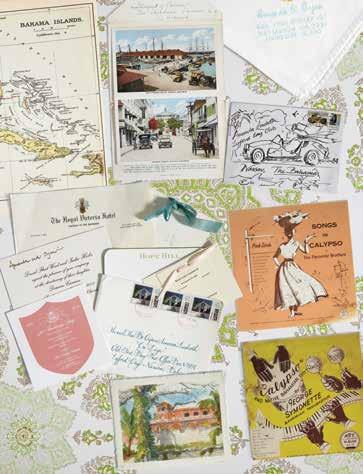
AMANDA LINDROTH’S
Timeless Style
The famed interior designer’s work at The Dunlin in the Charleston Sea Islands exudes the alchemy of design.
TEXT BY JAIME WALTERS PHOTOS BY CHRIS ROGERS AND COURTESY OF AMANDA LINDROTH
“I don’t like anything in a room to look like you might know where it came from.”
—AMANDA LINDROTH
It’s not a fair question, especially after a career as vast as Amanda Lindroth’s. But as a designer—especially working a fair deal in the Bahamas and South Carolina—she’s used to overcoming obstacles (delayed deliveries, customs clearance paperwork, and more).
Still: Is there a word or two she’d use to describe her work, her look?
Anyone keeping tabs on the world of interior design is no doubt familiar with her bio and distinctive aesthetic, and might have a few ideas what her answer might be—charismatic, ornate, sophisticated. Raised just outside Palm Beach in the height of the area’s visual influence, the ‘70s, she remembers weekend trips to shop in town and getting dressed up for lunch at Petite Marmite, soaking in the glamour of the famed Worth Avenue.
Now, from an office on that same street, fresh off a plane from the Caribbean, her brow furrows a tad.
“Timeless,” she says.
“I want interiors that do not feel dated. I think it is important,” she continues. “I don’t like anything in a room to look like you might know where it came from.”
That’s a particularly tricky needle to thread. In interior design, as with any creative endeavor, trends ebb and flow like the tides, and when they fall out of favor, styles risk looking stale. By contrast, central to Lindroth’s timeless ethos is her emphasis on found pieces and classic shapes, eschewing catalog furniture in favor of bespoke creations and vintage treasures imbued with character and history. At the heart of her aesthetic lies an appreciation for the alchemy of design—the art of blending disparate elements to create harmonious spaces that feel both familiar and fresh.
From rattan and wicker furnishings to crisp cotton prints and airy linens, her interiors are a master class in balance and restraint, effortlessly combining traditional motifs with contemporary flair and pops of color.
Lindroth’s designs are consistently crafted with entertaining in mind, reflecting her role as the consummate hostess. She prioritizes the enjoyment and comfort of her guests in every detail. She makes sure, for instance, there are notepads and a jar full of pencils on a night table, alongside a water goblet, in case inspiration or thirst strike. She makes sure “there are live things in the house,” orchids or orchid baskets or flowers picked fresh from the garden. Books and magazines are placed next to seating areas for ease of access.
146
Right: Interior designer Amanda Lindroth in one of her spaces.
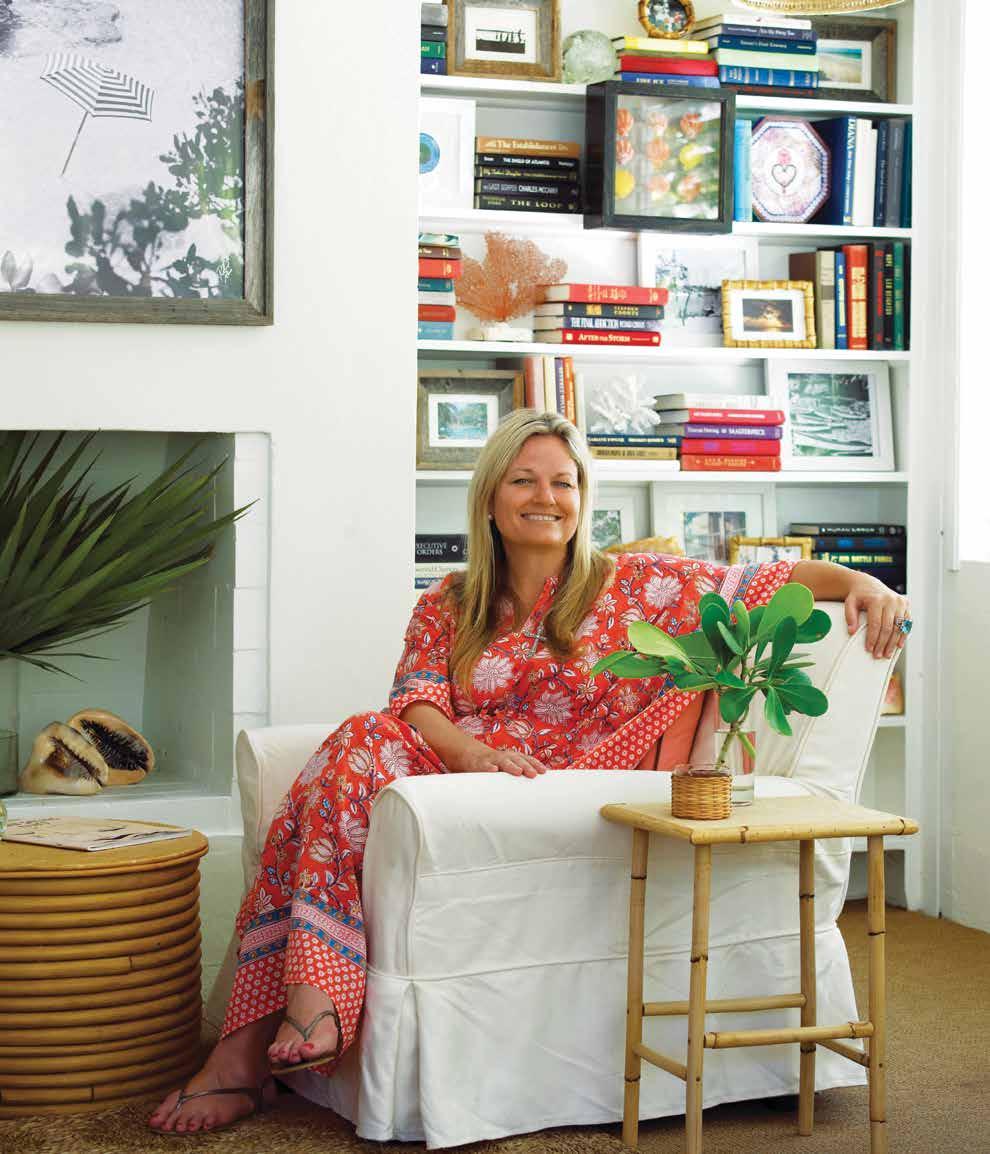
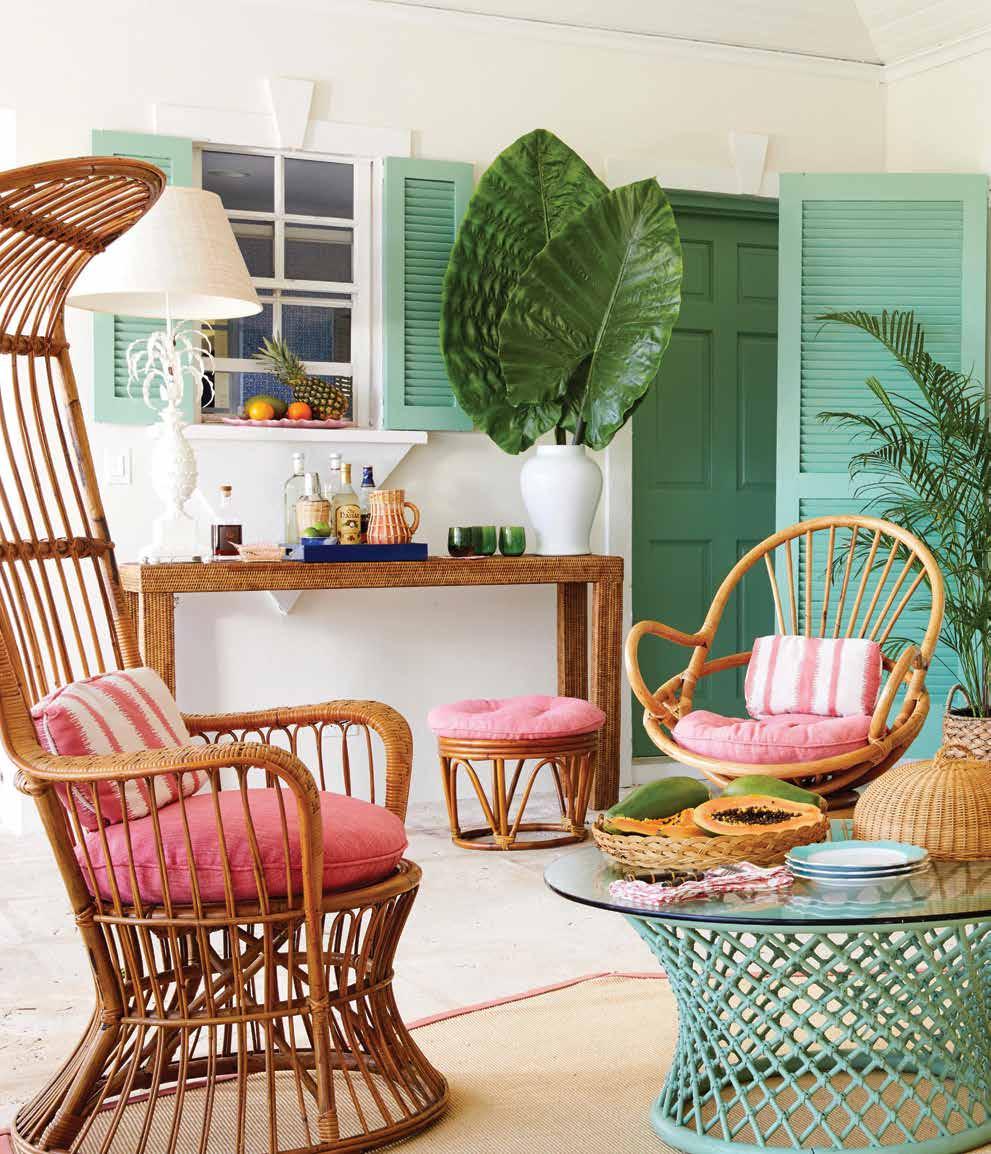
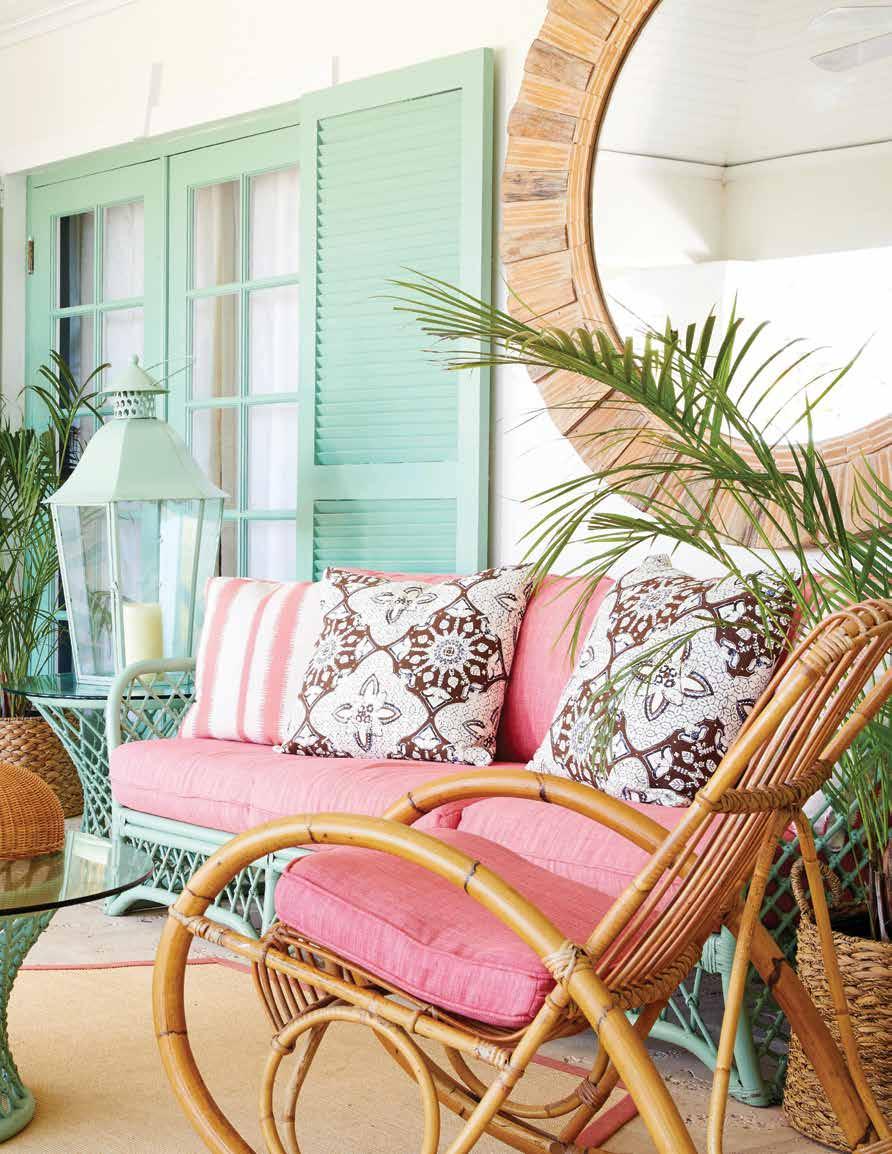
And there are lots of seating areas. “I think our lives are all about joy and frivolity and abundance and generosity,” she says. “And so my rooms always have a lot of seating in them.”
“These are all things I learned when I lived in England,” she continues. “Because the English houses—there’s always a reading light right where you need one. And there’s a little table for your drink, and somewhere for you to put your feet up.”
One of Lindroth’s most anticipated collaborations is her work with The Dunlin, Auberge Resorts Collection, a boutique hotel and one of Auberge’s newest 2024 openings tucked inside the breathtaking landscapes of the Charleston Sea Islands on the Kiawah River. She’s been working with the team at Auberge for “three or four years” on the project and, in many ways, her design there exemplifies her philosophy at scale. She curated every part of the hotel, from the guest rooms to the common areas, the spa, the bar and restaurants. There are plenty of places to put your feet up.
Drawing inspiration from the region’s rich heritage and natural beauty, Lindroth has crafted an immersive experience at The Dunlin that seamlessly blends modern comfort with old-world charm.
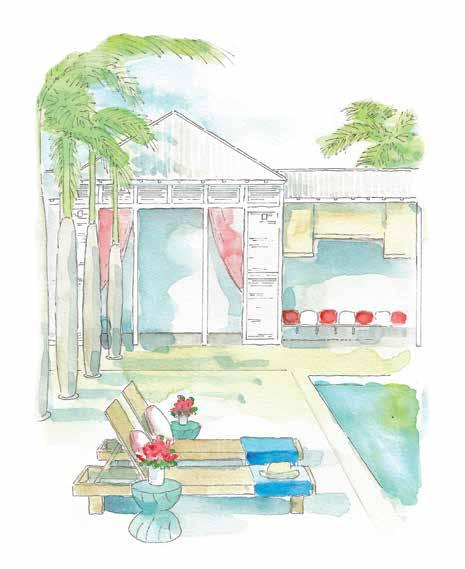
150
Lindroth’s designs, in her own water color and in a photo, are consistently crafted with entertaining in mind, reflecting her role as the consummate hostess.
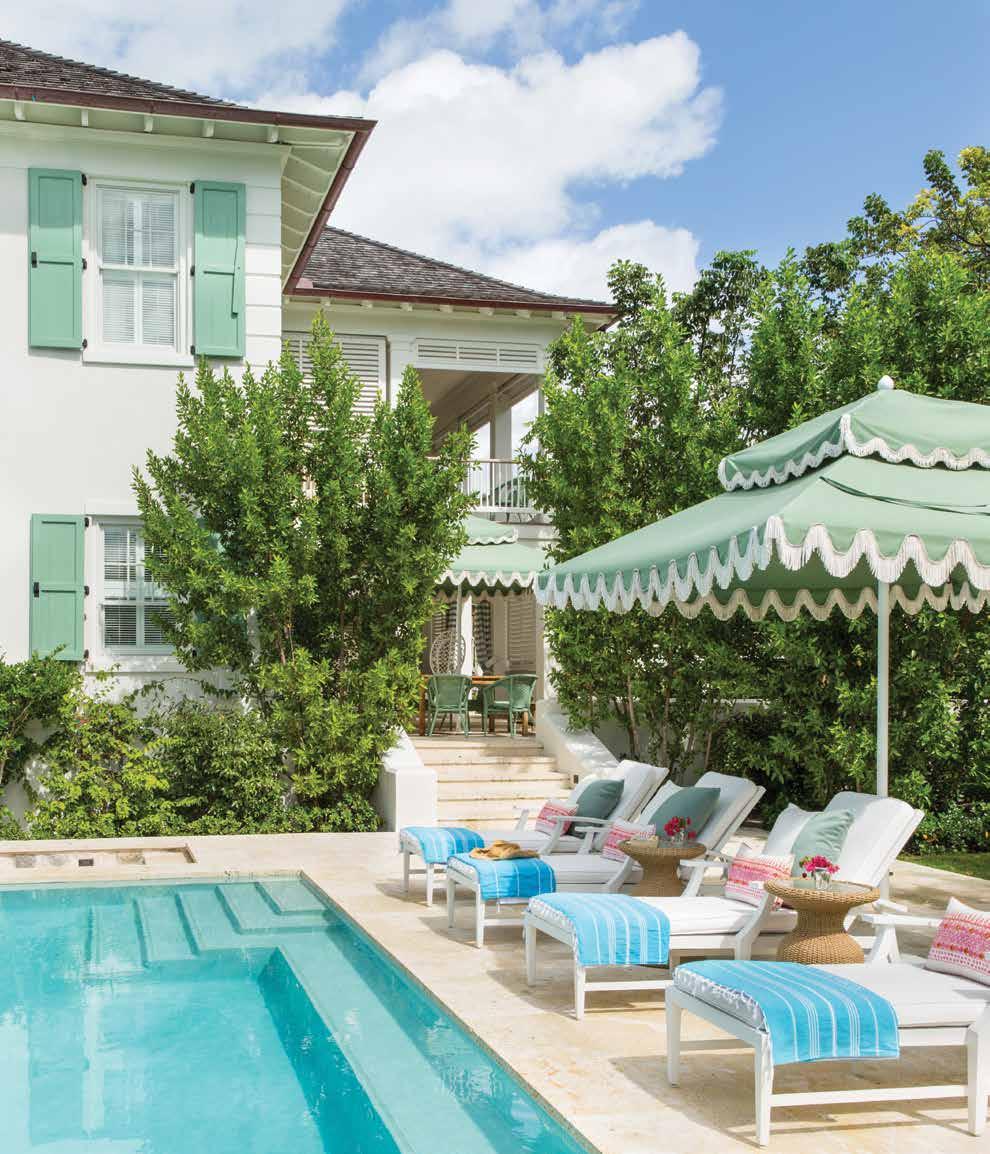
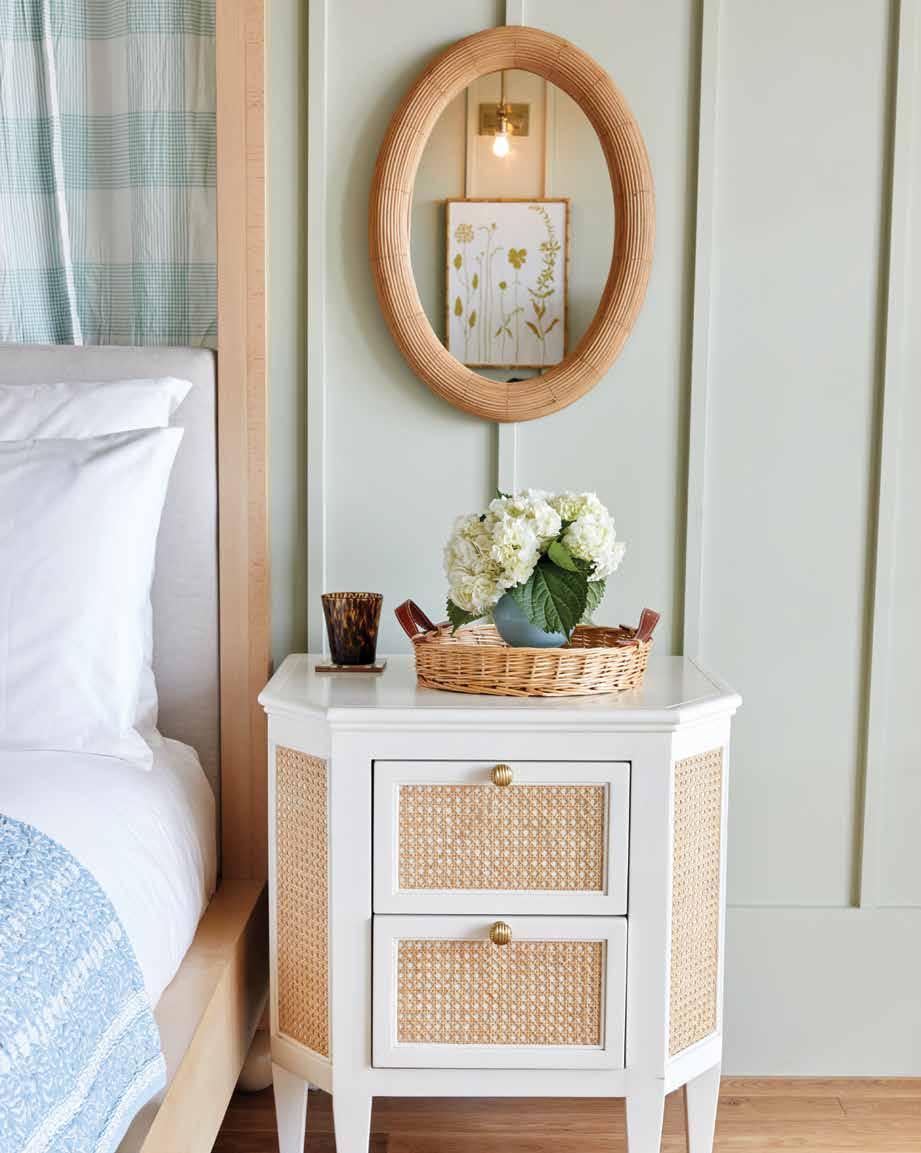
 One of Lindroth’s most anticipated collaborations is her work with The Dunlin, Auberge Resorts Collection, a boutique hotel in the South Carolina Lowcountry on the Kiawah River. Left: A guestroom at The Dunlin. Above: Lindroth’s watercolor inspiration for the room.
One of Lindroth’s most anticipated collaborations is her work with The Dunlin, Auberge Resorts Collection, a boutique hotel in the South Carolina Lowcountry on the Kiawah River. Left: A guestroom at The Dunlin. Above: Lindroth’s watercolor inspiration for the room.
To come up with the hotel’s design concept, Lindroth and her team took a tour of river homes on South Carolina’s coast to draw inspiration. “We pinched all of these ancient-y strange early 20th century Southern [design] idioms. All of the [Dunlin] bedrooms have board and batten.”
Lindroth elevates the humble style with exacting details: “The rooms all have four poster beds and they’re draped in cotton gingham. But there’s still an element of precision and preciseness to them.”
Lindroth is known for her colorful design, which makes her chuckle. Good upholstery, rattan and wicker, cotton prints, and tons of white—white cotton, white linens—she feels, are her hallmarks. “Color is the part that scares me,” she says.
But there’s color aplenty at the Kiawah River property. One color in particular. The Dunlin’s interior is notably and purposefully marsh green.
“Every window, every door, you see the marsh,” she explains. “There’s not a bad room in the hotel because it’s surrounded by this beautiful landscape. And the color that we chose for the room is just like the marshy green. It really is like that layer of warmth.” In that way, Lindroth’s design bleeds into the landscape. “It’s really beautiful,” she says. Even more so when you consider the surrounding property is teeming with
hundreds of 150- to 250-year-old live oak trees that cast off “this lovely shade,” making the area as comfortable as if she had designed the surrounding terrain herself.
Lindroth is particularly excited about the hotel’s buzz-worthy bar, The Willet Room, which will be open day and night and will no doubt fast become a social hub of Kiawah River. It features checkered floors and Drucker barstools and that signature green. In it the room’s focal point is a one-of-a-kind rattan lattice bar wall detail and “a lot of rattan lighting, this whole birdcage concept,” she says, a subtle nod to the dunlin, the titular tiny birds with rust-colored backs, black bellies and notably long, curved bills that winter in the bays and estuaries of South Carolina’s lush coast.
Of rattan, Lindroth is acutely passionate. She admits it has its detractors, but Lindroth defends it staunchly. At The Dunlin, in her hands, and combined along with the many design elements that make her her, it transcends, design alchemy achieved once more.
“We created this environment for [guests] to have an exceptional amount of relaxation and to feel like [they’re] in the countryside and taking a break,” she says. “Our hope is, the minute this hotel opens, it looks like it’s been there for 50 or 100 years.”
In other words: timeless.
154
The many greens Lindroth chose for the rooms compliments the marsh landscape that surrounds The Dunlin.
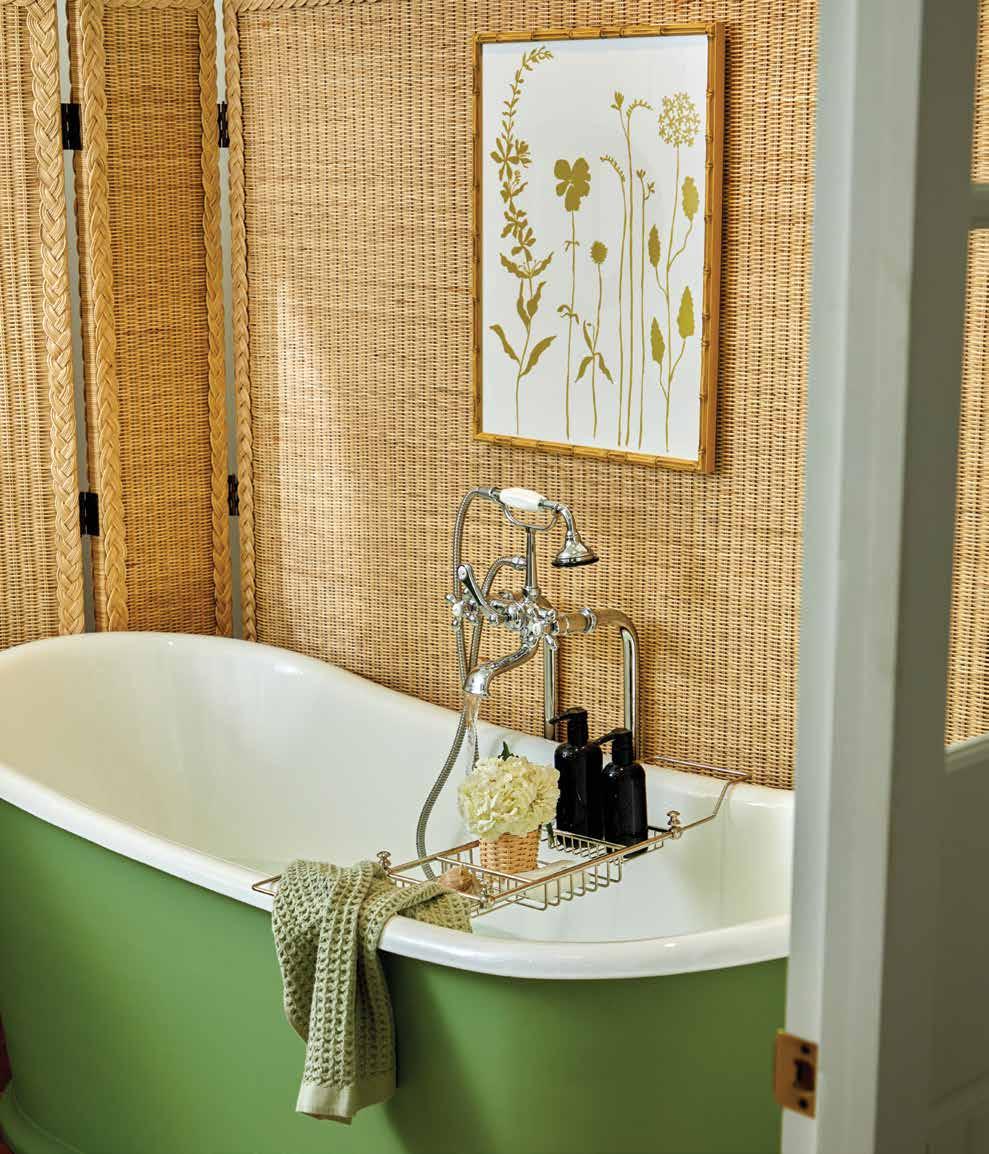

Utah’s Architectural gems
From Versailles-style glamour to contemporary hideaways, the state’s top design creatives embrace the unexpected.
TEXT BY FRANCISCO ALVARADO

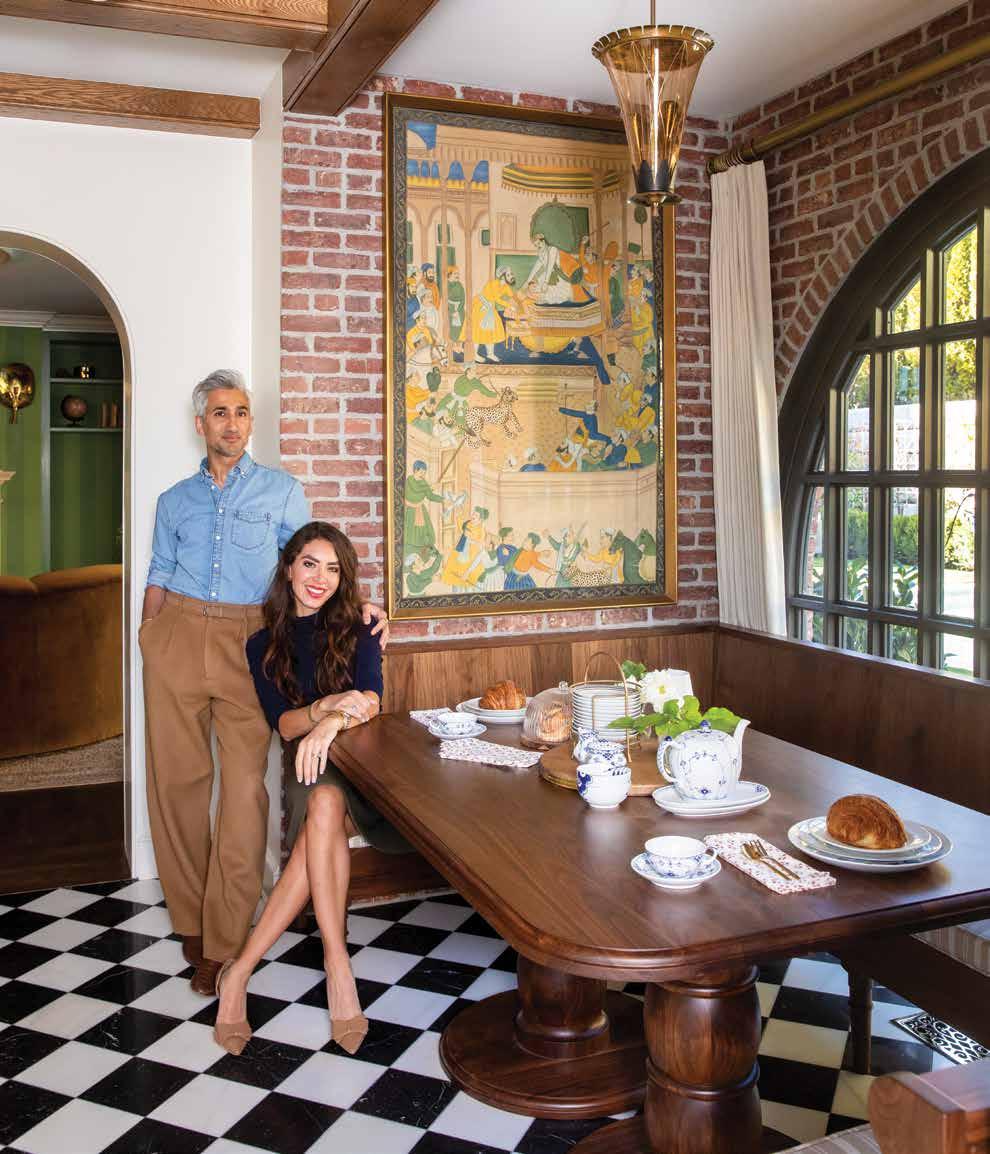
Utah’s unmatched landscape of mountains, plateaus, mesas, canyons and basins offers a remarkable topography unique within the continental United States. Those natural elements serve as the driving force behind the architecture found in the state, where classical elegance, modern minimalism, and stylish innovation converge.
From the timeless charm of classic structures nestled in the historic neighborhoods of Park City to the sleek lines of contemporary masterpieces in downtown Salt Lake City, design firms based in Utah like The Fox Group and AJC Architects weave tradition into modernity. In doing so, they create homes, commercial buildings, and public spaces that reflect a distinct cultural and geographical identity.
Take Tan France, the star of the Netflix series Queer Eye, who set out to build his dream home in Salt Lake City. The Britishborn fashion designer of Pakistani descent tapped The Fox Group, a local architecture firm known for creating timeless, elegant houses with touches of whimsical flair.
Cara and Tom Fox, the wife-and-husband team who lead the firm, delivered a Tudor-style estate on a mountain ridge that draws inspiration from France’s roots, while also capturing the American Midwest vibes of his husband, Rob.
“The moment I arrived in Utah, 18 years ago, I knew this was going to be my home,” Tan says.
“It’s imperially beautiful, with the most diverse landscape. But, mostly, I chose to make this
home because of the incredible people, who made me feel welcome from the very start.”
Tan’s 6,500-square-foot house is a delightful mix of Old European architecture with Southeast Asian accents. For instance, the front facade and kitchen features handmade custom windows that resemble those at Liberty London, one of Tan’s favorite places, a heritage-listed London icon famed for its directional design, cultural collaborations and inspiring curation of luxury fashion. In the master bedroom, The Fox Group team also assembled a 1,000-square-foot walk-in closet with Indian and Pakistani design elements, based on schematic drawings France provided.
“We worked with artisans, such as the stenciling artist who did his beautiful closet art by hand onto the cabinetry,” Cara Fox says. “Creatively, it was a challenge making Rob and Tan’s visions come to life in an artisan, high-quality fashion so that things still looked very custom and well done.”
“I chose The Fox Group because I had known their work from Instagram for years,” says France. “And since Rob and I are not professionals, we needed someone with good taste who could execute our dream home the way we envisioned it.”
Formed roughly two decades ago, The Fox Group is known for specializing in classical styles from the northeast U.S. and Europe, a branch of architecture they recall as having been rare in Utah when they launched their business. “I was always warned by subcontractors not to do such a ‘non-Utah’
159
Previous spread: The Lodge at Blue Sky, Auberge Resorts Collection. Photo by Noe DeWitt.
Left: Cara Fox with client Tan France, in the kitchen of the home built and designed by Cara and The Fox Group. Photo courtesy of The Fox Group.
style,” Fox says. “But when I saw how people took to the designs and how the houses sold so quickly even when we hit a downturn market, I knew we had something going and working.”
While each project is unique, The Fox Group often incorporates a few elements in home designs that serve as the firm’s signature. For instance, Fox will break up black-and-white interiors with a touch of muted blue accents, floors with chessboard patterns, and brass and gold fixtures.
“In our travels, I’ve always taken note of those small elements in historic places such as the White House or the Palace of Versailles, and applied them to my designs,” Cara Fox says. “I love envisioning a finished room over and over in my mind, thinking about how to make every nook and cranny all flow and come together.”
On the more distinctly modern end of the spectrum of Utah architecture, Salt Lake City-based AJC Architects creates buildings that conform to the landscape surrounding the structures. Founded in 1991 by architect Jill Jones, AJC has designed an impressive array of custom homes, hotels, office buildings, museums, and government sites across the state.
“We like to work on projects that are very site-specific [where] the architecture can respond to the surrounding topography,” Jones says, a thread that is ever present in Utah architecture. “We like to use materials that we consider natural, such

160
Above: Cara Fox in The Fox Shop, the Group’s store that offers a timeless and curated collection of stylish furniture and refined living. Photo by Tim Aushunkas.
Right: In addition to designing and building homes, The Fox Group also has a thriving interiors business. “In our travels, I’ve always taken note of small elements in historic places and applied them to my designs,” says Cara. Photo courtesy of The Fox Group.
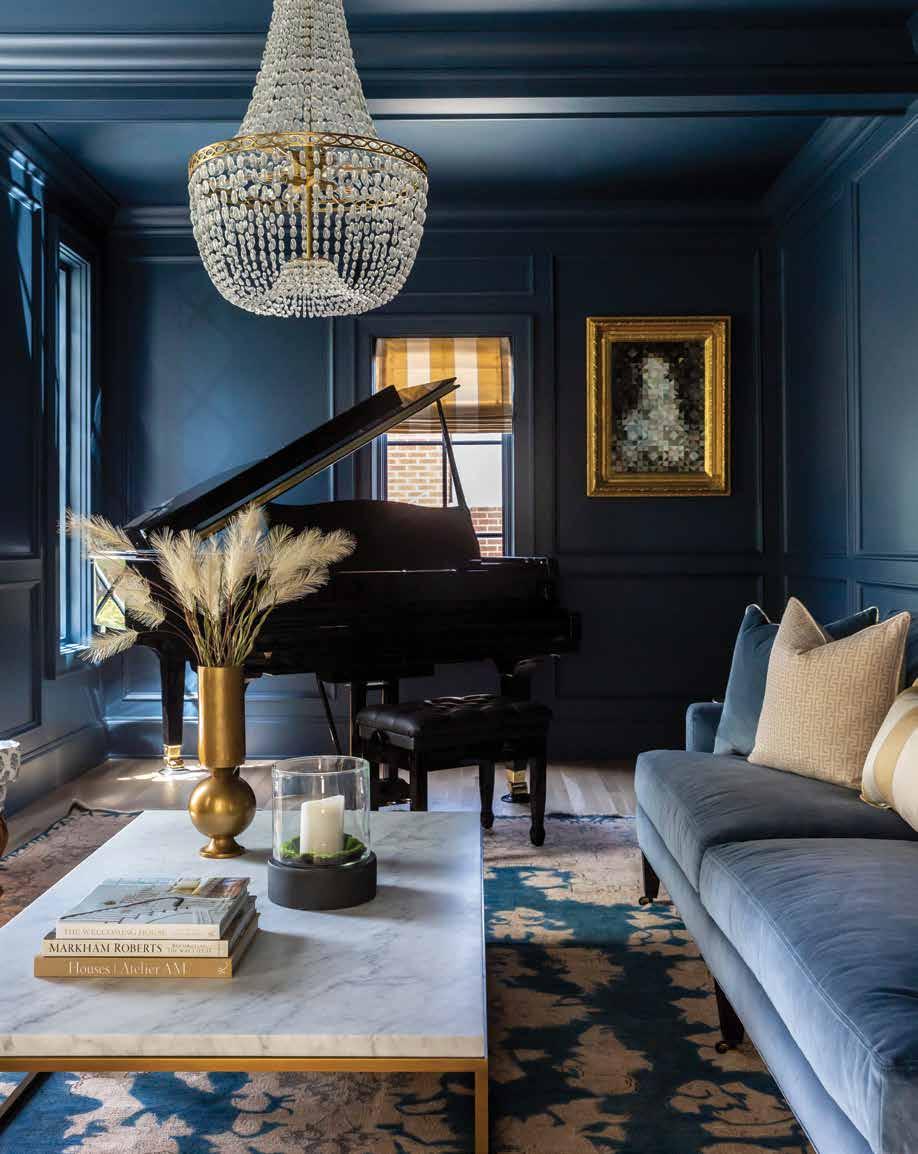
“Our approach is to draw attention to that topography and use materials you can only find here.”
—JILL JONES, AJC ARCHITECTS
as wood, stone, steel, and glass, as opposed to aluminum or stucco. We try to keep things as simple as possible.”
The results are buildings with expansive floor-to-ceiling glass walls supported by steel or timber frames. Despite their modern appearance, the structures look as if they grew out of the earth centuries ago, when Utah’s rocky terrain began to resemble its modern self.
When it comes to the geometry of its projects, AJC focuses on creating a straightforward symmetry, Jones says. “A lot of architects have complicated designs,” she explains. “Our approach is to simplify the geometry, while focusing on one or two key elements that create interest in the building.”
AJC’s uncomplicated approach is on display throughout the firm’s work on The Lodge at Blue Sky, Auberge Resort Collection’s hotel in Wanship, some 30 minutes from Park City. The goal was to create a resort that seamlessly blends with the Wasatch Mountain Range, Jones recalls.
“Instead of designing one large structure for the guest rooms and amenities, we focused on the site characteristics and broke down the overall scale of the project into smaller elements that connect with each other,” Jones says. “For instance, the
resort’s Sky Lodge is a three-story building that opens up to the sky, while the Earth Suites and Creek Houses are individual guest suites that form a strong connection to the land and water on the project site.”
The buildings also draw inspiration from Utah’s mining history—the Sky Lodge’s front steel doors open up to a black, steelwrapped foyer reminiscent of the entrance to a mineshaft. AJC also installed a 30-foot sculpture made from locally mined copper, crystal, and coal near the lobby’s reception area. The guest rooms at the Earth Suites and Creek Houses feature beds placed in front of large windows to maximize unobstructed views of the mountain range.
And just to drive home an inviting aura of natural exclusivity and escape, Edge Spa, the property’s wellness center, is made to resemble a secret bunker on the side of a mountain.
“Utah is such an outdoorsy, exciting state with a broad spectrum environment of mountains, lakes, and deserts,” Jones says. “Our approach is to draw attention to that topography and use materials you can only find here.”
“After living [in Utah], full time, the past 15 years, it’s still my favorite place in the world,” says France.
162
Inside The Lodge at Blue Sky, Auberge Resorts Collection. Photo by Read McKendree.
 PHOTOS BY TIM AUKSHUNAS
PHOTOS BY TIM AUKSHUNAS
NAPA UNEXPECTED
The finest and rarest handmade bikes and tranquil escapes on the planet are in California’s elite Wine Country.
The Napa Valley’s reputation for wine is so grandiose it can be difficult for locals producing anything else to get noticed. Grapes grown on the region’s precious terroir are some of the most prized in the world, so virtually every inch of land that can be turned into a vineyard tends to, in fact, get turned into a vineyard. But the same rolling hills and oak savannas that make Napa and Sonoma counties such a lovely place to knock back a glass of cab also lay out a rich network of rural roads and trails that beckon cyclists of all stripes—and a surprising cadre of makers catering to their custom whims.
Much of Northern California can lay claim to various pieces of cycling lore: nearby Marin is said to be the birthplace of modern mountain biking (there’s a Marin Museum of Biking that dives deep into the sport’s history), and legendary mass-market manufacturers like Salsa and Santa Cruz hail from here. But a small crop of custom builders of luxury, one-of-a-kind bikes lies tucked into wine country, quietly making a compelling case: a bike, built to a client’s exact dimensions, color and material preferences (steel, titanium, carbon fiber), complete with CAD drawings and exacting standards that illustrate exactly why many

164 TEXT BY WINSTON ROSS
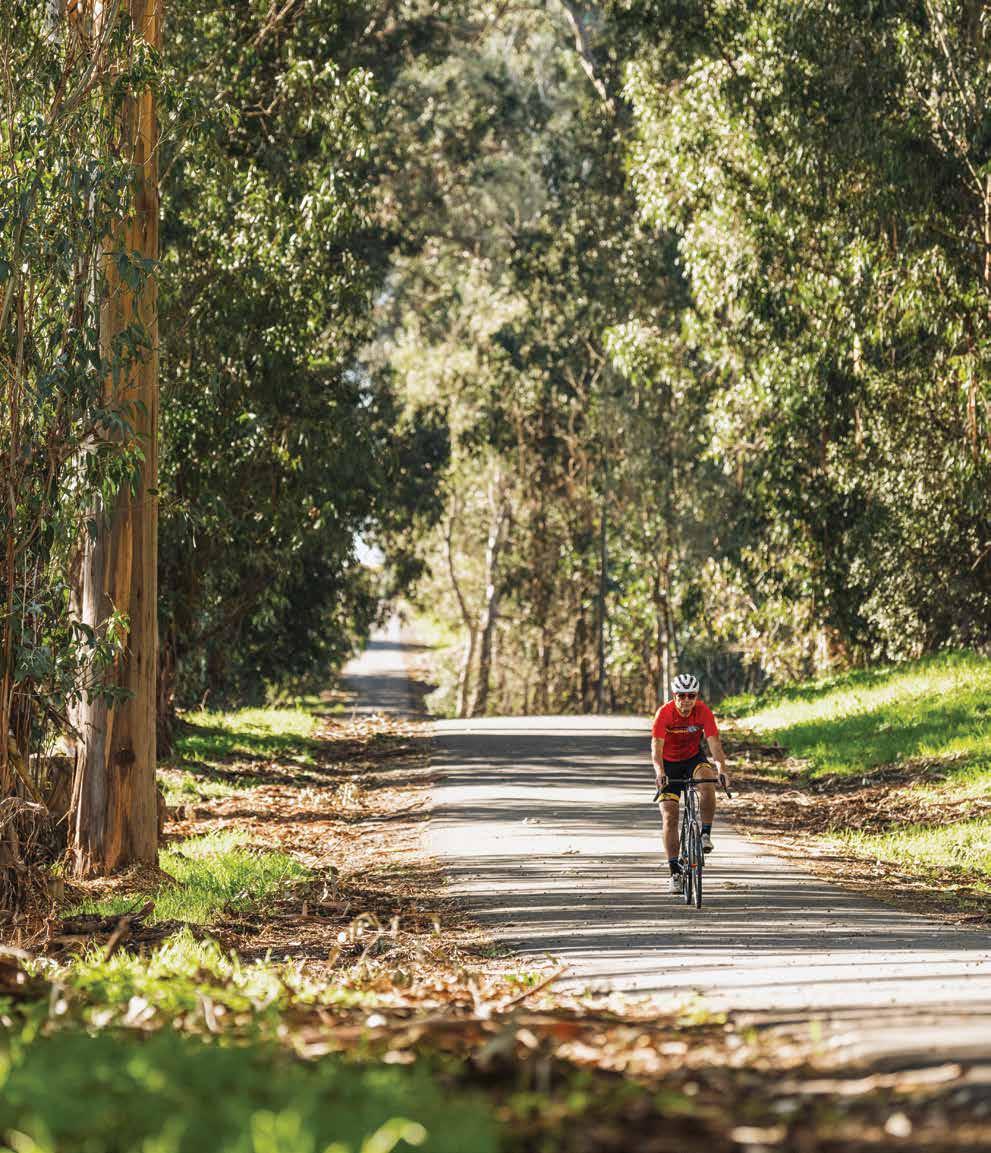

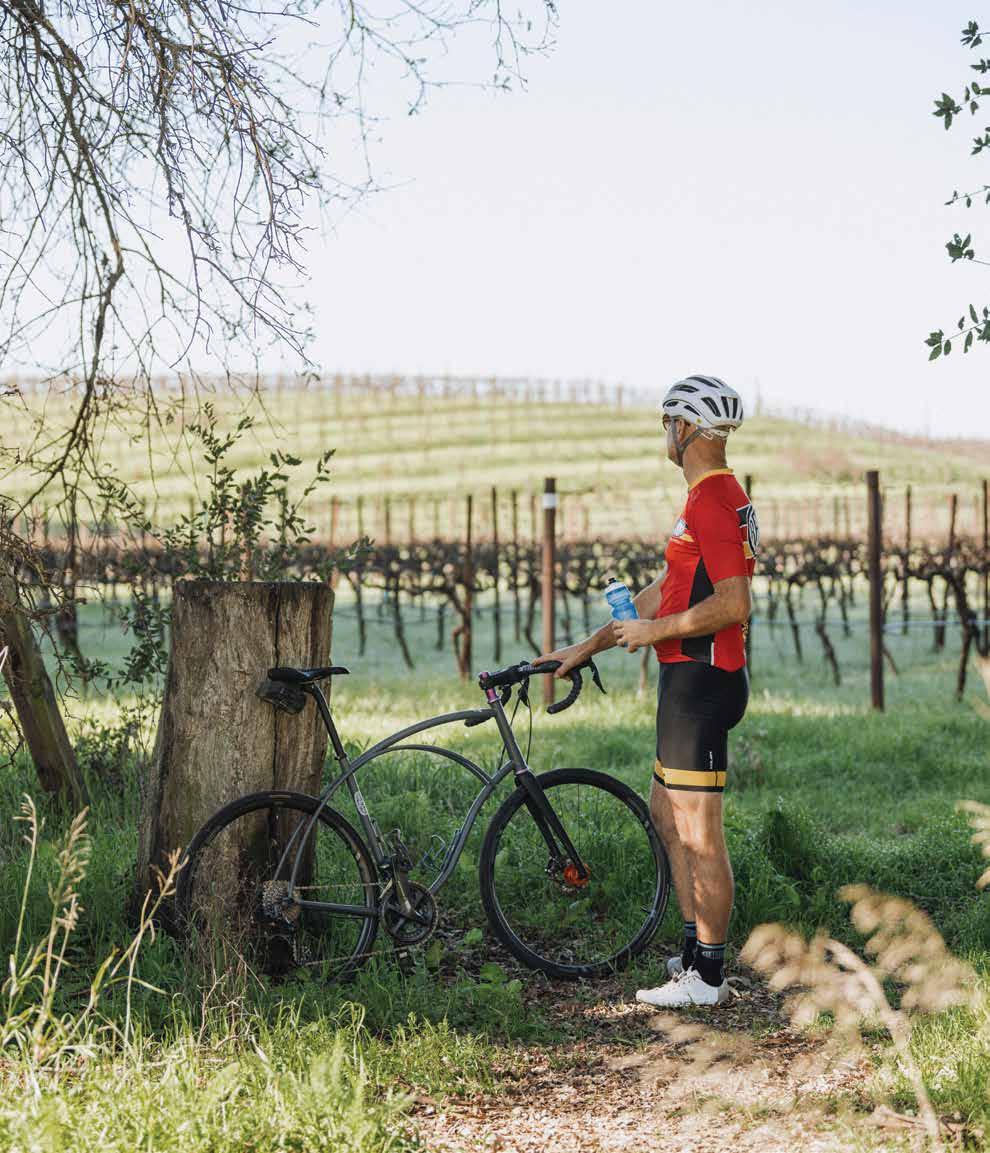
of the brands in the Valley frequently find themselves on “Most Beautiful Handmade Bikes” atop many editor lists. The deposit to join the cue alone generally costs as much as bikes by mass producers, and that’s even before the very customized build begins.
“Bigger companies are building for the mass market,” says John Fitzgerald, who has been making frames and the “forks” that hold the front wheel of bikes in Sonoma County for the past 15 years at Fitz Cyclez. “They don’t know exactly who’s going to be riding the bike, so, in general, they tend to be overbuilt.”
Fitzgerald got his start as an apprentice with Rock Lobster, a renowned builder of frames in Sonoma County, in 2003. His wife’s job in the Bay Area brought the couple to the region, but they were also lured by a thriving cycling scene. Fitzgerald often traverses the roads of what’s known as West County, from Willow Creek to King’s Ridge to Cazadero, where you can “start in the woods and end up in the ocean, really beautiful and different sceneries. It’s a beautiful place to ride bikes,” he says. “There are a lot of cycling events, races where people can meet other cyclists; it’s a great culture here.”
Jeremy Sycip moved to Santa Rosa for that culture in the early aughts. He’d been building bikes since 1991 after also working with Rock Lobster as an apprentice, starting his first shop in Fremont and moving to San Francisco, where he immersed himself
in the cycling scene. The artist who was painting the bikes Sycip made was looking to sell his business, so Sycip bought it, moved, and became a one-man show.
“I just wanted to work with my hands, and got the bug,” he says. “The cycling community is really big up here.”
As such, once spring is in full swing—April, typically—there are monthly cycling rides that launch from Stanly Ranch, Auberge Resorts Collection, in Napa. There’s a Stanly Ranch cycling team, in fact, and the popularity of the sport and activity has woven itself into the fabric of the region, one that prioritizes wellness in all its forms—be it through cardio of any kind, like cycling, or practices like yoga, meditation, or massage.
“Cyclists love to ride here; there are so many different ways to see the valley, to ride from resort to resort, from winery to winery,” says Stanly Ranch Wellness Director Yalda Teranchi. “It’s easy to navigate—and beautiful. Napa and Sonoma are definitely a destination for cyclists.”
What’s more, says Teranchi, the Valley caters to all types of skill sets, from those who simply want to go on a casual cruise to others who want to try the “intense elevation” on offer for a ride that tests their mettle.
It’s easy, then, to see why the region’s cycling prowess dates back to at least the
167
Curt Inglis of Inglis Cycles, takes in the scenery.
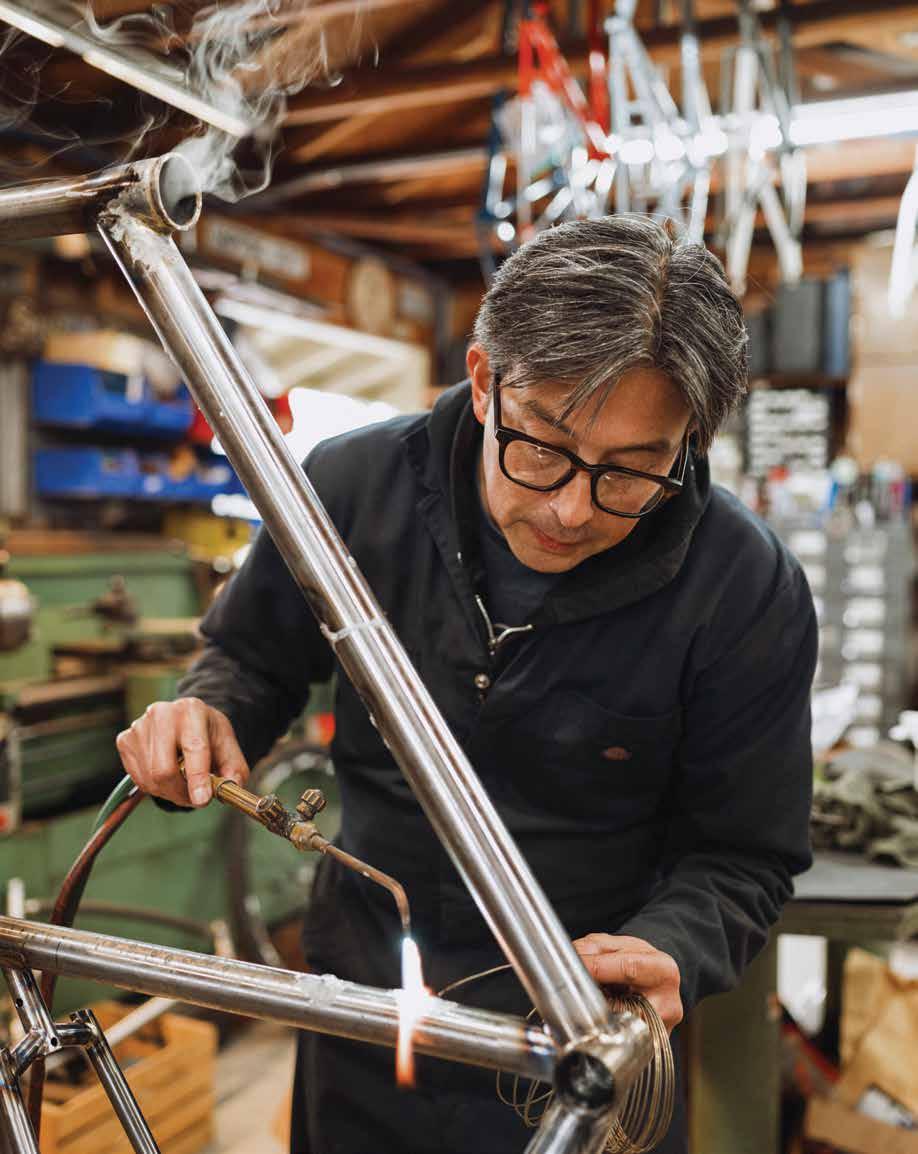
 Above: Custom bikes are made based on the riders measurments. They choose a material (steel, titanium, carbon fiber) and custom colors. Left: Jeremy Sycip hard at work.
Above: Custom bikes are made based on the riders measurments. They choose a material (steel, titanium, carbon fiber) and custom colors. Left: Jeremy Sycip hard at work.
“There’s a desire to have more meaning in the things you buy, more connection.”
JOHN FITZGERALD
‘70s, according to Alec White, the scion of White Industries, a company founded by his dad Doug White out of a spare bedroom in his house in Inverness. The brand is currently based in Petaluma, has weathered four decades of ups and downs in the cycling world, and now sells hundreds of different hand-built components.
Another regional player is Curtis Inglis, who was born and raised in Napa, leaving to join the Air Force after high school, where he learned welding. After getting out of the service, Inglis got into cycling in Chico, and came across his first Retrotec bicycle, a unique style of ride that combines the aesthetic and framing of a beach cruiser with the modern tubing and high-end components you’d find on other bikes. “I fell in love with it,” he recalls, getting to know the owner of the company at the time, who happened to need a welder. Inglis bought the business over and moved it to Napa, where “the bike riding is spectacular,” he says. “It was an easy fit to come back to the Valley.”
Inglis Cycles builds about 35 Retrotec bicycles each year, he says, mostly for customers outside the Valley and all over the world.
Custom bikes make sense for most riders, Alec White argues. “Maybe you’ve got a rider who’s really tall, or really short, and they’re struggling to find a standard-sized frame
that’s going to fit them well. Maybe the crank arms need to be a certain length, and the large manufacturers aren’t catering to this small clientele,” he says. “As people get deeper into the cycling world, they start appreciating the different aspects more and more.”
The pandemic brought another boom in cycling, according to Fitzgerald, which he says played out across the industry, but was particularly kind to custom builders, as riders prioritized outdoor activities and shifted their spending toward adventures. Custom cycles were well-poised to capture a big piece of the market. “You’re buying something you know the history of, and you’re part of the process,” he explains. “There’s a desire to have more meaning in the things you buy, more connection.”
Because he builds not just frames but also forks and bike racks, Fitzgerald only makes about two-dozen bikes a year. He sticks with steel, working with customers through every step of the process, from the CAD designs to the powder-coated or wet-painted color scheme.
Custom bikes allow riders to develop longlasting relationships with the person who builds them, White argues. And it’s hard to imagine a better place to build those relationships than the Napa Valley, where “you can feel like you’re part of the brand,” he says, “that you’re supporting a community.”
170

Next-Generation Wellbeing Awaits at Stanly Ranch
Reach your full potential while optimizing performance at the Auberge Resorts Collection property in Napa Valley.

Stanly Ranch offers exhilarating rides through Napa Valley’s scenic roads and vineyards, where each pedal stroke unveils a new vista or charming winery. Cycling through the region’s backcountry roads is an immersive journey that offers an intimate and unique perspective on this world-renowned region of the world. Private, guided road rides are on offer.
In addition to cycling, Stanly Ranch offers a bounty of options for those interested in wellbeing, where the three wellness destinations, Halehouse, Springhouse and Fieldhouse work in concert to help guests reach their full potential by optimizing the performance of mind and body.
Flanked by a spectacular spa pool with mesmerizing views on property, Halehouse is dedicated to the achievement of personal wellness by helping guests unleash their full, untapped potential. There, leading
wellness specialists and visiting world-class practitioners, medical professionals, and top sports experts tailor individualized programs that incorporate nourishment, hydration, sleep, movement, and targeted treatments. The four wellbeing pillars at Stanly Ranch will be incorporated into the entire guest journey—subtle experiential touches will nod to Purification, Recuperation, Movement and Relaxation.
At Fieldhouse, the movement studio caters to guests who seek more specialized training, offering a host of fitness modalities including HIIT classes, curated outdoor experiences, physical therapy and functional training.
At Springhouse, guests can explore a range of wellness options that help aid in recovery and restoration—Hyperbaric Oxygen Chamber, Cold Plunge Baths, Salt Therapy, Lymphatic Drainage Machines, Cedar Sauna and Steam Room.
172
Above: The Cedar Sauna at Stanly Ranch. Right: The view from The Fieldhouse, looking out onto “Infinity” by sculptor Gordon Huether. Photos by Yoshihiro Makino.
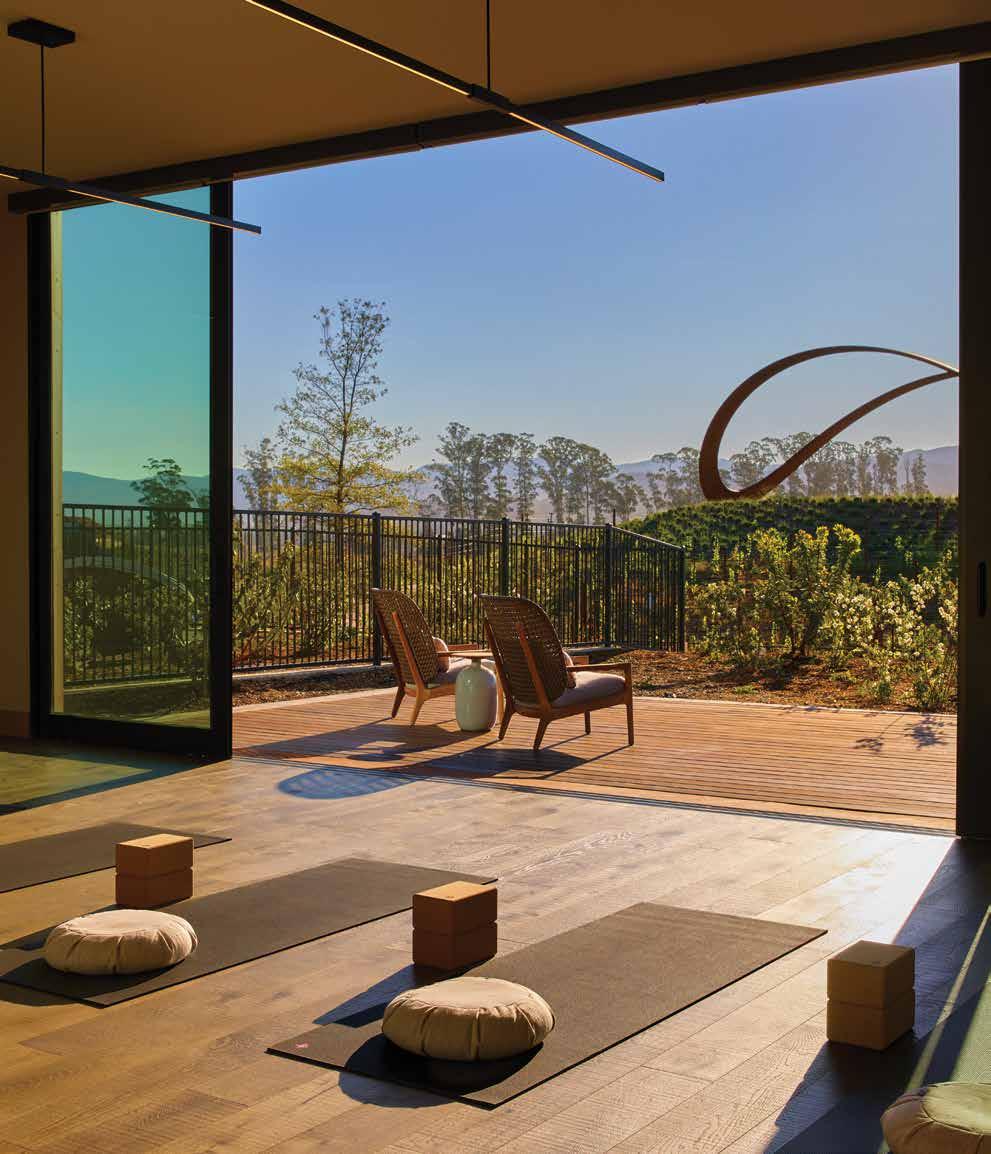
LOS CABOS / TELLURIDE
 Chileno Bay, Auberge Resorts Collection. Photo by Chad Wadsworth.
Chileno Bay, Auberge Resorts Collection. Photo by Chad Wadsworth.

Escape
At Home Auberge with

In luxury residences around the globe, Auberge Resorts Collection creates magnificent spaces amplified by impeccable service, restorative wellness, culinary innovation, and endless opportunities to play.
TEXT BY LINDSEY KESEL
Auberge Resorts Collection goes a cut above with a level of otherworldly service and care. The properties are best-in-class. The design of each informed carefully by a sense of place.
At Auberge, residents experience aroundthe-clock concierge care services, which in urban settings can make reservations at exclusive restaurants notorious for having hard-to-get tables, or tickets to much in-demand concerts and events. Even in rural locations, nothing is out of reach.
In short, from urban abodes with an uptown address to expansive estates in exotic locales, Auberge Resorts Collection’s residences offer lifestyles that evoke a sense of wonder. The magic of Auberge’s well-crafted approach to luxury design and hospitality lies in how the brand artfully captures the soul of a destination and brings it to life through wildly creative embodiments of upscale living.
Leaning into the vibrant energy of the locale, each Auberge enclave is a sublime fusion of culture, cuisine, and environment that has been carefully brought to life through masterful design. In its ever-expanding portfolio of residences, an elite level of talented professionals—from architects and designers to on-site ambassadors—are pushing the Auberge lifestyle to a new pinnacle. World-class amenities abound across Auberge’s eclectic array of homes, villas, and estates—from private tours
to personal shopping—all in service of creating exalted communities that equally honor recreation and retreat.
At Stanly Ranch, Auberge’s award-winning Napa Valley retreat, The Villas and Vineyard Homes offer an immersive Wine Country adventure beset by rolling vineyards, culinary gardens, and the Mayacamas Mountains. On acres of private ranch land, residents are treated to a wealth of activities and indulgences—the Provence-style 75-foot Lavender Pool, scenic bike path and guided cycling tours, Halehouse spa, Fieldhouse gym and Springhouse for restoration and recovery, and fresh-from-the-earth culinary offerings highlighting produce harvested from the on-site grange. From JZMK Partners and Clausen-Collaborative Interior Design, The Villas reflect a modern Napa motif accentuated with leather upholstery, white oak ceiling planks, and a neutral color palette. In the Vineyard Homes—featuring sensorial architecture from Forest Studio’s Bob White and refined interiors by Edmonds & Lee Architects—a private pool, an outdoor fireplace, and generous al fresco entertaining spaces celebrate the region’s gathering spirit.
Auberge’s newest Mexico property, Susurros del Corazón in Punta de Mita, Mexico, stages stunning bluff-top and ocean-edge homes on the Bay of Banderas, from three-bedroom Beach Casitas to the sixbedroom Presidential Villa. Centered around cascading scallop-shaped swimming pools
177
Jeff Kelley, an owner at Chileno Bay, Auberge Resorts Collection in Cabo San Lucas, Mexico, fishing off his water bike. Photo by Chad Wadsworth.
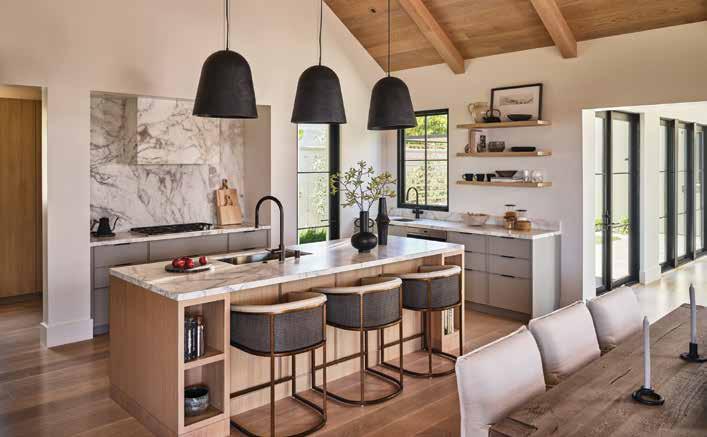
fronting a white sand beach, the spectacular 33-acre resort incorporates four original dining concepts, including the the property’s signature oceanfront restaurant Casamilpa. Immersive therapies and engaging workshops are available through ONDA spa, along with Latin dance lessons, beach yoga, and sunrise meditation sessions. In the contemporary, indoor-outdoor residences designed by Paul Duesing Partners, pebbled floors, heritageinspired handcrafted finishes, regional wood accents, and artisan wall coverings balance tropical relaxation with the formality of clean lines. Expansive floor-to-ceiling windows forge a joyful interconnectedness between the open, airy spaces and the verdant jungled cliffs on a pristine stretch of beach.
Auberge owner Jeff Kelley says becoming a resident at Chileno Bay Resort & Residences, Auberge Resorts Collection in Cabo San
Lucas, Mexico, was a turning point in his life. Since moving into a spacious four-bedroom Ocean View Villa overlooking the Sea of Cortez, his frequent south-of-the-border surf trips from San Diego are vastly enriched by the resort’s many thoughtful embodiments of luxury and convenience. “From full-service home management and maintenance, to fantastic cuisine, everything you need is right at your disposal, and it’s all top-tier,” he says.
With pristine coral reefs and calm waters, the protected cove of Chileno Bay is an ideal playground for Kelley, his children, and his grandchildren. “The resort has the most amazing beach club with all the toys— stand up paddle boards, kayaks, Schiller water bikes and those giant SUPSquatch inflatables that can fit 10 people—really everything you could possibly imagine for being on the water,” he notes.
Above: At Stanly Ranch’s residences, Vineyard Homes feature sensorial architecture from Forest Studio’s Bob White and refined interiors by Edmonds & Lee Architects.
Right: The Vineyard Homes at Stanly Ranch are equipped with private pools, outdoor fireplaces and generous al fresco entertaining spaces that celebrate the region’s gathering spirit. Photos by The Ingalls.
178
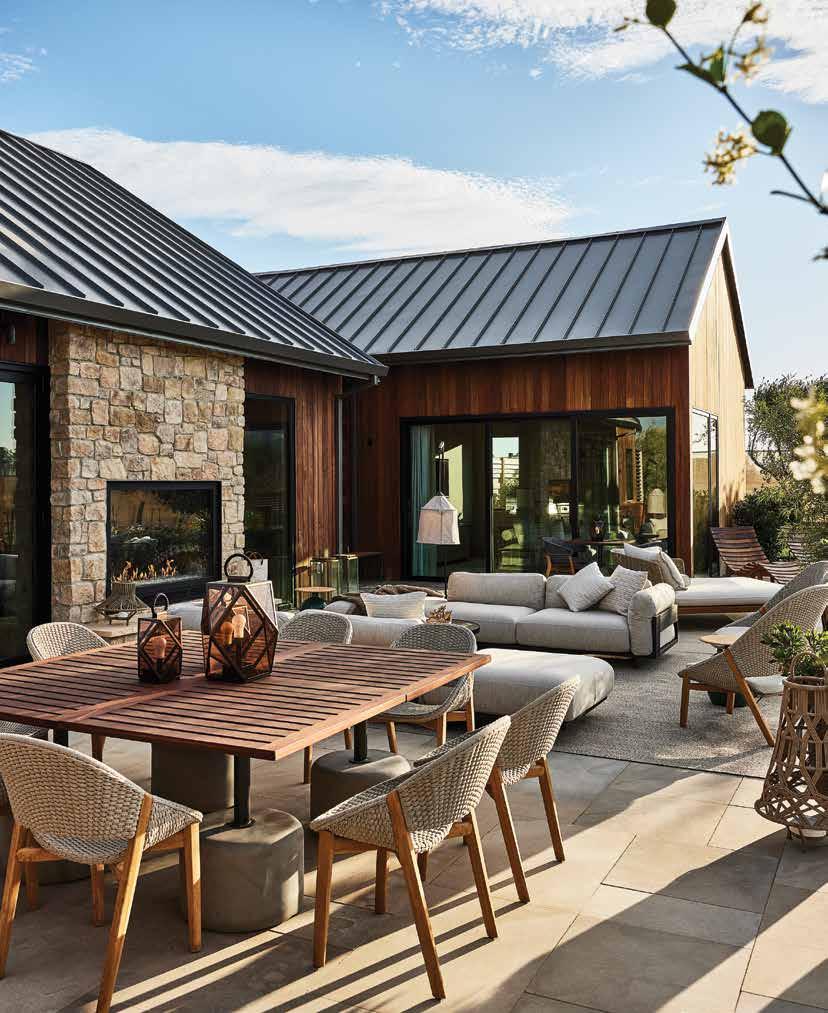
 Above and right: Auberge’s newest Mexico property, Susurros del Corazón in Punta de Mita, stages stunning bluff-top and ocean-edge homes on the Bay of Banderas. Photos by The Ingalls.
Above and right: Auberge’s newest Mexico property, Susurros del Corazón in Punta de Mita, stages stunning bluff-top and ocean-edge homes on the Bay of Banderas. Photos by The Ingalls.
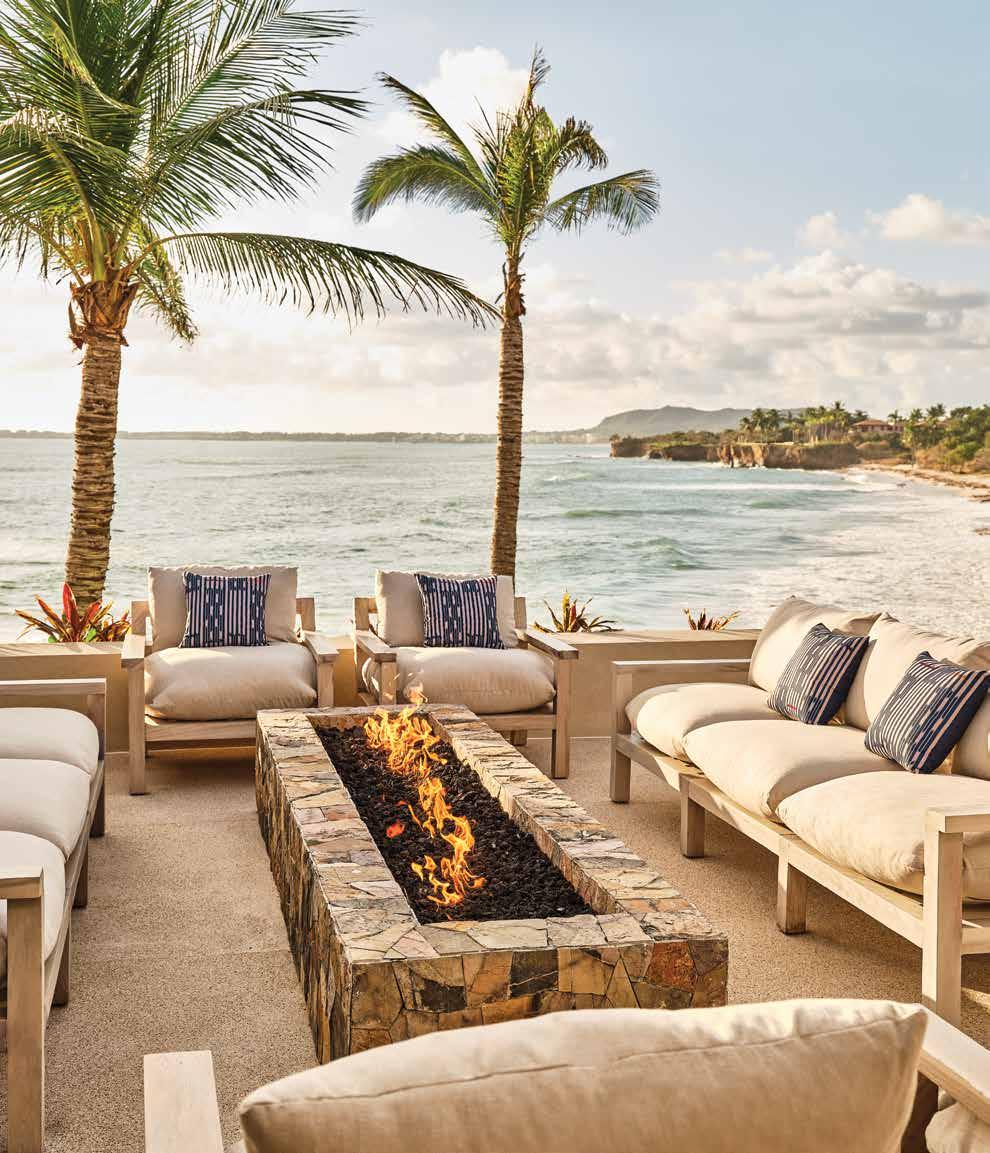
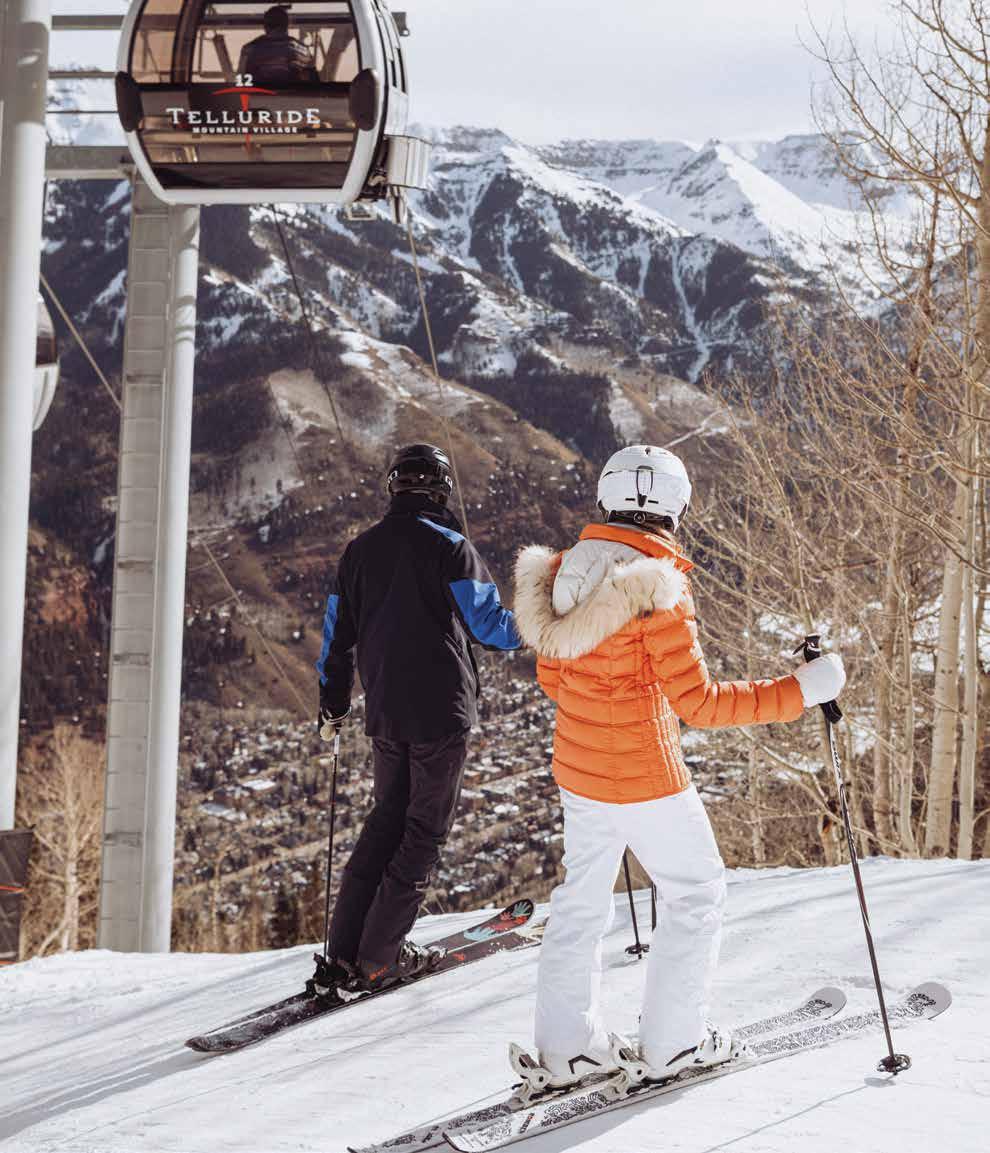
“I am just at peace being here, in Telluride and The Madeline.”
MICHAEL ANTIERI
One of Kelley’s favorite ways to unwind is the par-72 Tom Fazio-designed golf course just outside the resort. Though the links are typically for members only, Chileno Bay Club reserves a number of tee times for Auberge residents and guests. Opportunities like this, and the strong sense of community within the resort, make regular Cabo trips all the more exciting for Kelley, even on solo visits. “We have a really close family of owners at Auberge,” he says, “I always feel like I’m home because of the network of friends I’ve made.”
At Madeline Hotel and Residences in Telluride, Colorado, Auberge owners Michael and Leigh Ann Antieri say their quintessential mountain-modern home and surrounding neighborhood is perfectly in sync with the region’s majestic 14,000-foot peaks and alpenglow sunsets. “Auberge has a culture and character we haven’t found anywhere else,” says Michael, who likens Madeline’s elevated après-ski ambiance to their favorite European getaway, Zermatt Ski Resort in the Swiss Alps.
What makes the Antieris feel most at home with Auberge is the highly devoted personal attention and abiding fivestar service. During Christmas of 2020, Madeline’s team delivered an exceedingly personalized service: “We had never been here for Christmas and were so delighted
to find the whole resort was bursting with holiday cheer,” says Leigh Ann. “We decorated cookies—a big tradition for our family—and the staff served us an incredible Christmas dinner and made it extra special.”
Above all, the couple appreciates the wellrounded experience Auberge imparts. “Our Telluride visits aren’t just about going downhill anymore,” Michael notes. “As we’ve grown older and our daughters and now grandchildren are tagging along, it’s the whole package—being able to share it with family and friends, savoring wonderful meals and experiences together. ”
Adding to the Auberge Resorts Collection anthology of phenomenal properties, a number of urban and resort projects are currently in development—each with distinctive attributes that mesh prestige with a sense of place. Coming soon to the sun-kissed sands of Florida, the iconic Shore Club on the Miami Beach waterfront and The Residences at Shell Bay in Florida, just north of Miami, embody the extraordinary design-forward, ultraluxury approach Auberge is known for.
For the revitalization of the Art-Deco landmark The Shore Club, opening in 2027, Robert A.M. Stern Architects captures the energy and opulence of South Florida’s dynamic coastal scene, with collaboration
183
In addition to offering ski-in ski-out access and numerous amenities, Madeline residents Michael and Leigh Ann Antieri say the culture at Auberge is perfectly matched to the alpine elegance of the area.
Photo by Tim Aukshunas.
from London designer Bryan O’Sullivan and Kobi Karp Architecture and Design. The historic Cromwell Hotel becomes a private entrance and lobby for The Tower, an 18-story marvel of Miami Modern design housing 49 exclusive beachfront residences. Each with a unique floorplan and unobstructed ocean views, the homes feature nautically inspired undulating terraces, rich woods, sinuous lines, and brass accents. On the three-acre grounds, Shore Club owners enjoy full access to three swimming pools, a beauty atelier spa and wellness center, residents’ library and maze-like gardens.
Inside the 18-acre Shell Bay sanctuary, debuting in 2026, the coalescence of luxury and leisure manifests in a medley of sport and wellness amenities curated by worldrenowned athletes and experts—from the garden-set Shell Bay Racquet Club to the 48-slip marina and yacht club. The 130acre resort includes 108 Auberge high-rise residences featuring open-concept layouts, panoramic views via wraparound terraces and lavish interiors from global hospitality innovator AvroKO Design. Conceived by landscape architecture firm Nievera Williams Design, the sweeping Shell Bay playground integrates a Greg Norman Championship Golf Course, dockside cocktail bar, dogwalking trail, exotic orchid garden and children’s outdoor discovery park.
Another Auberge endeavor igniting a buzz is The Knox Hotel and Residences in Dallas, Texas, debuting in 2027. Set on four-acres in The Knox neighborhood along the Katy Trail, the boutique property is crafting an ambiance of intimate glamour with nextlevel-luxury hotel interiors from acclaimed Swedish designer Martin Brudnizki. Spacious
with high ceilings, entrancing city views and enviable closets, The Knox’s 48 residences tease a mix of subdued sophistication and elegant flamboyance, care of local design superstar Chad Dorsey. Also included in The Knox: an idyllic park, indoor pool, movement studio and curated retail and restaurants. But thtat’s not all. Auberge is turning out another first-class urban oasis in Texas—The Birdsall, in Houston’s River Oaks neighborhood, is scheduled to open in 2027.
Through its exquisite assortment of residences in existence, and new expressions of affluent living on the way, Auberge Resorts Collection is redefining the essence of luxury homeownership. With the adoption of the Auberge lifestyle comes an open invitation to enjoy highly curated experiences at home, and across all Auberge destinations worldwide.
“Finding a home with Auberge was one of the best things I’ve ever done from a quality of life standpoint,” says Kelley, who credits the impassioned Chileno Bay ambassadors and concierge team with seeking excellence at every turn. “Whenever I get to know new faces at the resort, I’m always hearing how great the service is and how much people love it here. Nobody wants to leave this place,” he adds.
For the Antieris, their Auberge residence has become much more than a vacation spot, but a genuine home away from home and a steadfast source of revitalization and renewal. “I am just at peace being here—in Telluride and at Madeline,” says Michael. “The countless activities, the exceptional cuisine, and all the other marvelous touches are just icing on the cake.”
AUBERGE RESORTS COLLECTION RESIDENCES
Auberge Beach Residences
Fort Lauderdale, Florida
Chileno Bay
Los Cabos, Mexico
Element 52
Telluride, Colorado
Esperanza
Los Cabos, Mexico
Goldener Hirsch
Deer Valley, Utah
Hotel Jerome
Aspen, Colorado
Madeline
Telluride, Colorado
Stanly Ranch
Napa Valley, California
Susurros del Corazón
Punta de Mita, Mexico
The Dunlin
Kiawah River, South Carolina
COMING SOON
Shell Bay, Florida (late 2026)
The Birdsall, Houston, Texas (2027)
The Knox, Dallas, Texas (2027)
Shore Club, Miami Beach, Florida (2027)
184
 Jeff Kelley enjoying the water in Chileno Bay.
Photo by Chad Wadsworth.
Jeff Kelley enjoying the water in Chileno Bay.
Photo by Chad Wadsworth.

Experience the WORLD of AUBERGE

Auberge du Soleil, Napa Valley, California
Bishop’s Lodge, Santa Fe, New Mexico
Bowie House, Fort Worth, Texas
Chileno Bay, Los Cabos, Mexico
Collegio alla Querce, Florence, Italy (Late 2024)
Commodore Perry Estate, Austin, Texas
Domaine des Etangs, Massignac, France
Element 52, Telluride, Colorado
Esperanza, Los Cabos, Mexico
Etéreo, Riviera Maya, Mexico
Goldener Hirsch, Deer Valley, Utah
Grace Hotel, Santorini, Greece
Hacienda AltaGracia, Costa Rica
Hotel Jerome, Aspen, Colorado
Madeline, Telluride, Colorado
Mauna Lani, Hawaii
Mayflower Inn and Spa, Washington, Connecticut
Primland, Blue Ridge Mountains, Virginia
Sleeping Indian Lodge, Ridgway, Colorado
Solage, Napa Valley, California
Stanly Ranch, Napa Valley, California
Susurros del Corazón, Punta de Mita, Mexico
The Dunlin, Kiawah River, South Carolina
The Inn at Mattei’s Tavern, Los Olivos, California
The Lodge at Blue Sky, Park City, Utah
The Vanderbilt, Newport, Rhode Island
White Barn Inn, Kennebunk, Maine
Wildflower Farms, Hudson Valley, New York
COMING SOON
Shell Bay, Florida (late 2026)
The Hearst Hotel, San Francisco, California (2026)
Shore Club, Miami Beach, Florida (2027)
The Birdsall, Houston, Texas (2027)
The Knox, Dallas, Texas (2027)

188
The Lodge at Blue Sky as featured in “The Horse Thief” and “Utah’s Architectural Gems.” Photo by Blake Bekken.
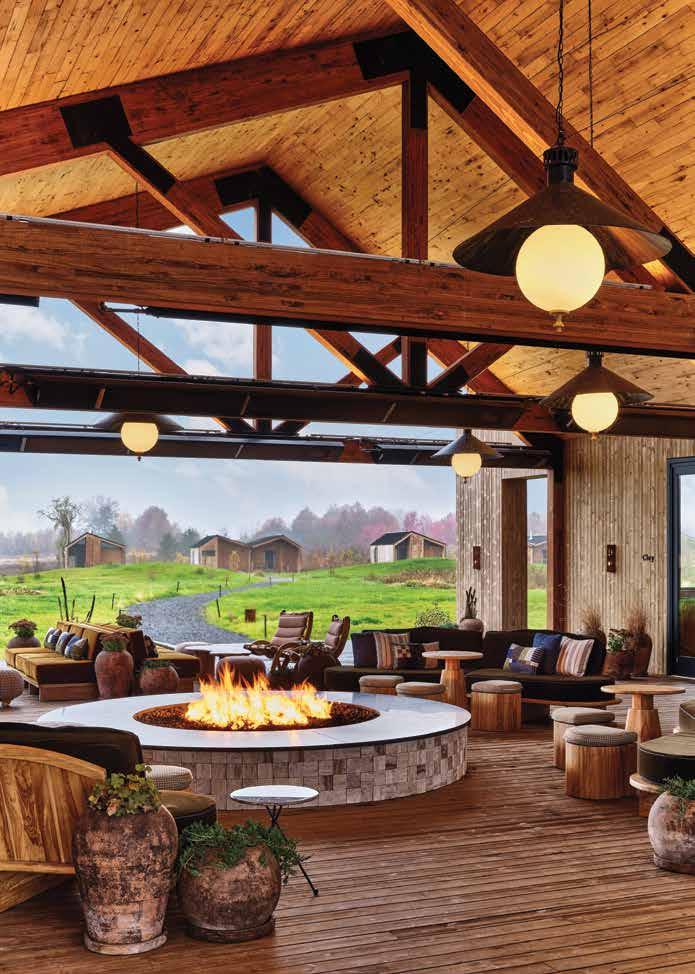 Wildflower Farms is featured in “Crafting Luxury,” about artisans living and creating in the Hudson Valley. Photo by Read McKendree.
Wildflower Farms is featured in “Crafting Luxury,” about artisans living and creating in the Hudson Valley. Photo by Read McKendree.
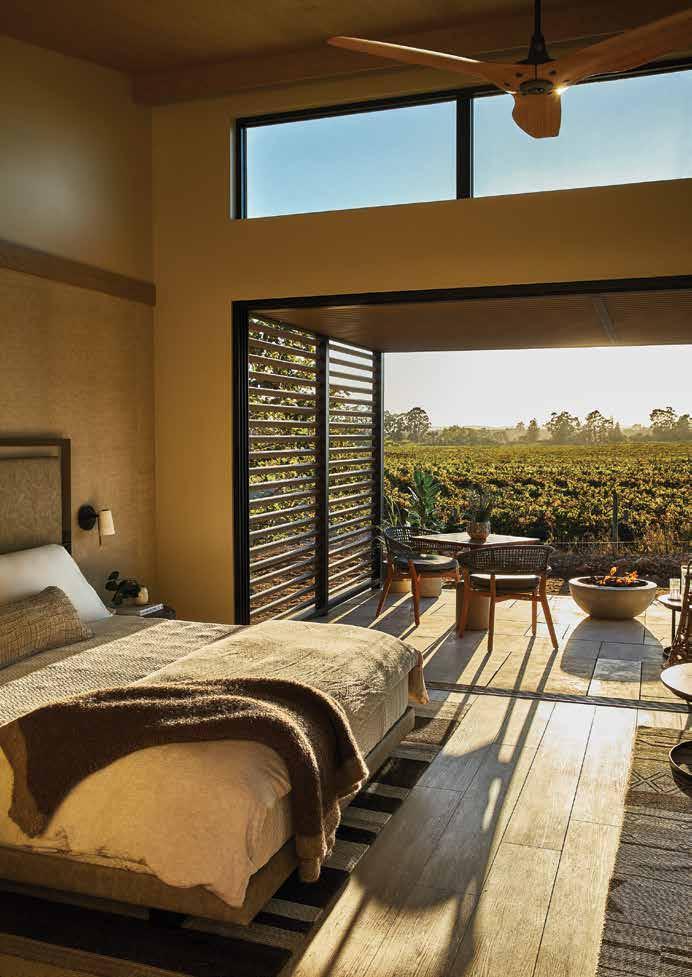 Stanly Ranch, the bold next-generation escape, is featured in “Unexpected Napa.” Photo by The Ingalls.
Stanly Ranch, the bold next-generation escape, is featured in “Unexpected Napa.” Photo by The Ingalls.

191
Read about Mexico’s spirits on the rise, including raicilla and unique gin formulations, in “Ancient Roots, Modern Intrigue” featuring Susurros del Corazón in Punta de Mita. Photo by The Ingalls.

192
Mayflower Inn & Spa, the stylish Connecticut countryside retreat, as featured in “A Portrait of Small-Town Splendor.” Photo by Nicole Franzen.
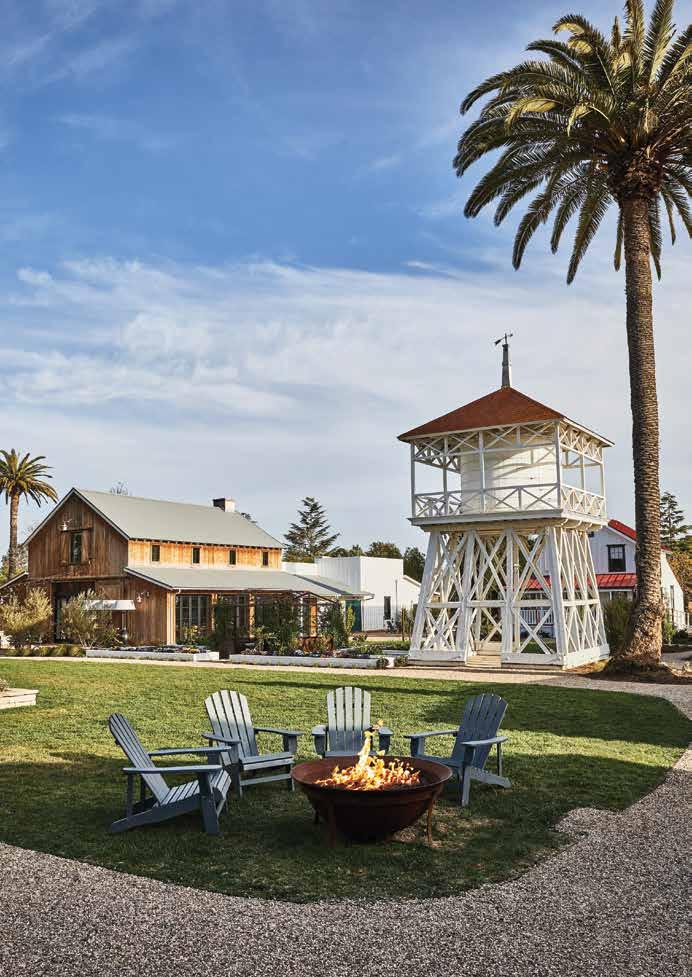 Read about Los Olivos’ legendary landmark, The Inn at Mattei’s Tavern, in “The Opulence of Edible Gold.” Photo by The Ingalls.
Read about Los Olivos’ legendary landmark, The Inn at Mattei’s Tavern, in “The Opulence of Edible Gold.” Photo by The Ingalls.
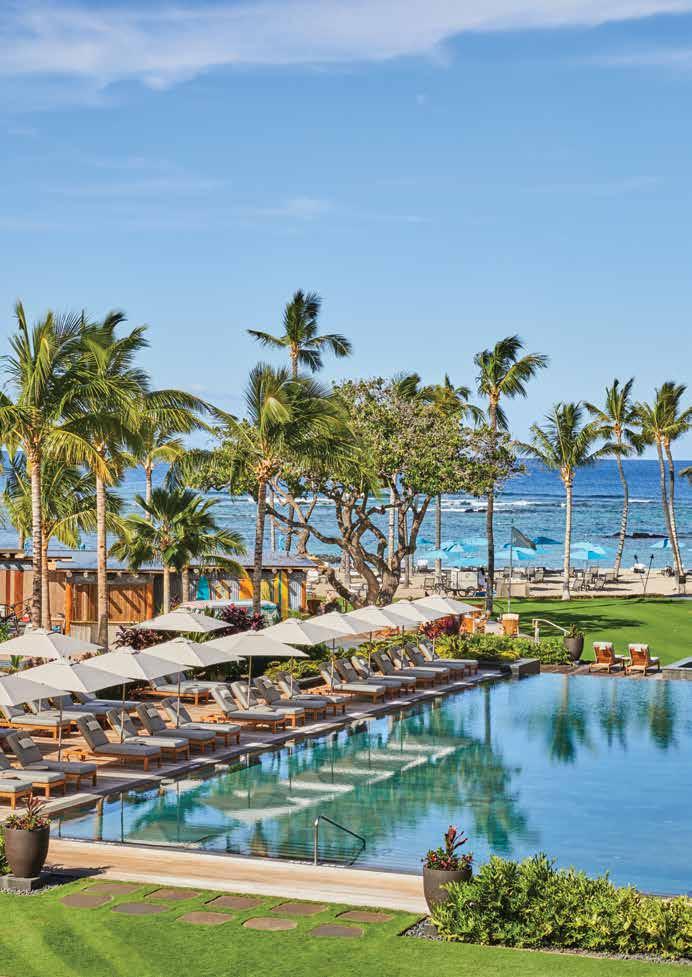 Mauna Lani, a sacred oasis on the Big Island, as featured in “The Art of the Wave.” Photo by Nicole Franzen.
Mauna Lani, a sacred oasis on the Big Island, as featured in “The Art of the Wave.” Photo by Nicole Franzen.

195
Bishop’s Lodge is featured in “The Soul of Santa Fe.” Photo by The Ingalls.
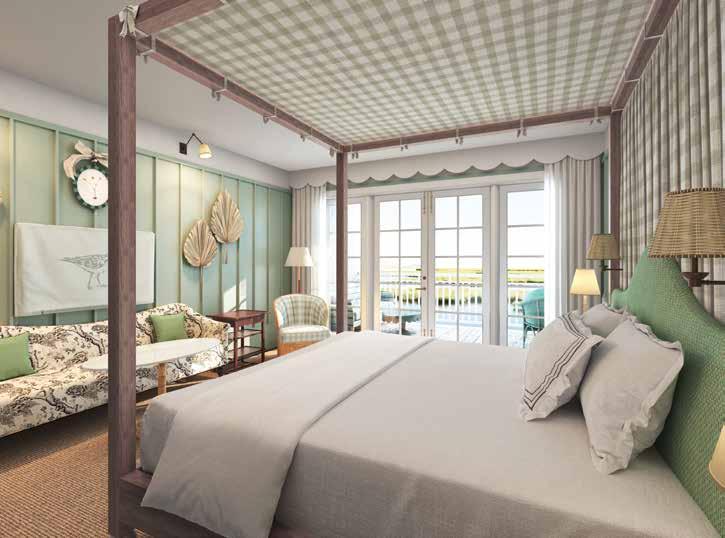
196
The Dunlin in Kiawah River, South Carolina, is featured in “Amanda Lindroth’s Timeless Style.”

197
The iconic downtown mansion brimming with Gilded Age glamour, The Vanderbilt, is featured in “Nick Mele’s Newport Wonderland.” Photo by Noe DeWitt.
 Hotel Jerome in Aspen, Colorado, is featured in “Dining Above the Clouds.” Photo by Noe DeWitt.
Hotel Jerome in Aspen, Colorado, is featured in “Dining Above the Clouds.” Photo by Noe DeWitt.

199
Madeline in Telluride, Colorado, is featured in “At Home with Auberge.” Photo by The Ingalls.
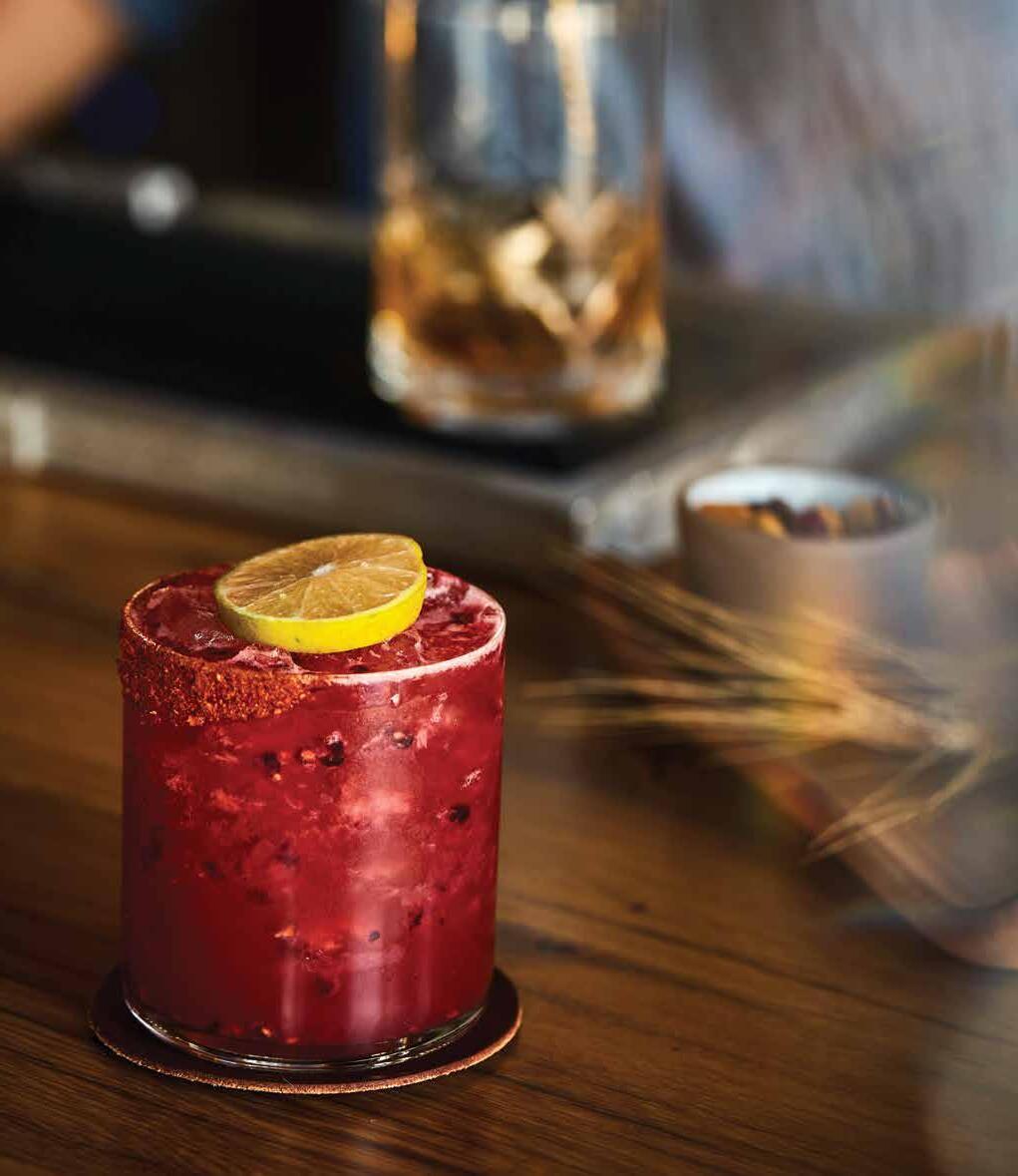
THE HORSE THIEF COCKTAIL
INGREDIENTS
1.5 oz Reposado Tequila
0.5 oz Green Chartreuse
0.5 oz High West Campfire Whiskey
0.5 oz Lime Juice
0.5 oz Ginger Syrup
4-5 Blackberries
RECIPE
Muddle blackberries in a shaker with ginger syrup.
Add remaining ingredients and ice. Shake to chill.
Half rim a rocks glass with Tajin spice.
Pour into glass and garnish with a lemon wheel.
Last Call
Created by the bar staff at The Lodge at Blue Sky, this spicy aperitif was inspired by its owner, Barb, and her courage. Read “The Horse Thief” on page 18.
Photo by Noe DeWitt.
AUBERGERESORTS.COM/STORIES




















 Join the World of Panerai
Join the World of Panerai











 Mauna Lani, Auberge Resorts Collection.
Photo by Blake Abes.
Mauna Lani, Auberge Resorts Collection.
Photo by Blake Abes.
 Susurros del Corazón, Auberge Resorts Collection.
Photo by Michael Persico.
Susurros del Corazón, Auberge Resorts Collection.
Photo by Michael Persico.
 PARK CITY / THE BIG ISLAND
Photo by Tim Aukshunas
PARK CITY / THE BIG ISLAND
Photo by Tim Aukshunas





 Right: Saving Gracie Director Melissa Smolik.
Right: Saving Gracie Director Melissa Smolik.



 Right: Saving Gracie Farrier Max Harris makes custom shoes for the horses at the Foundation, many of whom arrive with severe hoof issues.
Right: Saving Gracie Farrier Max Harris makes custom shoes for the horses at the Foundation, many of whom arrive with severe hoof issues.
 Photo by Patrick Brandenburg
Photo by Patrick Brandenburg

 Photo by Richard Schultz
Photo by Richard Schultz

 Previous page: Riding in the Remuda at Blue Sky, an impressive 35,000 square foot arena. Right: Barb Phillips on her property
Previous page: Riding in the Remuda at Blue Sky, an impressive 35,000 square foot arena. Right: Barb Phillips on her property


 Photo by Read McKendree
Photo by Read McKendree







 TEXT BY SARAH ROSE PHOTOS BY BLAKE ABES
TEXT BY SARAH ROSE PHOTOS BY BLAKE ABES










 NEWPORT / CONNECTICUT COUNTRYSIDE / SANTA FE
Photo by Jen Judge
NEWPORT / CONNECTICUT COUNTRYSIDE / SANTA FE
Photo by Jen Judge

 Nick Mele inside The Reserve Room at The Vanderbilt, Auberge Resorts Collection.
TEXT BY BRIAN MCMANUS
Nick Mele inside The Reserve Room at The Vanderbilt, Auberge Resorts Collection.
TEXT BY BRIAN MCMANUS
 Above: Mele poses in front of the Gilded Era Rosecliff mansion. Right: Nick Mele on the edge of town, on the hood of a vintage Mustang, provided by The Vanderbilt, Auberge Resorts Collection. Driving a classic car is an experience offered to guests of the hotel. Next page: Mele at Newport’s International Tennis Hall of Fame.
Above: Mele poses in front of the Gilded Era Rosecliff mansion. Right: Nick Mele on the edge of town, on the hood of a vintage Mustang, provided by The Vanderbilt, Auberge Resorts Collection. Driving a classic car is an experience offered to guests of the hotel. Next page: Mele at Newport’s International Tennis Hall of Fame.




 Left: Mele has a drink inside The Dining Room at The Vanderbilt. Above: A secret phone inside the hotel’s Reserve Room.
“Much like typewriters, old landlines have taken on something of a romantic quality, don’t you think?” asks Mele. Photo by Nick Mele.
Left: Mele has a drink inside The Dining Room at The Vanderbilt. Above: A secret phone inside the hotel’s Reserve Room.
“Much like typewriters, old landlines have taken on something of a romantic quality, don’t you think?” asks Mele. Photo by Nick Mele.
 Above: Nick Mele on the steps of The Vanderbilt in his beloved Newport, Rhode Island. From this vantage point he can see the home of his in-laws, who live a stone’s throw away. Right: Nick Mele in the mirror of The Dining Room at The Vanderbilt. Photo by Nick Mele.
Above: Nick Mele on the steps of The Vanderbilt in his beloved Newport, Rhode Island. From this vantage point he can see the home of his in-laws, who live a stone’s throw away. Right: Nick Mele in the mirror of The Dining Room at The Vanderbilt. Photo by Nick Mele.



 Left: Nick Mele unlocks the secret closet inside the The Vanderbilt’s Parlour.
Right: Mele is transported to another era via The Green Hour, an absinthe experience inside the Parlour.
Left: Nick Mele unlocks the secret closet inside the The Vanderbilt’s Parlour.
Right: Mele is transported to another era via The Green Hour, an absinthe experience inside the Parlour.

 Creative Director Wes Gordon (in black) at home in Connecticut with husband Paul Arnhold. Photo by Lindsay Thompson.
Creative Director Wes Gordon (in black) at home in Connecticut with husband Paul Arnhold. Photo by Lindsay Thompson.









 Above: Artist George Alexander Ofuskie at work. Right: Aritst Amy Denet Deal’s 4KINSHIP is the first and only indigenous-owned business on Santa Fe’s gallery-packed Canyon Road.
Above: Artist George Alexander Ofuskie at work. Right: Aritst Amy Denet Deal’s 4KINSHIP is the first and only indigenous-owned business on Santa Fe’s gallery-packed Canyon Road.



 Photo by Trevor Trevino
SANTA BARBARA / PUNTA DE MITA / ASPEN
Photo by Trevor Trevino
SANTA BARBARA / PUNTA DE MITA / ASPEN



 John Hoadley prepares to dive off his boat, Sol Rising, in search of delicate, delicious sea urchin.
John Hoadley prepares to dive off his boat, Sol Rising, in search of delicate, delicious sea urchin.








 Above: Rhoda Magbitang, executive chef of The Inn at Mattei’s Tavern, cracks open urchin for guests taking part in the hotel’s Art of Uni experience. Right: Chef Rhoda Magbitang’s Art of Uni experience at The Inn at Mattei’s Tavern, which features the delicacy prepared in three distinct and delicious ways, including uni toast with bacon jam and a translucent veil of torched lardo.
Above: Rhoda Magbitang, executive chef of The Inn at Mattei’s Tavern, cracks open urchin for guests taking part in the hotel’s Art of Uni experience. Right: Chef Rhoda Magbitang’s Art of Uni experience at The Inn at Mattei’s Tavern, which features the delicacy prepared in three distinct and delicious ways, including uni toast with bacon jam and a translucent veil of torched lardo.







 Agave hearts roast in an oven.
Agave hearts roast in an oven.
 The extreme heat of the oven can cause the seal to crack. If it does, it is patched over with mud.
The extreme heat of the oven can cause the seal to crack. If it does, it is patched over with mud.


 Above: La Reina raicilla in the glass, swirled like wine to release its aroma at Susurros del Corazón’s Origins of Raicilla. Right: Ana Lopez and Juan Pablo Mercado, the husband and wife founders of La Reina.
Above: La Reina raicilla in the glass, swirled like wine to release its aroma at Susurros del Corazón’s Origins of Raicilla. Right: Ana Lopez and Juan Pablo Mercado, the husband and wife founders of La Reina.



 Above: A cook preps for service at Prospect, the signature restaurant at Hotel Jerome, Auberge Resorts Collection. Right: The latest menu at Prospect, led by chef Connor Holdren, showcases a bounty of the Roaring Fork Valley and surrounding region, and includes Montrose beef short ribs, McClure red potatoes, Paonia Valley chicken and morels and Palisades plum.
Above: A cook preps for service at Prospect, the signature restaurant at Hotel Jerome, Auberge Resorts Collection. Right: The latest menu at Prospect, led by chef Connor Holdren, showcases a bounty of the Roaring Fork Valley and surrounding region, and includes Montrose beef short ribs, McClure red potatoes, Paonia Valley chicken and morels and Palisades plum.





 Above: The food at Aspen’s Bosq highlights a “sense of place,” says its executive chef Barclay Dodge, and features items like a mushroom quinoa cracker, grilled celeriac, duck liver mousse and lobster grilled over locally foraged juniper branches. Right: Chef Barclay Dodge.
Above: The food at Aspen’s Bosq highlights a “sense of place,” says its executive chef Barclay Dodge, and features items like a mushroom quinoa cracker, grilled celeriac, duck liver mousse and lobster grilled over locally foraged juniper branches. Right: Chef Barclay Dodge.


 HUDSON VALLEY / KIAWAH RIVER / UTAH / NAPA
Photo by William Kaner
HUDSON VALLEY / KIAWAH RIVER / UTAH / NAPA
Photo by William Kaner
 BY WILLIAM KANER
BY WILLIAM KANER





 Above and right: Accessories and furniture from Sawkille Co.
Above and right: Accessories and furniture from Sawkille Co.










 One of Lindroth’s most anticipated collaborations is her work with The Dunlin, Auberge Resorts Collection, a boutique hotel in the South Carolina Lowcountry on the Kiawah River. Left: A guestroom at The Dunlin. Above: Lindroth’s watercolor inspiration for the room.
One of Lindroth’s most anticipated collaborations is her work with The Dunlin, Auberge Resorts Collection, a boutique hotel in the South Carolina Lowcountry on the Kiawah River. Left: A guestroom at The Dunlin. Above: Lindroth’s watercolor inspiration for the room.






 PHOTOS BY TIM AUKSHUNAS
PHOTOS BY TIM AUKSHUNAS




 Above: Custom bikes are made based on the riders measurments. They choose a material (steel, titanium, carbon fiber) and custom colors. Left: Jeremy Sycip hard at work.
Above: Custom bikes are made based on the riders measurments. They choose a material (steel, titanium, carbon fiber) and custom colors. Left: Jeremy Sycip hard at work.



 Chileno Bay, Auberge Resorts Collection. Photo by Chad Wadsworth.
Chileno Bay, Auberge Resorts Collection. Photo by Chad Wadsworth.




 Above and right: Auberge’s newest Mexico property, Susurros del Corazón in Punta de Mita, stages stunning bluff-top and ocean-edge homes on the Bay of Banderas. Photos by The Ingalls.
Above and right: Auberge’s newest Mexico property, Susurros del Corazón in Punta de Mita, stages stunning bluff-top and ocean-edge homes on the Bay of Banderas. Photos by The Ingalls.


 Jeff Kelley enjoying the water in Chileno Bay.
Photo by Chad Wadsworth.
Jeff Kelley enjoying the water in Chileno Bay.
Photo by Chad Wadsworth.



 Wildflower Farms is featured in “Crafting Luxury,” about artisans living and creating in the Hudson Valley. Photo by Read McKendree.
Wildflower Farms is featured in “Crafting Luxury,” about artisans living and creating in the Hudson Valley. Photo by Read McKendree.
 Stanly Ranch, the bold next-generation escape, is featured in “Unexpected Napa.” Photo by The Ingalls.
Stanly Ranch, the bold next-generation escape, is featured in “Unexpected Napa.” Photo by The Ingalls.


 Read about Los Olivos’ legendary landmark, The Inn at Mattei’s Tavern, in “The Opulence of Edible Gold.” Photo by The Ingalls.
Read about Los Olivos’ legendary landmark, The Inn at Mattei’s Tavern, in “The Opulence of Edible Gold.” Photo by The Ingalls.
 Mauna Lani, a sacred oasis on the Big Island, as featured in “The Art of the Wave.” Photo by Nicole Franzen.
Mauna Lani, a sacred oasis on the Big Island, as featured in “The Art of the Wave.” Photo by Nicole Franzen.



 Hotel Jerome in Aspen, Colorado, is featured in “Dining Above the Clouds.” Photo by Noe DeWitt.
Hotel Jerome in Aspen, Colorado, is featured in “Dining Above the Clouds.” Photo by Noe DeWitt.


